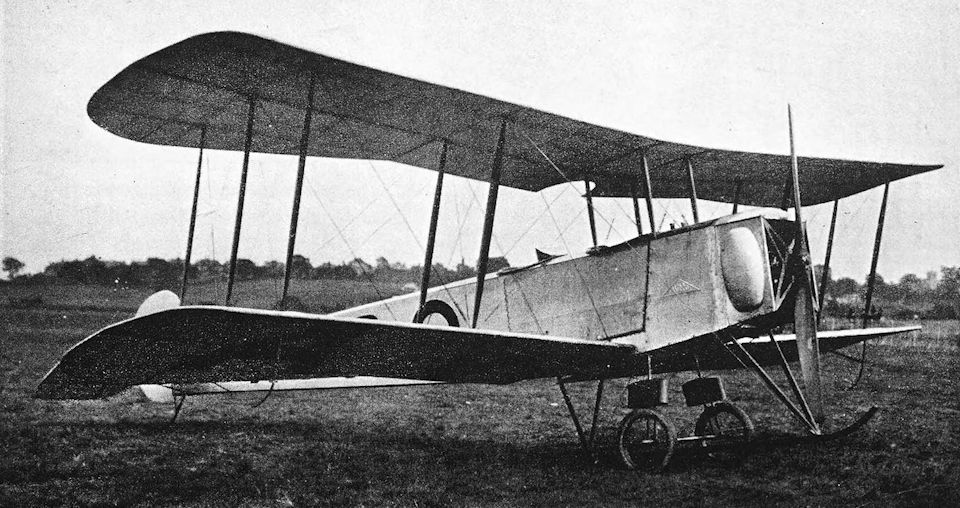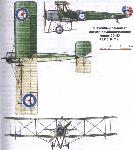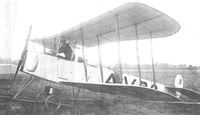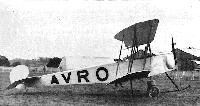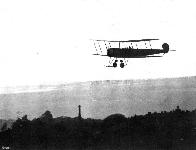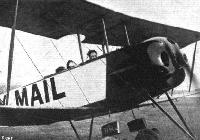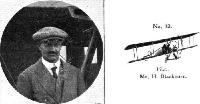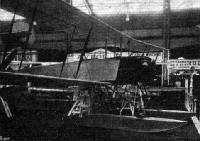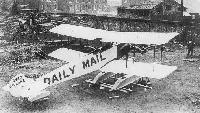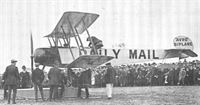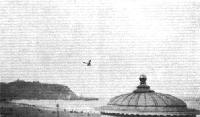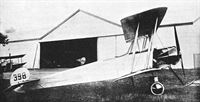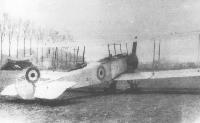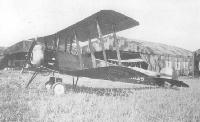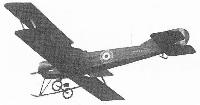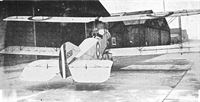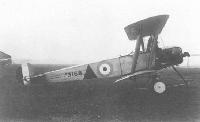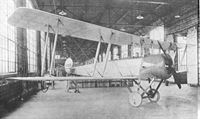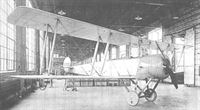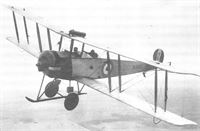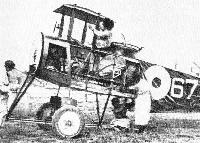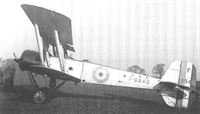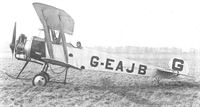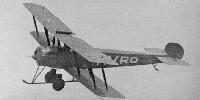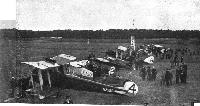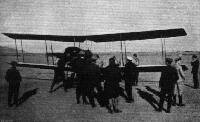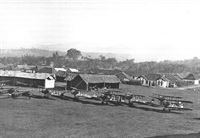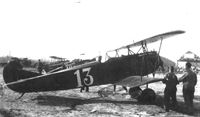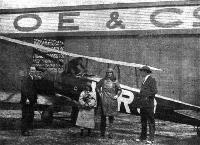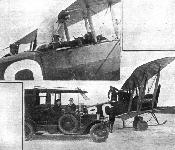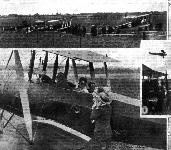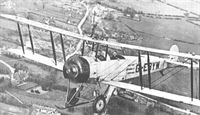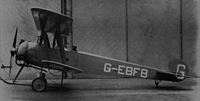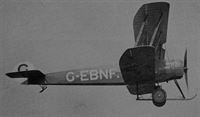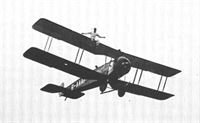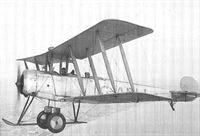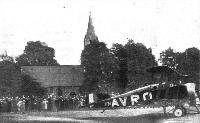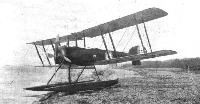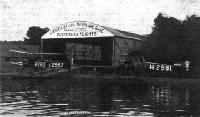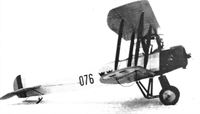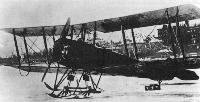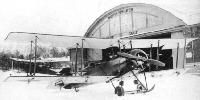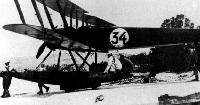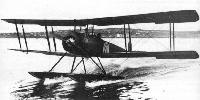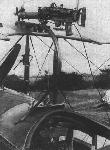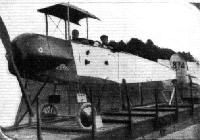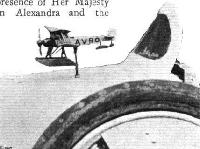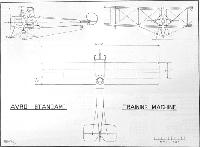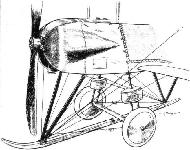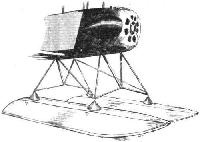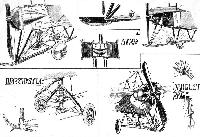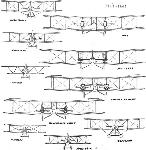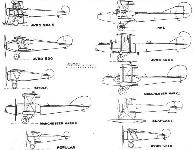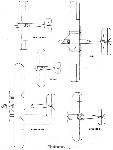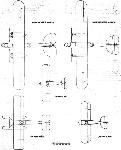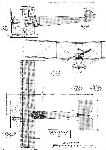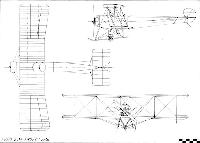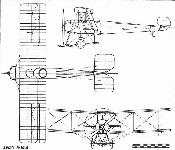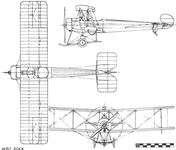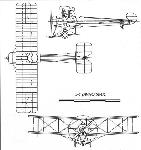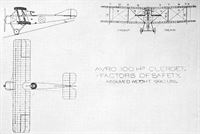В.Кондратьев Самолеты первой мировой войны
АВРО 504/504A/B/C/J/K / AVRO 504/504A/B/C/J/K
Цельнодеревянный двухстоечный биплан с полотняной обшивкой. Автор проекта - знаменитый британский авиаконструктор и предприниматель Эллиот Вердон Ро. Разработка машины начата в ноябре 1912 года. 18 марта 1913-го "Авро 504" совершил свой первый полет. Самолет продемонстрировал выдающиеся для своего времени летные данные. Благодаря хорошей устойчивости, управляемости и простоте пилотирования он вскоре стал наиболее распространенной в английской авиации учебной машиной. Но помимо учебного, "Авро 504" имел и боевое применение. В 1913 году RFC принял на вооружение 12 аппаратов, еще несколько десятков поступило в следующем году.
С началом первой мировой войны. 13 "пятьсот четвертых" отправили на западный фронт. 22 августа 1914 года в разведывательном полете один из них был сбит зенитным огнем, открыв таким образом счет боевых потерь британских Королевских ВВС. 21 ноября четыре "Авро" совершили первый в истории групповой бомбовый рейд на базу "Цеппелинов" в Фридрихсхафене. В начале 1915-го "Авро 504" перестали использовать для разведки и бомбардировки, оставив за ним функции учебно-тренировочной и связной машины. Выпускались также истребительная и патрульно-противолодочная модификации.
Всего до конца войны сдано 8340 "пятьсот четвертых", из которых 3696 на счету фирмы Авро. На момент подписания перемирия в частях RAF насчитывалось еще 2999 самолетов этого типа. Помимо Великобритании их строили в Австралии, Бельгии, Канаде, Японии, Египте и СССР. Советская копия "Авро 504К" под обозначением У-1 выпускалась в 1921-1922 годах на московском заводе ГАЗ №5, а с 1923 по 1931 - на ленинградском авиазаводе "Красный летчик". Всего построено 664 самолета, применявшихся в народном хозяйстве и летных школах до 1935 года.
В двадцатых годах большое количество "демобилизованных" "Авро 504" было распродано различным авиакомпаниям и частным лицам в десятках стран. Они летали в Дании, Китае, Финляндии, Индии, Ирландии, Новой Зеландии, Португалии, Испании, Швеции и т.д.
ОСНОВНЫЕ СЕРИЙНЫЕ МОДИФИКАЦИИ
"Авро 504" - двигатель "Гном", 80 л.с.
"Авро 504A" - усиленная конструкция крыльев и фюзеляжа.
"Авро 504B" - установлен киль и синхронный пулемет "Льюис".
"Авро 504C" - морской патрульный вариант для борьбы с дирижаблями. Установлен дополнительный топливный бак на 4 часа полета и пулемет "Льюис", стреляющий под углом 45° вверх.
"Авро 504J" - учебная модификация без вооружения. Мотор "Гном-моносупап", 100 л.с.
"Авро 504K" - самолет с универсальной моторамой, позволяющей устанавливать любые английские ротативные двигатели.
ЛЕТНО-ТЕХНИЧЕСКИЕ ХАРАКТЕРИСТИКИ
Размах, м 10,98
Длина, м 8,98
Площадь крыла, кв. м 30,70
Сухой вес, кг 558
Взлетный вес, кг 828
Скорость максимальная, км/ч 145
Время набора высоты, м/мин 1100/7
Потолок, м 3650
Показать полностью
А.Шепс Самолеты Первой мировой войны. Страны Антанты
"Авро-504" 1913 г.
Английский конструктор Эллиот Вердон Ро создал в 1910 году фирму "А.V. Roe & Co. Ltd." и после трех лет экспериментов подготовил к серийному производству новый учебный двухместный самолет "Авро-504". Машина оказалась очень удачной. Первоначальный заказ для военного министерства и адмиралтейства был вскоре увеличен, и к августу 1914 года в дивизионах "Ройал Флеинг Корпс" и "Ройал Нэви Эйр Сервис" было уже 63 машины. Всего с 1913 по 1933 год во всем мире построено около 10 тысяч машин всех модификаций, в том числе в Великобритании - 8340 самолетов, в СССР - около 800 самолетов (У-1 и МУ-1).
Самолет "Авро-504" - двухместный, двухстоечный биплан деревянной конструкции с довольно длинным фюзеляжем.
Фюзеляж прямоугольного сечения; выполнен из деревянных брусков, обтянутых полотном с растяжками из стальной проволоки или ленты. Полотно пропитывалось авиационным лаком. Крепление двигателя выполнялось из стальных труб и профилей. Капот двигателя изготавливался из алюминиевых листов.
Крылья трехлонжеронные. Лонжероны изготавливались из фрезерованных в форме двутавра брусков. Крыло обтягивалось полотном, которое крепилось к нервюрам, прошивалось и покрывалось лаком. Стойки бипланной коробки деревянные, каплевидного профиля. Растяжки из стального троса или ленты. Машины более поздних модификаций имели двухлонжеронное крыло с более мощными лонжеронами. Верхнее и нижнее крыло оборудовалось элеронами.
Руль направления небольших размеров без киля. Рули высоты и стабилизатор обычной конструкции. Стабилизатор дополнительно крепился подкосами. Шасси с резиновой амортизацией и противокапотажным ясеневьм брусом.
На самолете ставились 7- и 9-цилиндровые двигатели воздушного охлаждения, ротативные, звездообразные, разные на различных модификациях. Винт деревянный, двухлопастной.
Управление самолета тросовое, от ручки управления и педалей, причем в учебных машинах системой управления оборудовались обе кабины. На легких бомбардировщиках RFC и RNAS задняя кабина оборудовалась шкворневой установкой пулемета "Льюис". Под крылом подвешивались бомбы общей массой 37 кг.
На базе сухопутных вариантов "Авро-504" выпускались поплавковые варианты. Поплавки имели сложную конструкцию, они делались из тонких (4 мм) ясеневых досок в два слоя, закрепленных на каркасе из ясеневых брусьев. Между слоями досок прокладывалось полотно, пропитанное нетвердеющим лаком. Вся конструкция крепилась медными заклепками на алюминиевых шайбах и латунными шурупами.
Стойки поплавков - стальные трубы с деревянными обтекателями. Конструкция была очень трудоемкой и довольно тяжелой.
В СССР в начале 1920-х годов существенно упростили конструкцию поплавков. Они выполнялись выше ватерлинии из 4-5-мм фанеры, что уменьшило их массу с 211 кг до 170 кг без ущерба для их прочности, а также существенно удешевило производство.
Модификации
"Авро-504" - прототип с двигателем "Гном" (80 л. с.), учебный двухместный самолет. Выпущено несколько машин для аэроклубов.
"Авро-504B" - серийный учебный самолет с тем же двигателем для RFC и RNAS. Незначительные изменения в конструкции.
"Aвро-504C" - разведчик на базе предыдущего, с тем же двигателем, пилот размещался в задней кабине, наблюдатель - в передней.
"Авро-504E" - дальнейшее развитие серии "C. Отличался размещением пилота и наблюдателя, а также дополнительным усилением каркаса фюзеляжа. Двигатель "Гном-Моносупап" (100 л. с.).
"Авро-504G" - дальнейшее развитие машин этой серии, фюзеляж усилен продольными брусками. Крыло стало двухлонжеронным, изменился его профиль. Изменилась конструкция капота.
"Авро-504H" - самолет, оборудованный для старта с катапульты.
"Aвро-504J" - учебный самолет для RAF с двигателем "Гном-Моносупап" (100 л. с.). Обе кабины оборудованы системой управления. Построено 2267 машин этой модификации.
"Авро-504K" - массовая серия. Легкий бомбардировщик и разведчик, учебный самолет. Устанавливались двигатели "Гном-Моносупап" (100 л. с.), "Рон" (110 и 120 л. с.), "Клерже" (130 л. с.). Использовался иногда как истребитель.
"Aвро-504L" - поплавковый вариант самолета "Авро-504K", летные данные хуже, чем у сухопутного самолета.
У-1 - самолет первоначального обучения, строившийся в СССР с 1921 по 1932 год по образцу английского "Авро-504K". Отличался конструкционными материалами (сосна вместо ясеня и красного дерева, сталь вместо медного листа) и технологией изготовления. Двигатель М-2 (120 л. с.). При проверке на прочность испытания показали соответствие машины современным требованиям.
МУ-1 - поплавковый вариант самолета У-1 для авиации ВМС. Летные качества неплохие. Однако время виража и набора высоты было вдвое больше, чем у прототипа.
Самолеты У-1 и МУ-1 выпускались сначала на заводе № 5, а с 1923 года на заводе "Красный летчик".
В Англии снятые с вооружения машины переоборудовались в учебные как для военных летных школ, так и для аэроклубов. Некоторые машины эксплуатировались до 1933 года. В СССР самолеты У-1 эксплуатировались до 1935 года, пока не были заменены самолетами У-2 Н. Н. Поликарпова.
ЛЕТНО-ТЕХНИЧЕСКИЕ ХАРАКТЕРИСТИКИ
Авро-504 Авро-504Е Авро-504G Авро-504К Авро-504L У-1 МУ-1
прототип 1914г. 1915г. 1923г. 1925г.
1913г.
Размах, м 10,97 10,98 10,98 10,98 10,98 10,85 10,85
Длина, м 8,91 8,98 8,98 8,98 9,85 8,78 9,85
Высота, м 3,15 3,18 3,18 3,18 3, 3,18 3,58
Площадь крыла, кв.м 31,77 30,70 30,66 30,70 30,70 30,0 30,0
Сухой вес, кг 450 558 499 588 800 600 840
Взлетный вес, кг 703 828 816 828 1040 840 1080
Двигатель: "Гном" "Гном- "Рон" "Рон" М-2
Моносупап"
мощность, л. с. 80 100 120 110 120
Скорость максимальная, км/ч 132 140 132 145 132 137 136
Дальность полета, км 400 300 420 400 195 190
Потолок, м 3650 3960 4880 3500 4500 3200
Экипаж, чел. 2 2 2 2 2 2 2
Вооружение - 1 пулемет 1-2 пулемета - - -
37 кг бомб 37 кг бомб
Показать полностью
A.Jackson Avro Aircraft since 1908 (Putnam)
Avro 504 to Avro 504H
Design work on a successor to the Avro 500, begun at Brownsfield Mills in November 1912, was completed at the new Clifton Street works early the following year, Messrs Chadwick and Taylor being responsible for the fuselage and undercarriage and H. E. Broadsmith the wings. Designated Avro 504, it was very lightly constructed with a rectangular section, wire braced, box-girder fuselage built from four ash longerons channelled for lightness and strengthened by flanges. Cross struts were of spruce. For maximum view the pilot sat in the rear, the passenger occupying the front cockpit, from the corners of which four ash struts supported the centre section. Equal span, two bay wings were rigged with 2 ft stagger and braced by streamline section, hollow spruce interplane struts pin-jointed to the spars. Each wing panel consisted of five main ribs with spanwise stringers supporting a number of contour-forming strips of wood anchored to leading and trailing edges. Lateral control was by inversely tapered ailerons rigidly fixed at the inner end, the widened outer ends of which were warped by means of cables.
Although similar to that of the Avro 500, the undercarriage was a much improved and simplified unit. An ash skid was anchored to the fuselage by steel V struts as before, but the axle was no longer bolted to it and was no longer a laminated spring. Instead, a simple steel tube axle was used in conjunction with two main undercarriage legs having built-in rubber shock absorbers (8 ft 8 in of bungee cord wound round the two halves of the leg) in streamlined cases. The tail skid was attached to the bottom of a comma-type rudder.
In design, construction and performance the Avro 504 was considerably in advance of other 1913 types and benefited from the use of an improved wing section. Power was supplied by one of the new 80 hp Gnome rotaries (the actual power output of which is said to have been nearer 62 hp) installed in a square section cowling bulged on top and sides.
To give it the widest possible publicity the Avro 504 was entered for the 1913 Aerial Derby and consequently was built in considerable secrecy. Its arrival at Hendon on September 20, 1913, morning of the race, was therefore something of a sensation as it was obviously very fast and the impression of speed was heightened by its staggered mainplanes. When F. P. Raynham crossed the finishing line in fourth place at an average speed of 66-5 mph, few realised that the Avro 504 was virtually untried, having been delivered at Brooklands only three days before (September 17), and flown for the first time on the following day.
After the Aerial Derby the Blackburn Aeroplane and Motor Co Ltd issued a challenge to its Lancashire rivals and on September 29 Raynham flew the Avro 504 from Brooklands to Leeds for a race against a new Blackburn monoplane flown by Harold Blackburn. The 100 mile race was held on October 2 over a course starting and finishing at Leeds and passing over York, Doncaster, Sheffield and Barnsley. With H. V. Roe as passenger, Raynham flew neck and neck with Blackburn until bad visibility forced him to land near Barnsley.
Although basically a sound aeroplane the 504 needed modification and went back to the Manchester works where the engine mounting was changed for an improved version carrying more streamlined cowlings. Aileron control was also lightened by replacing the warping arrangement with constant chord hinged ailerons with wires to complete the circuit in place of the original rods. The wing structure was strengthened by replacing the hollow pin-jointed interplane struts by solid ones fitted in metal sockets. Redelivered at Brooklands at the end of October, the 504 was flown a great deal by Raynham during the following month. He made a forced landing at Horley with a broken carburettor control during the Hendon-Brighton-Hendon race on November 8; flew from Brooklands to Farnborough and back on November 15; gained second place in the Shell Trophy Race at Hendon the same afternoon and broke the lap record at 73 mph; spent a week on day and night flying at Shoreham and flew to Farnborough for official tests on November 24. With a passenger and fuel for three hours the Avro 504 clocked 80-9 mph over the measured mile and climbed to 1,000 ft in 1 min 45 sec.
An outstanding performance put up by Raynham on February 4 was a climb to 15,000 ft over Brooklands. This exceeded the existing British altitude record by almost 2,000 ft but was not an officially observed record. During the descent Raynham shut off his engine, put the machine into a glide, and 25 minutes later was at 5,000 ft over Hendon some 20 miles away. He then spiralled down to a landing, still without using his engine. Carrying R. J. MacGeagh Hurst in the front seat Raynham made an officially observed climb to a record height of 14,420 ft over Brooklands on February 10.
Later in the season the machine was purchased by the Daily Mail and toured the country giving passenger flights piloted by F. P. Raynham and G. Lusted. A. V. Roe and Co built an interchangeable twin float undercarriage so that the machine could be flown off the sea at coast resorts. At the same time the original 80 hp Gnome was replaced by an 80 hp Gnome Monosoupape which was supposed to give more power but which in fact gave only trouble. First flights as a seaplane took place at Paignton in April 1914, after which it visited Falmouth, Southport and Ireland, but when war was declared on August 4 the machine was at Shoreham where it was immediately commandeered. Two days later the career of this historic aeroplane ended when the engine failed as Raynham took off to deliver it to the RNAS. With no height in hand there was no alternative to putting the machine down on land where it was damaged beyond repair.
Series production of the Avro 504 began in the summer of 1913 when the War Office placed a contract for twelve machines. This brought about some restressing of the wings to comply with their strength requirements which included doubling the depth and width of the rear spar. Others were built for non-military and experimental purposes, one of which was exhibited at Belle Vue, Manchester, on January 1-3, 1914, and another, delivered at Brooklands on February 16, was fitted with the first Armstrong Whitworth-built 100 hp A.B.C. engine. After endless engine runs Raynham made what was possibly its only flight with this engine early in April. Drawings were also prepared for the installation of a 65 hp Austro-Daimler engine but as far as is known this scheme was shelved. A third Avro 504 was exhibited with rubber-sprung float undercarriage at the Olympia Aero Show in March 1914 and another was delivered to Harold Blackburn at Southport in July. In common with thousands of Avro 504 variants built in later years, these aircraft were noticeably different from the prototype because the top longerons sloped downwards aft of the cockpits to make the fuselage symmetrical in side elevation.
Two Avro 504s, almost the last of the twelve War Office machines, were delivered at Brooklands on June 5, 1914, and it was in one of these on June 12 that F. P. Raynham succeeded in looping a 504 for the first time. They were delivered next day to Farnborough where 376 (the first machine of the batch) was tested to destruction during July. A few Avro 504s were among the aircraft of No.5 Squadron RFC when it left for France on August 13, one of which became the first British aeroplane brought down by the Germans when Lts V. Waterfall and C. G. G. Bayly were hit by infantry fire in Belgium on August 22. In mid-October, 383, another Avro of the squadron was fitted with a Lewis gun by 2nd-Lt L. A. Strange whose gunner, Capt L. da C. Penn-Gaskell, strafed a troop train at Perenchies and forced down an Albatros two-seater near Neuve-Eglise a month later. Only a few Avro 504s saw front-line service and the greatest number in RFC squadrons in France at any one time was thirteen.
The Admiralty placed an order in the spring of 1914 for one Avro 504 and for six others a few months later. The first of these was delivered to the RNAS Eastchurch Squadron on November 27, 1914. Armed with four 16 lb bombs and piloted by Flt Sub-Lt R. H. Collet, an attempt to bomb the Bruges submarine depot on December 14 was foiled by bad visibility and an attack was made on the Ostend-Bruges railway instead. Very few offensive sorties were made by the Avro 504, the most ambitious being the brilliant and historic raid on the Zeppelin sheds at Friedrichshafen. A special flight of four machines formed at Manchester in October 1914 by Sqn Cdr P. Shepherd, was equipped to carry four 20 lb bombs per aircraft and shipped from Southampton to Le Havre. They arrived at Belfort by train on the night of November 13, 1914, and were hidden in a barn for fear of arousing the suspicions of local spies. It was not possible to flight test them and the first machine, 874, took off untried at 9.30 a.m. on November 21 piloted by Sqn Cdr E. Featherstone Briggs. Flt Cdr J. T. Babington then left in 875 followed by Flt Lt S. V. Sippe with five minutes separation in 873. Flt Sub-Lt R. P. Cannon’s machine 179 (the first Avro 504 built for the RNAS) broke its tail skid and could not go. The raiders followed the Rhine at 5,000 ft, crossed Lake Constance at 10 ft and put several bombs into the airship sheds from 1,200 ft. They narrowly missed destroying naval Zeppelin L.7 but hit the gas plant which exploded with considerable violence. Briggs was shot down but the others made the 125 mile return trip in safety after four hours in the air. Flown by Flt Lt H. L. Rosher, Sippe’s Avro 873 was one of five belonging to No.I Sqn RNAS which twice bombed Ostend and on March 24, 1915, destroyed two U-boats in an attack on the submarine depot near Antwerp. Together with 179 and 875, it survived to return to England for overhaul and transfer to school work. A pioneer Zeppelin interception was also made by an Avro 504 from RNAS Westgate piloted by Flt Sub-Lt Mulock who made contact with LZ.38 in the early hours of May 17, 1915. The airship climbed too rapidly for him to use his armament of two hand grenades and two incendiary bombs but later the same night the Avro 504 1009, piloted by Flt Cdr A. W. Bigsworth, pursued LZ.39 towards Ostend with more success. He managed to gain sufficient height to drop four 20 lb bombs on the airship’s stern and caused slight damage by fire which led to a heavy landing at Evere, Brussels.
When the Avro 504 was relegated to training, a duty it was destined to fulfil with distinction for over 15 years, A. V. Roe and Co designed and supplied a self contained dual control unit comprising seats, control columns and rudder bars. Later in 1915 converted machines were joined by a number specifically built as trainers, total Avro 504 production amounting to at least 88 aircraft. As the war progressed, modification gave rise to a series of variants. The Avro 504A, built for the RFC, was a strengthened version with wide-chord interplane struts and ailerons of reduced span. The lower wing roots were sometimes stripped of fabric to improve the downward view and 2905, delivered on January 17, 1916, was used at Farnborough for fabric tests. At least B3103 was fitted with an improved undercarriage having rear shock legs and front radius rods for use by the CFS Communications Flight at Lopscombe Corner, Salisbury, in 1918.
The Admiralty insisted on wing spars of greater cross section and was supplied with a drastically modified version known as the Avro 504B. It reverted to long-span ailerons and was identified by a large, unbalanced rudder hinged to a considerable dorsal fin. The top longerons were recessed to provide curved cut-outs in the sides of the rear cockpit. A stout ash tail skid, sprung with rubber cord and hinged to a pylon under the rear fuselage, became standard fitment on this and all subsequent 504 variants. A few RNAS Avro 504Bs were used operationally at Dunkirk, including 9890 and N5267 which had forward-firing guns and interrupter gear.
The majority of Avro 504Bs were naval trainers and late production models had the 80 hp Le Rhone, provision for Scarff ring and no cut-outs to the rear cockpit. At least one was used in early deck landing arrester gear experiments. In the coastal reconnaissance role the endurance was increased to 4 1/2 hours but this soon proved insufficient and 80 examples of a singleseat version having 8 hours endurance were built. Powered by an 80 hp Gnome and known as the Avro 504C, it had a large cylindrical fuel tank in place of the front cockpit and a gap in the top centre section through which a Lewis gun could fire incendiary ammunition upward at an angle of 45 degrees. The RFC equivalent, conceived in 1915 under the designation Avro 504D, retained the balanced comma-type rudder and short-span ailerons, but had the recessed longerons and wing root modifications of the Avro 504C. Only six 504Ds were built and delivery began in August 1915.
Modification on this scale led to a severe weight penalty and additional power had become a dire necessity. The next RNAS variant, the Avro 504E, was therefore fitted with the 100 hp Gnome Monosoupape. At the same time the rear cockpit was moved farther aft and the change of C.G. position caused by installing the main fuel tank between the cockpits was counteracted by reducing the stagger from 24 to 9 in. Centre section struts were then repositioned to converge towards the top in side elevation. The 504E also reverted to the straight top longerons of the prototype but was fitted with the fin, rudder and ailerons of the 504B. Ten were built, some of which were used at Chingford and Fairlop and one at Cranwell.
Designation Avro 504F was given to a single Avro 504C, 8603, fitted at the suggestion of the Admiralty with a 75 hp Rolls-Royce Hawk six-cylinder in-line engine. It was evidently an unsuccessful union as a contract for 30 Avro 504F aircraft was cancelled and replaced by one for the 80 hp Gnome version.
Designation Avro 504G was used by the RNAS for the 80 hp Gnome-powered Avro 504B conversions having racks for practice bombs, synchronised front Vickers guns and a Scarff ring for a Lewis gun on the rear cockpit.
Last of the early exploratory variants was the 504H, a strengthened 504C fitted under the supervision of Sqn Cdr E. H. Dunning in 1917 with catapult pick-up points and a special padded seat. Piloted by Flt Cdr R. E. Penny this machine later became one of the first aircraft successfully launched by catapult.
At this stage of the war orders for the several variants were far in excess of production capacity at Manchester and a number of sub-contractors were brought in as listed in the data section.
SPECIFICATION AND DATA
Manufacturers:
A. V. Roc and Co. Ltd., Clifton Street, Miles Platting, Manchester
The Bleriot & Spad Aircraft Works, Addlestone, Surrey
The Brush Electrical Engineering Co. Ltd., Loughborough
The Eastbourne Aviation Co. Ltd., Eastbourne
The Humber Motor Co. Ltd., Coventry
Parnall and Sons, Mivart Street, Eastville, Bristol
The Regent Carriage Co. Ltd., Fulham, London
S. E. Saunders Ltd., East Cowes, Isle of Wight
The Sunbeam Motor Car Co. Ltd., Wolverhampton
Power Plants:
(Prototype)
80 h.p. Gnome
80 h.p. Gnome Monosoupape
(Avro 504 and 504A)
80 h.p. Gnome
80 h.p. Le Rhone
100 h.p. A.B.C.
(Avro 504B)
80 h.p. Gnome
80 h.p. Le Rhone
(Avro 504C and 504D) 80 h.p. Gnome
(Avro 504E) 100 h.p. Gnome Monosoupape
(Avro 504F) 75 h.p. Rolls-Royce Hawk
(Avro 504G and 504H) 80 h.p. Gnome
Dimensions:
Span 36 ft. 0 in. Length 29 ft. 5 in.
Height 10 ft. 5 in. Wing area 330 sq. ft.
Weights and Performances:
Prototype Avro 504 landplane seaplane Avro 504A Le Rhone
Tare weight - 924 lb. 1,070 lb. 1,050 lb.
All-up weight 1,550 lb. 1,574 lb. 1,719 lb. 1,700 lb
Maximum speed 81 m.p.h. 82 m.p.h. 75 m.p.h. 86 m.p.h.
Climb to 3,500 ft. 7 min.* - - 7 min.**
Endurance 3 hours - - 4 1/2 hours***
*With 80 h.p. Gnome Monosoupape.
**With 80 h.p. Gnome 9 min. 30 sec.
***With Avro 504C and 504D 8 hours.
Avro 504J and Avro 504K
In the autumn of 1916 a more powerful version of the Avro 504A with the 100 hp Gnome Monosoupape was produced for the RFC. This variant, designated 504J and known in the RFC as the ‘Mono Avro’, was externally identical with the earlier type and large numbers ordered as 504As were completed as 504Js.
Among the first recipients of the Avro 504J was the School of Special Flying founded at Gosport in July 1917 by Maj R. R. Smith-Barry. Here (and later at similar schools at Shoreham, Lilbourne, Redcar, Ayr and Curragh) instructors were introduced to Smith-Barry’s revolutionary flying training technique, a system based on demonstration and explanation by an instructor who was in verbal communication with the pupil. The ‘Gosport’ speaking tubes specially designed for this purpose were still to be found in club aircraft half a century later. The Avro 504J was fully aerobatic and made an ideal training aircraft because its light and powerful controls quickly showed up faults in a pupil’s flying. It is now historically important as the aeroplane which made possible a system of training which, in modified form, became part of the RAF’s Flying Training School syllabus for more than 40 years. As the standard RFC trainer, the Avro 504J was ordered in such quantity that contracts were placed with additional sub-contractors. Components for Avro-built machines were constructed in Manchester for erection at the company’s new aerodrome at Hamble.
In his memoirs C. A. Nepean Bishop recalls that the Gosport School Avro 504J C4448 was the personal machine of Capt Williams whose favourite trick was to land between the hangars, touch down on the tarmac, swing completely round and finish the landing run inside ‘C’ Flight hangar. Among other Gosport instructors were Maj E. L. Foot who was to become well known as airline, test and sporting pilot in the years immediately after the War, and Capt Duncan Davis, manager of Avro’s South Coast joyriding aircraft in 1919-20 and CFI of the Brooklands School of Flying in the 1930s. A distinguished pupil was HRH Prince Albert (later King George VI) who learned to fly on C4451. In 1918 a team of instructors took four Mono Avros across the Channel to demonstrate the Gosport system to the French.
By the end of 1917 the 100 hp Gnome Monosoupape was outmoded as a front line powerplant and British production of this engine was allowed to tail off. To prevent interruption of Avro 504J production through engine shortage, all surplus rotaries, including 80 hp and 110 hp Le Rhones as well as 130 hp Clergets, were collected from English and French aerodromes. There was no difficulty in fitting the 80 hp Le Rhone and a number of 504Js were thus powered, but it was necessary to modify the front fuselage before larger engines could be installed. Following the trial installation of a 130 hp Clerget in B3157 for Smith-Barry at Gosport at the end of 1917, the Technical Dept of the Air Board asked A. V. Roe and Co to produce adaptors and a new type of universal engine mounting. In the older machines this was of the two bearer type, the front bearer being in the form of a ball race supported on four tubular arms forming extensions to the fuselage longerons. This ‘spider’ was now replaced by an overhung mounting designed by H. E. Broadsmith which consisted of two bearer plates which would accept any suitable engine and allow the use of a smooth open fronted cowling. Irrespective of the type of engine fitted, aircraft built with this mounting were known as the Avro 504K, even though many had been ordered as 504Js or even 504As as shown in the table on page 61. The original ‘Clerget Avro’ B3157 joined ‘F’ Flight, School of Special Flying, and crashed at Gosport on March 2, 1918.
With standardisation accomplished the way was clear for greatly increased production and the Avro company was authorised to plan the construction of 100 machines a week, plus spares. They were also required to produce 20 sets of knock down parts per week for assembly at the Eastern Aircraft Factory at Aboukir, Egypt and by the Armistice production had reached eighty Avro 504Ks a week, including twenty sets of components for Aboukir.
As a result of demonstration flights over Washington by Avro 504J C4312 imported by the British Mission under Col Lee in the winter of 1917-18, fifty-two Le Rhone engined 504Ks were purchased by the Americans in July 1918. These were used by the AEF for advanced training at No.3 Instruction Centre, Issoudun, France, and after the War survivors were shipped to the USA, where one or two still exist.
Major modification of the Avro 504J was confined to the fitting of shortspan, single-bay wings and curved fin to B4264 at Gosport in January 1918. Standard 36 ft mainplanes were eventually replaced, rigged experimentally with the gap reduced from 5 ft 6 in to 5 ft 1 1/4in. In March 1918 the same set of short-span wings was fitted temporarily to B3155, a two-seater with shortened fuselage and armed with a Lewis gun. In the following May it flew as a single-seater with the fuel tank in the front cockpit, and this led logically to the first of a number of 110 hp Le Rhone engined single-seat 504Ks for high altitude work with Home Defence Squadrons in the north of England. These had the gravity tank repositioned to port to make way for a Lewis gun on the top centre section, and with front cockpit faired in could reach 18,000 ft. Some were fitted later with a low drag V-type undercarriage similar to that of the Avro 521. Two so modified were flown at Gosport - C605 with 130 hp Clerget on June 15, 1918 and C604 with Le Rhone on February 3, 1919.
Total wartime production of Avro 504s of all marks exceeded that of any other type of British aeroplane but the oft quoted figure of 8,340 aircraft (3,696 by A. V. Roe and 4,644 by sub-contractors) is obviously in excess of the actual total. Nine were delivered to the Expeditionary Force in France in 1914; 4,771 to training units; 274 to Home Defence Units; 392 to the Middle East Brigade and 52 to the Americans. When the RFC and RNAS came under unified command on April 1, 1918, Avro 504Js and Ks were in use with almost every Service unit in Britain so that on October 31, 1918, there were 2,999 on RAF charge (including 2,267 at flying schools and 226 on Home Defence). One hundred and eleven were in Egypt and Palestine, where some were pressed into emergency air mail service during the Egyptian rising of March-April 1919.
In 1919 the Sunbeam Motor Co, sub-contractor for the Avro 504B, J and K, fitted one of its 100 hp water-cooled Dyak airship engines into a 504K airframe. With brass nose radiator and attendant plumbing it was a heavy powerplant which substantially reduced payload. Conversions were consequently few but two were supplied to Norway in 1920 and several were built for civil use with the Dyak engine in Australia in 1922.
The Royal Aircraft Establishment found the 504K a most useful test vehicle in the years immediately after the war, and each of Farnborough’s resident machines was used for a wide variety of experimental flying. One important phase was flight testing a number of wings designed by Boulton and Paul, Humber, Vickers and the Steel Wing Company with metal spars and/or ribs. The metal wing programme was initiated partly through timber shortage but chiefly because seemingly identical wooden spars varied considerably in strength and weight. Minor experimental devices flown on the 504Ks ranged from a Leitner-Watts metal airscrew to a windmill-driven clear vision rotating windscreen.
A postwar gunnery trainer version of the Avro 504K (130 hp Clerget) was designated Avro 540 but differed from standard only in the region of the rear cockpit which was strengthened and built up to take a Scarff mounting for a rear gunner. There was no new production, the few that existed being converted 504Ks.
Of greater importance was the 504K’s contribution to low speed flying research in the course of which H2402 was fitted with a V-type undercarriage, water ballast tanks near the C.G. and in the tail, as well as an immense fin and unbalanced rudder. Eleven gallons of water could be pumped into the rear tank in the air to enable the aircraft to fly at very large angles of incidence (up to 35 degrees) with the object of exploring controllability in stalled flight and so reduce the risk of hitting the ground in a nose-down attitude as described in R. & M. 991. In the event, H2402 experienced almost uncontrollable longitudinal oscillations and a second machine, F8940, with similar undercarriage, fin and rudder, was flown with variable-incidence tailplane and lead weights up to 80 lb over the tail skid. Large range differential ailerons allowing upward angles in excess of 90 degrees and interconnected with leading-edge slots, were actuated by a wheel mounted on the control column. Research also embraced balanced ailerons mounted at mid-gap and concluded with flight tests by E3269 equipped with Handley Page slots inter-connected with Frise-type balanced ailerons. This aircraft was demonstrated sensationally by F/Lt P. W. S. Bulman at Farnborough on April 15, 1925. A list of the main experimental machines appears in the data section.
The 504Js were declared obsolete in September 1921 but the 504K remained in service as the standard RAF trainer with the CFS and Nos.1, 2, 3, 4 and 5 Flying Training Schools until the late 1920s. It also served with No. 24 (Communications) Squadron; with Nos.600, 601, 602 and 603 Auxiliary Air Force Squadrons; and with Fleet Air Arm training units at Netheravon and Leuchars. It took part in Hendon RAF Displays, beginning in 1920 when F/O Quinland cavorted ‘L’Avro Comique’ B3292 with extra large four-speed and reverse gear-box, be-cobwebbed undercarriage, vacuum cleaner, anchor, kettle, flue pipe, jazz painted interplane struts and four dummy heads! The Display of July 3, 1921 included a standard Avro race won for Kenley by F/O P. Murgatroyd who won again in the following year while representing Cranwell. Crazy flying by F/Lt Jack Noakes in 1921 and F/Lt W. H. Longton in 1922 brought congratulations from King George V. The Avro 504K made its final appearance in a star role in 1923 as the ‘Orva Mayfly’, which paraded in front of the crowd with ‘A.B.C. Lion’ engine, wireless clothes line, kettle, chimney, six-inch gun and carrot accelerator!
The last Avro 504Ks, built by A. V. Roe to Contract 707157/26, appeared in two batches. The first 40, delivery of which was completed on November 11, 1926, were followed by 10 delivered by January 17, 1927.
In 1990 three Avro 504Ks survived in the United Kingdom in military markings, D7560, fitted with the wings of E3104, property of the Science Museum, London, was on permanent exhibition. The Royal Aeronautical Society’s G-ABAA painted as H2311 was undergoing restoration for display at the Greater Manchester Museum of Science and Industry and the Shuttleworth Collection’s H5199, which had previously carried the fictitious marks E3404, was airworthy at Old Warden.
G-ABAA which was flown from Scotland by F/Lt Birch to join the Nash Collection at Brooklands in 1938 was overhauled by A. V. Roe and Co for the Royal Aeronautical Society in 1950 and flown at the Farnborough RAF display by Gp Capt L. S. Snaith in July of that year. After a period in store at Hendon and London Airport, it was transferred to Upavon in 1962 and was later held in store at Henlow before being transferred to Manchester. The Shuttleworth machine, c/n R3/LE/61400, which had been stored for many years at Old Warden was rebuilt by apprentices at the Chadderton works of A. V. Roe and flew again in 1955. It later took part in the film Reach for the Sky.
SPECIFICATION AND DATA
Manufacturers:
A. V. Roe and Co Ltd, Park Works, Newton Heath, Manchester; and Hamble Aerodrome, near Southampton, Hants.
Australian Aircraft and Engineering Co Ltd, Sydney, NSW, Australia
The Brush Electrical Engineering Co Ltd, Loughborough
Canadian Aeroplanes Ltd, Toronto, Canada
The Eastbourne Aviation Co Ltd, Eastbourne
The Grahame-White Aviation Co Ltd, Hendon Aerodrome, London, N.W.9
Harland and Wolff Ltd, Belfast
The Henderson Scottish Aviation Factory, Aberdeen
Hewlett and Blondeau Ltd, Oak Road, Leagrave, Luton, Beds.
The Humber Motor Co Ltd, Coventry
Morgan and Co, Leighton Buzzard, Beds.
Nakajima Hikoki Seisaku Sho, Ohta-Machi, Tokyo, Japan
Parnall and Sons, Mivart Street, Eastville, Bristol
Frederick Sage and Co Ltd, Peterborough and London
S. E. Saunders Ltd, East Cowes, Isle of Wight
Savages Ltd, King’s Lynn, Norfolk
Societe Anonyme Beige de Constructions Aeronautiques, Haren, Brussels, Belgium
The Sunbeam Motor Car Co Ltd, Wolverhampton
Yokosuka Naval Arsenal, Japan
Powerplants:
(Avro 504J)
One 80 hp Le Rhone
One 100 hp Gnome Monosoupape
(Avro 504K)
One 90 hp RAF.1A
One 100 hp Gnome Monosoupape
One 90 hp Thulin
One 100 hp Curtiss K.6
One 100 hp Sunbeam Dyak
One 110 hp Le Rhone
One 130 hp Clerget
One 150 hp Bentley B.R.l
One 170 hp A.B.C. Wasp I
One 220 hp Hispano-Suiza
Dimensions:
Span 36 ft 0 in
Length (rotary engines) 29 ft 5 in (Dyak) 28 ft 11 in
Height 10 ft 5 in
Wing area 330 sq ft
Weights and Performances (Avro 504K):
100 hp Gnome Monosoupape 110 hp Le Rhone 100 hp Dyak
Tare weight 1,100 lb 1,231 lb 1,320 lb
All-up weight 1,800 lb 1,829 lb 1,857 lb**
Maximum speed 82 mph* 95 mph 70 mph
Cruising speed - 75 mph -
Climb to 8,000 ft - 6-5 min -
Service ceiling 13,000 ft 16,000 ft -
Endurance 3 hours 3 hours 2 3/4 hours
Range - 250 miles
*At 6,500 ft
**2,400 lb with 220 hp Hispano-Suiza.
Experimental Avro 504Ks used at the RAE, Farnborough:
D8837 Used for static strength tests prior to 3.19
D9068 The ‘fireproof’ Avro, fitted with 170 hp A.B.C. Wasp and flown 19.2.20 to 3.6.20 when crankshaft failed. Flown again 28.9.22.
E3269 CTE petrol control valve tests 9.18; metal (including Vickers) wing tests 4.7.19 to 1.6.20; turn indicator tests 5.20; plug, fuel, temperature and Tampier Needle/Bloctube carburettor tests by C Flight up to 6.22; further steel wing tests 8.22; lateral control at low speeds until 2.5.25
E3621 Steel spar tests commenced 20.5.19, destroyed 14.7.19 in fatal air collision over Farnborough with S.E.5A D7014
F2234 Stall indicator, Holt flare, navigation light and Adamchick undercarriage tests 11.6.23 to 24.4.25
F8857 Parachute tests 2.7.19 to 3.11.19; turn indicator tests 13.1.20; accident taking off from Laffan’s Plain 16.1.20
F8940 Steel wing and accelerometer tests 28.7.21 to 11.21; low speed lateral control tests up to 8.22; F/O Bouchier flew it in landing contest, Hendon 29.6.22; automatic control recorder tests from 11.8.22; airscrew tests 4.23
H2202 From Martlesham 28.7.22 for Tampier needle/Bloctube carburettor tests by Engine Research Flt, left for Kenley 18.12.22
H2214 Leitner-Watts steel airscrew tests, commencing with ground runs 20. 9.21; lateral control tests 8.22; automatic control recorder tests 15.9.22 to 20.6.23; lateral control movement recorder tests from 26.6.24
H2365 To Wireless and Photographic Fit 17.6.24 for short wave telephony and night flying equipment trials to at least 7.2.25
H2402 Steel wing tests 22.1.19 to 1.3.20; revolving clear view windscreen tests 10.11.20 to 1.12.20; instrument, control column force recording, accelerometer, low speed lateral control, fuel pump, Mk.IV sextant and clinometer tests by A Flight up to 8.22; undercarriage collapsed
18.3.25
J7555 Two Avro 504Ks A 101 and A 102, equipped with Sperry Mark A and gyroscopes and radio control gear, were acquired 8.24 from the Sperry
J7556 Gyroscope Co, New York. To the RAE Instrument Flt 1.11.24 for research into automatically controlled flight. The aircraft were re-serialed J7555 and J7556 though only the latter was used; flown on six occasions 3.25 to 12.26.
Avro 504K (civil)
The vast armada of Avro 504Ks rendered surplus by the 1918 Armistice included not only wartime training veterans but also large batches of new machines at storage units or still in the factories. An offer by A. V. Roe and Co to repurchase them en bloc was refused on the grounds that the Disposal Board found it impossible to compute the precise number of saleable aircraft. Sales therefore began by public auction at No.1 Aircraft Salvage Depot, Hendon, but in 1920 Handley Page Ltd bought all Disposal Board stocks and the 504Ks were thereafter marketed by its subsidiary, the Aircraft Disposal Co Ltd of Croydon. Trade was brisk despite the late G. P. Olley’s forced landing on March 31, 1920, in Southwark Park pond in the company’s demonstrator G-EAHW (130 hp Clerget). Foreign and Commonwealth governments made considerable inroads into stocks but even greater numbers were sold for civilian use. Low first cost and a seemingly endless spares backing, made the Avro 504K the only military aircraft of the period to find lasting favour as a civil type. Between 1919 and 1930 over 300 were allotted civil registrations in Britain alone and before the advent of the D.H. Moth in 1926 the Avro 504K was the most common British aeroplane. The majority had the dual controls removed and the decking cut away to make room for a third seat but a few were used for flying instruction and the total included a number ferried abroad in temporary civil marks.
Civil flying was sanctioned in Britain at Easter 1919, a memorable Bank Holiday when A. V. Roe’s immortal trainer embarked on an even greater career as a pleasure trip machine. Its usefulness extended over two decades and its name will be linked for ever with the halcyon days of itinerant joyriding, the story of which falls into four clearly defined periods.
Excited by the deeds of great wartime pilots, the public developed a thirst for flying which earned every airworthy 504K a handsome living for the rest of 1919. Despite an ambitious essay into organised pleasure flying by the Avro company, lesser concerns also made a great deal of money, particularly in Scotland. Quick to fill the gap when Avro withdrew from the business in 1920, many former RAF pilots bought 504Ks in the hope of reaping similar rewards but over 50 such mushroom enterprises were ended within the year by the trade slump. The third period, which lasted until the end of the decade, saw Avro pleasure flight business reduced to a number of old established firms run by a handful of seasoned pilots whose lives were dedicated to the game. Their eventual absorption into the great air displays of the 1930s brought the career of the 504K to an end as it had begun, in organised joy flying on the grand scale.
Genesis
A. V. Roe and Co started operations at Hamble at Easter 1919 with three Avro 504Ks (100 hp Gnome Monosoupape) in military marks. Piloted by G. L. P. Henderson, H. A. Hamersley, F. Warren Merriam and others, they carried 359 passengers at £1 a head on the first day! Some 3 1/2 weeks later the Avro Transport Company was set up to run a daily return service between Alexandra Park, Manchester and Blackpool Sands via Southport. The inaugural flight, made on May 24 by four 3-seat 504Ks (110 hp Le Rhone), carried Avro director John Lord and a selection of civic dignitaries. During the 18 1/2 week life of the service, bad weather only prevented 28 of the 222 scheduled flights and when the route closed for the winter (and for ever) on September 30, 8,730 miles had been flown without a forced landing.
Inspired by results at Hamble, the Avro Transport Company launched a nation-wide joyriding programme and put G. L. P. Henderson in charge. As prelude to this assignment he flew a brand new 504K (110 hp Le Rhone) H2586/G-EAEV into 6th place in the Aerial Derby at Hendon on June 21, 1919, at an average speed of 75-22 mph. Leading pilots of the day whom he had appointed to take charge of ‘Southern Area’ operations were already hard at it at Hounslow Heath (Maj A. G. Taylor); Manston (Capt Duncan Davis); Southsea/Eastney (F/Lt E. A. Sullock); Weston-super-Mare sands (Capt D. G. Westgarth-Heslam); Brighton/Patcham/Blatchington Farm (Capt D. I. M. Kennard); Swansea/Brynmill (F. G. M. Sparks); and Porthcawl (Capt E. D. C. Herne). The ‘Northern Stations’ were Blackpool South Shore (Capt W. G. R. Hinchliffe); Southport/Birkdale Sands (Capt Collison); Fleetwood/Scale Hall and Morecambe Sands (Lt Macrae); Rhyl (Capt E. Maitland Heriot); Liverpool/Waterloo Sands (machines diverted from the Manchester-Blackpool service on Wednesdays and Saturdays); Man Chester/Alexandra Park (Lt-Col G. L. P. Henderson); and Isle of Man/Douglas Promenade/Ramsay (Lt G. B. Moxon). Avro 504L seaplanes and Avro 536 five seaters were also used as detailed in their own chapters.
During Wakes Weeks, industrial workers, coal miners and the like spent lavishly on longer flights, looping and inverted flying and by August 1 over 10,000 passengers had been carried at Blackpool alone. Similar figures were returned at Southport where flying often continued by moonlight and one woman passenger had 15 stunt flights within a week. In mid-August a gale of unprecedented fury struck the coast, wrought havoc among Avros pegged down with sandbags on the beaches and reduced the number in service on August 31 to 17.
At Hounslow Heath where 6,400 passengers were carried during the season, Avro 504K E3289/G-EAAM and Avro 536 K-105/G-EAAP were chartered by the Evening Standard in July for daily newspaper flights to Brighton and Southsea. Another made an incredible eight hour flight from Perth to Hounslow on August 12 with 60 brace of grouse.
Let by G-EAIH, ’II and ’IJ which left the Manchester works on July 28, 1919, nine Avros (including G-EAJQ, 'JU, a 536 and two 504Ls) attended the First Air Traffic Exhibition at Amsterdam in August 1919. A sustained demand for joy flights kept them in the Netherlands and the last two did not arrive back at Lympne until January 3, 1920. Meanwhile a rail strike in Britain had brought almost the entire fleet to Hounslow to convey passengers, newspapers, films and light freight to the provinces. The return flights were offered as a daily service to London and once again demand was far in excess of available seats. When petrol restrictions brought the season to an end the Avro Transport Company had carried over 30,000 people and flown the equivalent of 12 1/2 circuits of the earth. The craze for flying bordered on hysteria. Garden parties without a 504K were considered unfashionable and the Swansea machine was frequently ‘detached’ to the Abernant Hotel, Llanwrtyd Wells, for this purpose, and when the Town Crier flew over Swansea ringing his bell in flight, the local police could hardly control the resultant crowd of would-be aviators.
Hounslow was not the only 504K pitch in the London area. Prewar premises were reopened at Hendon by the Grahame-White Aviation Co Ltd as the London Flying Club, a centre of fashionable society equipped with 12 Avro 504Ks acquired from the nearby Salvage Depot. Painted in carroty pink, they carried enlarged versions of their RAF serials until full civil markings on white rectangles were applied some months later. Instruction was available and an attempt was made to revive Saturday afternoon pylon racing but the Avros were engaged mainly on joy flights, 5,100 tickets being sold in the public enclosures that season. They also carried the Daily Mirror to the Midlands during the railway strike but the concern degenerated into a country club and flying ceased at the end of 1920. Across the road at Stag Lane, the London and Provincial Aviation Co Ltd used a single machine, G-EABT, which was later flown at Yarmouth by T. Neville Stack and George Lusted. An eight-strong fleet (110 hp Le Rhone engines), flown at Northolt by the Central Aircraft Co Ltd included G-EAGI fitted with the V-strut undercarriage of the Home Defence fighter variant. When the firm closed in 1921, chief pilot Herbert Sykes left to continue Avro joyriding on his own account at Kingsbury, Middlesex, with tours in the Midlands each summer, each of his machines being appropriately named Psyche in turn.
Vickers Ltd opened south of the Thames with G-EACV, ’DS, ’EY and ’EZ at Joyce Green, Kent. Two of these did a roaring trade at Kings Heath, Birmingham, in August and on October 10 another, piloted by Capt Simpson, made commercial aviation history by carrying 333 lb of tinned fish from Newcastle to Turnhouse. Croydon figured as an Avro ‘pitch’ from August 1919 when Aircraft Transport and Travel Ltd started joyriding with G-EAIO - ’IS and Sir Philip Sassoon, who was just about the first owner of a private 504K, commuted to and from Lympne in G-EANN.
Coastal resorts outside the Avro company’s network were served in 1919-20 by the Eastbourne Aviation Co Ltd with 504L seaplanes and two 504Ks; by the Bournemouth Aviation Co Ltd with five; and by the Navarro Aviation Co Ltd with three. The Bournemouth outfit ran a service to Weymouth and worked inland towns as far as Bath, while Navarro’s machines G-EADY, ’EA, ’EB and ’JP enjoyed lucrative seasons at Southend and Whitstable. Among the first concerns to offer flying instruction was the Cambridge School of Flying Ltd of Hardwick to which record crowds were drawn by F. J. Ottweiler’s aerobatics in E3501/G-EAEC in August 1919. Their other machine E4118/G-EAHL did good business at Hunstanton and during August and September 1919 two new Humber-built 504Ks G- EAGV and ’GIF ran a Harrogate-Hull-Scarborough service for the North Sea Aerial Navigation Company of Leeds.
Aerial Photos Ltd of Edinburgh, owners of three (later six) 504Ks made a vigorous pleasure flight tour of St Andrews, Rothesay, Dundee, Perth, Berwick and Montrose. They carried 1,509 passengers, one of whom flown at North Inch, Perth, was the young Earl of Kinnoull, who four years later became the owner of private 504K G-EAMZ. The Ayr-Glasgow area was served by G-EADH, 'HY, ’HZ and ’IA of the West of Scotland Aviation Co Ltd, Renfrew.
Smaller concerns of the period were run by Telford Rogers at Birmingham with G-EAFQ; G-EAHO (H. V. David) crashed at Aberystwyth after only three weeks; C. A. Crichton (Northern Aircraft Transport and Travel Co Ltd) flew ’GZ at Sunderland; and W. G. Pudney toured rural Essex with ’JZ, ’MI and ’RP. Probably the first British ‘executive’ aeroplane was Avro 504K G-EANT commissioned at Brooklands in October 1919 to assist Godfrey-Nash motor racing interests. J. D. V. Holmes, an ex-RAF pilot whose brother F. J. V. was a skilled aircraft engineer, pooled all available cash in May 1919 with the newly demobilised Alan J. Cobham, and bought G-EACL, first 504K sold by the Aircraft Disposal Co Ltd. After its conversion to three-seater by Avro at Hamble, Cobham commenced joyriding at Newbury, Wantage, Oxford and Aylesbury, but two months later ’CL overturned in a hayfield near Northampton, after which the replacement G-EAIB, worked Leicester, Nottingham and elsewhere.
The Lean Years
Foreseeing the end of the boom, Avro left the joy flight business but the Holmes brothers continued through the winter at Bradford, Middlesbrough and Newcastle, Cobham alone carrying 6,000 passengers. Wing-walking was introduced by F. J. V. Holmes and R. Graham-Woolland at Leicester on August Monday 1919 and served to draw the crowds. G-EASF, destined to become the most famous of all joyriding 504Ks, was first flown at Warrington and Bolton in 1920 under Cobham and Holmes Aviation Co ownership but much of the income came from free flights paid for by local newspapers. When Cobham left to join de Havillands his place was taken by J. C. C. Taylor, an experienced pilot and engineer. Former Avro Transport machines G-EAHZ and ’KX were acquired to work the lucrative South Wales beaches but ’IB was sold. After overhaul at Manchester it was flown to Priory Heath, Ipswich, in 2 1/2 hours by Capt Anderson of the Anderson and Pool Aviation Co on July 2, 1920. To attract custom, fares came down to 15s 6d, a move found expedient by concerns such as J. M. Drysdale’s Oxfordshire Aviation Co which based G-EADU and ’GT at Caversham, Reading; J. Blake’s taxi service between Liverpool and the Isle of Man, flown by G-EAFD during the T.T. Races in June 1920; Ingham and Little (the Border Aviation Co) at Carlisle and Scarborough with G-EANQ in 1920, and at Cockermouth and Heysham with G-EAIA in 1921; Summerfield and Company on the East Coast with G-EADR and ’EB', and A. A. Mitchell (the Scottish Aerial Transportation Company) of Craiglockhart who carried passengers over Edinburgh in G-EAQU, ’QV and four others hired from Aerial Photos Ltd. By this time Croydon joyriding was in the hands of W. G. Chapman (Leatherhead Aviation Services) with the ex-Cambridge G-EAHL. He also sold flights at Reading, Leatherhead, Guildford and Chessington but withdrew from the business when his new 504K G-EBAV crashed at Slough on August 20, 1922. F. G. M. Sparks and E. A. Sullock formed the Welsh Aviation Co Ltd in November 1920 to revive the Swansea trade with G-EAWK, 'WL and ’IFAI but optimism went unrewarded and after one season they were bought out by local turf accountant Evan Williams. Only 71 hours were flown in 1922 and the new owner was drowned with pilot F. Bush when ’WK fell into the sea in the following October.
Alexandra Park, birthplace of the 504K, housed the Midland Aviation Company equipped with G-EADP, ’GB and ’LE. It was a typical ‘one season’ outfit, taken over in 1922 by the Manchester Aviation Co Ltd which, with a smaller concern called Manchester Airways operated all over Lancashire. Three Avros G-EADP, ’ZW and ’ZX alone survived this ordeal to found the Northern Aviation Co Ltd in 1924. In the south C. L. Pashley (CFI of the Southern Aero Club until 1965) took 504K G-EATU to Shoreham for instruction and joyriding, while a more ambitious project, inaugurated by the Royal Aero Club in July 1921, sought to provide aeroplanes for the use of members. The Aircraft Disposal Co delivered G-EAXY, ’YB and ’ YC, newly overhauled, which were raced enthusiastically at Croydon in September 1921 but lost in accidents soon afterwards.
Frank Neale (the Essex Aviation Company) who acquired G-EBCK from F. J. V. Holmes in 1923, did well at Epping and also on Margate beach. In the same year J. M. Drysdale’s old machine G-EADU was sold to Renfrewshire Flying Services to join ’JZ at the game in southwest Scotland. They were not alone at Renfrew as William Beardmore and Co Ltd was awarded a Reserve Training contract and purchased G-EAHY from the West of Scotland Aviation Co Ltd, G-EBFV from F. J. V. Holmes and G- EBGY, ’GZ and ’IS newly civilianised by A. V. Roe and Co. These and G-EBXA (a crash replacement) flew hundreds of hours per annum until the three survivors were replaced by Bristol Type 89As in 1927 and sold to the North British Aviation Co Ltd at Hooton for joyriding in 1929. G-EBLA, originally the Reserve Training 504K at Brough, was also sold for joyriding but fell into the sea at Weymouth on June 6, 1928.
The 1923 Air Ministry Light Aeroplane Trials awakened interest in private flying and several 504Ks were thus used, including G-EAMZ (130 hp Clerget). This came out of storage as a mount for pioneer Avro test pilot P. Raynham in the Grosvenor Trophy Race on June 23. With rear seat faired over he flew round the Lympne-Castle Bromwich-Filton circuit at an average speed of 96-1 mph and came second. In June 1925 ’MZ was sold to the Earl of Kinnoull (whose enthusiasm for the 504K dated from a pleasure flight at Perth in 1919) for whom Beardmore test pilot Maurice Piercy made the delivery flight to Le Bourget where it crashed only a few days later. Flying from Hendon and Brooklands, G-EASB was widely publicised in 1925 as the mount for the first ‘aerial commercial travellers’, (Tellus Super Vacuum Cleaner representatives), flown about the country by J. C. P. Phillips and C. P. B. Ogilvie. G. V. Peck (the Southern Counties Aviation Company) painted up G-EASG as the concern’s ‘A Flight’ and a new machine G-EBKS, built from spares, as ‘B Flight’. Working from Brooklands they were a familiar sight in the south and a third machine G-EAAY was added in 1926. This ‘evergreen’ was soon acquired by F. G. Miles of Shoreham along with G-EBJE which had been at Brooklands for some months as the private aeroplane of racing driver John Cobb. Although he is well known as the founder of Miles Aircraft Ltd, few realise that F. Miles flew over 2,000 hours in Avro 504Ks. In 1927 the Gnat Aero Co Ltd (forerunner of the Southern Aero Club) was formed at Shoreham with G-EAJU, ’TU and G-EBYB and successfully worked the South Coast, a task in which G-EBJE, ’VL and G-AACW of Southern Aircraft Ltd also joined in 1928. ‘Opposition’ in the area was provided by the irrepressible Dudley Watt operating from Ford, Sussex, with G-AADY, ’FJ and G-ABBF. Other prominent members of the fraternity at that time were Messrs Thomas, Griffiths and Rimmer (South Wales Airways) of Porthcawl and Swansea who kept G-EBNH, ’SG, G-AASS, G-ABLV and ’LW in turn in their hillside hangar at Wenvoe; Messrs L. Lewis and L. A. Jackson (later of the Shuttleworth Trust) who ran L. J. Skytrips Ltd in the Home Counties; and Western Aviation Ltd which worked the West Midlands with the blue and cream striped G-EBQR and ’XV.
Renaissance
Interest in the 504K as a private aeroplane revived in 1926. It was not easy to fly, but once mastered, was a real ‘pilot’s aeroplane’, but unfortunately stayed economically in the air solely by joyriding’s high utilisation. Thus C. L. Kent’s G-EBKR; J. C. Don’s ex-Gnat G-EAJU; G-EBSJ flown at Maylands by Battlesbridge flour miller A. H. Matthews; and L. E. R. Bellairs’ G-EBVL; soon returned to barnstorming, the last at Christchurch with F. C. Fisher. Of unique interest was G-EBWO rebuilt with a 100 hp Anzani radial at Woodley in 1928 by Philips and Powis Ltd for Dr M. C. Wall. After a few months it joined standard 504K G-AAGG at the Phillips and Powis flying school.
As the decade drew to its close another crop of small operators appeared which included R. J. Bunning at Pontypool with G-EBSM; Midland Aero Flights Ltd with G-EBYE; Inland Flying Services Ltd of Maylands who worked Essex fields with G-AAFE and ’FT; and Aeroplane Services which spent the 1929 season at Southend using G-AAEZ in competition with Surrey Flying Services’ G-EBYW at Shoebury. The latter was sold in 1930 to Aviation Tours Ltd which plied its trade in the west country with some success, took over Western Aviation Ltd in 1933 and expanded its fleet to five - G-EBQR, ’XV, ’YIV, G-AAYM and G-ABAA. Airframes were by that time in very short supply and the last of these grand old biplanes were built from spares by Kent Aircraft Services Ltd who produced seven with private constructor’s numbers K.A.S.l to 7 at Kingsdown, Kent, in 1930- 31; by G. and H. Aviations Ltd at Stag Lane in 1930 (G-ABAA and ’AB), by the Essex Flying Club who built G-ABWK and ’YB in a garage at Orsett, Essex, in 1932; and by C. B. Field who constructed G-ABSL - ’SN, G-ACAU and ’AV at Kingswood Knoll, Surrey, in 1932-33. The Kent Avros flew at seaside resorts, one at Ramsgate piloted by E. Bicknell of Thanet Aviation Ltd and another at Gravesend by P. H. Meadway. The Essex Avros, intended for a club at Abridge, went instead to Springfield, Chelmsford, in a second vain attempt to form a club. C. B. Field’s machines were all sold to small concerns and on September 24, 1932, G-ABSN (130 hp Clerget) forsook its pitch at Herne Bay when London and Provincial’s pilot Pegg averaged 59 mph in the Hillman Trophy Race from May lands to Clacton and back and came 7th.
Grand Finale
The useful life of the old 504K ended in the mid-30s in service with the big names of joyriding. The first of these came into existence on August 25, 1921, when the Holmes brothers reformed as the Berkshire Aviation Co Ltd (later restyled Berkshire Aviation Tours Ltd), operating initially at Porthcawl. Here A. L. Robinson joined O. P. Jones (later famous as the bearded Imperial Airways and BOAC Captain) on the payroll. The latter had been with the Holmes since February 1920, first flying commercially for them at Carlisle the same month. He, alone had carried 10,000 passengers by the end of 1921 (8,000 in G-EASF') but left to form his own company with A. N. Kingwill in 1922, using Avros G-EADH and G-EBCB. Robinson (who succeeded in carrying 155 passengers in one day in G-EAKX at Wells on May 14, 1922) also went to Imperial Airways in 1924, being replaced by J. D. Parkinson who alone carried 34,000 passengers, 10,000 of them for Berkshire in 1925. Overhauls continued at East Hanney where six more 504Ks were stripped and rebuilt as G-EBCK, ’EV, ’IN, ’KB, ’KR and ’KX before 1926, the year the firm moved to Witney Aerodrome, Oxford. Scarcely any part of England and Wales escaped their attention and the firm’s passenger figures to the end of 1925 exceeded 32,000. Berkshire amalgamated with Northern Air Lines in May 1929 to form Northern Air Transport Ltd with 16 aircraft, the largest 504K fleet since 1919. James Orrell, later chief test pilot of A. V. Roe and Co was the pilot of Northern’s oldest Avro, the famous G-EASF, at Rochdale in 1931.
Surrey Flying Services Ltd, formed at Croydon in 1922 by A. F. Muir and W. F. Grant with two Clerget Avros, G-EAWI and ’WJ (in which Capt Muir made charter flights to Cardiff, Dublin, Brussels and the battlefields) were precursors of a large fleet of blue and silver 504Ks which became an integral part of the Croydon scene for more than a decade. Short trips were reduced to 5s, countless thousands of which were sold by the indefatigable Joe Chamberlain at the Purley Way gate. In addition to 13 for its own use the firm also reconditioned 504Ks for other companies and as late as 1934 their last serviceable machine, G-AAAF, was still ambling off Croydon’s turf in an aroma of castor oil to return to the accompaniment of never-to-be-forgotten blips of the rotary engine and with the wheels still spinning.
The only other firm to operate on any scale was the now almost legendary Cornwall Aviation Co Ltd formed in September 1924 by Capt Percival Phillips DFC and F. L. Hill, garage proprietors of St Austell. Their first machine G-EBIZ, resplendent in pillar box red and built by Berkshires at Witney, worked Margate beach. As business increased, other red Avros flew from fields all over the Home Counties and by 1930 the fleet consisted of G-EBIZ, ’NR, ’SE, G-AAAF and ’ YI. Each winter they were overhauled in the garage at St Austell and in the spring flew out of a nearby field at Ventonwyn. Maintenance ‘on location’ was very difficult because the man-in-the-street who saw a partly dismantled aeroplane took it for granted that an accident had occurred. To prevent unwarranted loss of trade the Avros were taxied under a tree at nightfall and a spare engine installed secretly by means of block and tackle in the light of car headlamps. It spoke well for the superannuated 1913 design that 20 years later it could still make up to 40 take-offs a day, every day, and take the punishment involved in miles of taxying over rough ground. In the summer pilots and engineers lived a nomadic existence and flew the Avros from field to field laden with tool chests and spares, and with bedding, tents and passenger ladders lashed to the undercarriage and between the interplane struts.
In 1932 they teamed up with Sir Alan Cobham’s National Aviation Day Display but at the end of the 1933 season the Cornwall fleet disbanded to make way for Capt Phillips’ new company. At the time of his death in 1938 Capt Phillips had carried over 91,000 passengers, nearly all of them in G-EBIZ.
‘Cobham’s Circus’ succeeded in its aim of fostering airmindedness largely through the imaginative use of the red Cornwall 504Ks which enabled passengers to take part in the events. In 1933 the silver and black fleet of the North British Aviation Co Ltd was enlisted to enable two separate tours to take place simultaneously. Founded at Hooton in 1929 by E. E. Fresson and L. J. Rimmer with G-EBGZ, ’IS and ’XA, it normally worked Cheshire and Lancashire but in 1931 made a Lakeland tour with a base at Keswick. In 1933 L. J. Rimmer and W. ‘Jock’ Mackay bought up the remaining stock of the late Northern Air Transport Ltd and the augmented fleet of fourteen Avro 504Ks was used by Cobham again during the 1934 season. A series of accidents in which Mackay was killed in an Avro 504N left them with only the seemingly indestructible G-EASF with which to finish the 1935 season. At the end of that year the Air Ministry refused to renew Certificates of Airworthiness for rotary engined aircraft and the heyday of the Avro 504K in Britain was over.
Avro 504K (overseas)
In 1919-20 the British Government made each Dominion an Imperial Gift of surplus Avro 504Ks and other aircraft, and during the next 12 years large numbers of additional 504Ks were stripped, overhauled and test flown at Croydon by the Aircraft Disposal Co for military and civil use overseas. Vickers Ltd and A. V. Roe and Co were also heavily engaged, the latter completing one hundred 504Ks in 1921 alone. Manufacturing rights were also sold in Japan and elsewhere.
Australia
Equipment of the Australian Flying Corps in 1920 included 48 Imperial Gift Avro 504Ks. They carried A3 serials and later served with the RAAF until replaced by D.H. Moths in June 1928. At least ten others were acquired by short lived joyriding outfits such as Kingsford Smith’s Diggers’ Co-op Aviation Co Ltd but few made money although Normal Brearley flew 80 passengers Perth-Kalgoorlie in two machines (100 hp Gnome Monosoupape) in October 1919 and C. A. Butler carried 62 at Adelaide. The Australian civil register was not established until June 1921 and all flew in old Service colours.
Avro manufacturing and sales rights were vested in H. E. Broadsmith, former manager of the Manchester works, who left for Sydney with four 504Ks which had been allotted (but never carried) British marks G-EAIV - ’IY in the name of the Australian Aircraft and Engineering Co Ltd which Broadsmith had formed in association with Capt Nigel Love and Lt Warneford. He also took components for 15-20 additional 504Ks. On arrival three were converted to three-seaters and fitted with 130 hp Clerget engines at Mascot, where the first joyride took place on January 9, 1920. They carried no markings other than ‘AVRO’ and AAEC titling. Capt Love used the first machine for the first inter-city flight to Melbourne and a tour of the outback for a paint firm (September 7 - October 18, 1920). He also won the handicap section of the first Australian Aerial Derby on November 27, 1920.
The company’s second 504K (first flown as a 504L at Manly Bay, Sydney) was exhibited at the Brisbane Show and afterwards carried several thousand joyriders at Eagle Farm Racecourse, piloted by F. L. Roberts who on June 26, 1920, flew the first air mail 87 miles from Lismore to Tenterden. Capt Wilson in the third Avro dropped foodstuffs to valuable sheep in flooded country, but of the three Clerget machines, only G-EAIV/G-AUCB survived to receive civil marks in 1921. Lt Adair delivered the fourth (110 hp Le Rhone) to the Queensland Northern Graziers Association at Brisbane on August 13, 1920, after a record flight of 240 miles between Newcastle and Grafton. This machine became G-AUBE in 1921.
Broadsmith began the erection of 504Ks from imported parts in 1921 and fitted some of them with Sunbeam Dyak engines. The first, G-AUBG for the infant QANTAS, carried 283 passengers and flew 7,400 miles in a few months, while the second, built for P. Hogarth, was delivered 1,845 miles to Clio Station, North Queensland by J. Treacy in 20 flying hours. It was eventually registered to A. J. Driver, Brisbane, as G-AUEO in 1924. The third and fourth, believed G-AUCD and ’CE (Clerget engines), were followed by seven more Dyak 504Ks including G-AUBS for Percy Heyde of Nimmitabel, NSW, and two unregistered examples for inter-railhead connections of Auto Aero Services Ltd.
In 1922 AAEC received a contract for six 504Ks (Clerget) for the RAAF. These were built at Mascot from selected Australian timber which proved equally strong for a weight penalty of only 80 lb. Serials were A3-48 to A3-53 and the first, named Mary by the wife of the Prime Minister, was handed over at Mascot on June 16, 1922, for acceptance tests by the well known Bristol designer Sq Ldr F. S. Barnwell.
The 504K played a notable part in later Aerial Derby Races as in 1922 at Sydney when Dyak Avros G-AUBJ, ’CZ and a third (believed G-AUDM) with improved V-strut undercarriage, unbalanced rudder and triangular fin, were on the line. Capt E. W. Percival, who had earlier fitted G-AUDA with a 90 hp RAF IA, came fourth in the 1924 Derby in G-AUEP which had been modified to take the big 220 hp Hispano-Suiza engine, competing against H. C. Miller who had replaced the Dyak in G-AUDR by a 100 hp Curtiss K-6 taken from a Curtiss Seagull, a combination which won the major prizes.
Belgium
Demonstrations at Brussels in August 1920 by Avro 504Ks G-EAHX and ’VD led to the placing of Contract 45/21 with Vickers Ltd in 1921 for 12 machines to re-equip the 8th (Flying School) Group of l’Aeronautique Militaire. The order was made up of six converted by A. V. Roe and Co at Hamble and flown out with Belgian civil marks, and six redundant Avro Transport Company machines originally converted for joyriding in 1919. A further 38 obtained from the Aircraft Disposal Co in 1922 included 18 flown from Croydon to Brussels in British civil marks November 1921 - July 1922. One other, O-BADB, was flown out by A. H. Forson for the pioneer airline SNETA on March 24, 1921.
Further needs were met by the construction of 27 Avro 504Ks (80 hp Gnome or 130 hp Clerget) under licence at Evere by SABCA. A-51, first of these, was specially equipped and flew inverted for 2 min 27 sec piloted by G. F. van Damme of the Belgian Army Flying School, Wevelghem. Thirteen outdated SABCA 504Ks were sold for civil purposes 1934-38.
Canada
In 1918 a contract placed with Canadian Aeroplanes Ltd, Toronto, for 500 Avro 504Ks (130 hp Clerget) was ended by the Armistice when only two had been completed. Their V-type undercarriages had a third bracing strut and differed considerably from the British original.
After the war Canada received 63 Imperial Gift 504Ks which, from August 16, 1920, were used in lettered markings at Camp Borden, Ontario, for pilots’ refresher courses. Some were employed by the Air Board for forestry patrol or aerial photography, G-CYAC making the first Canadian Air Force survey of Ottawa. Survivors of the 49 Avro 504Ks at Camp Borden at the beginning of 1922 were reconditioned by the Lauren tide Air Service, Quebec, in 1924 and others were reworked by Canadian Vickers Ltd and the Ottawa Car Co, some as Avro 504Ns.
Seven 504Ks (110 hp Le Rhone) were imported privately by the Canadian Aircraft Co Ltd of St Charles, Winnipeg, for conversion to three-seaters for joyriding. One of these, G-CAAE, came from the London Flying Club, Hendon; and G-CAAR made a 400 mile electioneering trip through Manitoba during 1920. On October 15-16, 1920, H. Dougall and F. H. Ellis flew G-CABV 487 miles from Winnipeg to The Pas, Manitoba, the longest commercial trip in Canada up to that time. Named Thunderbird by the Cree Indians, ’BV was the first aircraft to fly north of latitude 53 degrees.
China
Sixty Avro 504Ks in batches of 20 and 40 were ordered by the Chinese Government from Vickers Ltd in 1919 and delivered to Peking. The twenty machines, ordered on August 12, were mainly unused Harland and Wolff-built machines, 18 of which were exported with British Certificates of Airworthiness dated March 10, 1920, and two others as instructional airframes or spares. First deliveries, which reached China in July 1920, were used at the Nanyuan Training School, Peking, but a number were seized by local warlords and only a few remained in Government hands at Tsing Ho in 1923.
Denmark
Six Avro 504Ks bought from the Aircraft Disposal Co by the Danish Navy, arrived at Copenhagen by sea on December 29, 1920, and were erected at the Naval Flying School, Avedore. They moved to Kastrup in 1923 and to Ringsted in 1926. Three were lost in crashes but two of them, serials 104 and 106, survived for conversation into 504Ns in 1928 at the expense of 105 which was broken down for spares.
Det Danske Luftfartselskab (DDL) obtained three 3-seat 504Ks from the same source for joyriding in 1919. Two of them, H2549 and H2556 (110 hp Le Rhone), already certificated in Britain as G-EAJE and JF to DDL pilot Capt J. D. Atkinson, reached Copenhagen by sea on August 8, 1919, but the third (unregistered) was shipped from Leith to Iceland in charge of Capt C. Faber who began pleasure flying at Reykjavik on September 3. Operated by Flugfelag Islands (not the later company of that name), the machine made a landing at the remote Westmann Islands and carried 140 passengers in three weeks. Faber then returned to Denmark and F. Frederickson used the Avro for fishery patrol in 1920.
Only the first of Atkinson’s machines, which had been re-engined with a 150 hp Bentley B.R. 1, received a Danish civil registration but when joyriding petered out in 1921 both were acquired by the Danish Army which also took over the repatriated Icelandic machine in June 1922. They were re-serialled Avro 1, Avro 2, and Avro 3 but the first two crashed at Klovermarken early in 1922 and were replaced by two new Avro 504Ks bought from A. V. Roe and Co without engines. Bentley B.R.ls were installed on arrival and all three remained in service until replaced by D.H. Moths in 1929.
Estonia
Aeronaut AS inaugurated an airmail service between Reval and Helsinki, with Avro 504Ks (130 hp Clerget) on February 7, 1920. Landings were made in the ice-bound harbours by British pilots Emery and Swatridge. Nine Avro 504Ks (130hp Clerget) were acquired by the Estonian Air Force in 1919, serials 12, 14, 15, 18-23, known former identities being 15/E9467, 18/E3145, 21/E9493. A further four (serials 72-75) were acquired in 1920.
Finland
One Avro 504K G-EBNU/E448 was supplied by the Aircraft Disposal Co to the Finnish Air Force in 1926. It was issued with a British C of A on April 23 of that year, was delivered on September 22, and flew in Finland with a ski undercarriage. Given serial AV-57 it was withdrawn from use after an accident on November 11, 1930, but was then placed in storage, for many years at the Finnish Air Force Museum at Vesivehmaa. In 1968 it was transferred to Rissala for restoration and in 1979 was put on permanent display at the newly opened Aviation Museum of Central Finland, Tikkakoski.
India
The Imperial Gift of 100 aircraft for India included 18 presented to the Indian States. Many were Avro 504Ks, surplus examples of which were returned to the Public Works Dept, Aviation Branch, and then given to individuals attempting to open up commercial aviation in India. Their subsequent activities are obscure and none appeared in the register of Indian civil aircraft.
Ireland
In 1921 the Irish Air Corps purchased five Avro 504Ks from the Aircraft Disposal Co, and one from the Central Aircraft Co, Northolt, for reconnaissance, leaflet dropping and train escorting. They afterwards formed the equipment of ‘A’ Flight of the flying school at Baldonnel.
Joyriding by civil 504Ks occurred only in 1932 when two aircraft bought from Northern Air Transport ltd, Manchester, were operated on a roving basis by Irish Air Lines of Waterford.
Japan
A British mission to the Imperial Japanese Navy in April 1921 led by the Master of Sempill, took with it twenty Avro 504Ks. On arrival, one serialled 108 was displayed at the Yoyogi parade ground, Tokyo, to publicise the opening of a waterside training base at Kasumigaura also suitable for Avro 504L seaplanes. In the same year, A. V. Roe and Co sold 504K manufacturing rights to Japan for £30,000 as well as 48 complete aircraft to the Japanese Army, including eight redundant 1919 joyriding conversions. 250 Japanese Avro 504Ks were built by the Nakajima Hikoki Seisaku Sho (Nakajima Aircraft Manufacturing Co) at Ohta-Machi, Tokyo, and 30 by the Aichi Tokei Denki Kabushiki Kaisha (Aichi Watch and Electric Machinery Co) at Nagoya. Some were fitted initially with 150 hp Bentley B.R. 1 engines but as these wore out they were replaced by 110 hp Le Rhones built under licence by the Tokyo Gasu Denki (Tokyo Gas and Electric Industry Co). Over 75 flew in civil markings alone, at least three were still active in 1928, and in 1934 a solitary example was still used by Nihon Koku Kabushiki Kaisha (Japan Air Transport Co), Tokyo.
Malaya
One Avro 504K was shipped to Penang in 1920 for a Chinese, Tsoe K. Wong, who had built and flown biplanes of his own design at Shoreham 1913-14. The 504K stalled on a climbing turn on its first take-off and the pilot L. J. Pugh, late of the Avro Transport Company, Southport, was killed.
Mexico
At least one Avro 504K, E9441, was imported from the UK and a modernised version resembling the Avro 504K Mk.II was built under licence at Balbuena for the Mexican Air Force. These new aircraft were dubbed Avro Anahuacs and served with the Air Force flying school at Balbuena 1922-30 after which some were sold for civil use. During their careers they were fitted with a variety of engines, including the 80 hp Gnome, 90 hp Curtiss OX-5 and 150 hp Hispano-Suiza.
Netherlands Indies
Thirty-six Avro 504Ks (130 hp Clerget) delivered to the Netherlands Indies Army Air Arm 1919-22, were supplemented by sixteen updated machines (110 hp Le Rhone) built in the Air Arm’s own workshops at Andir from 1924. Those bought in the UK were delivered by Vickers Ltd in three batches of 12, to contract 269/19 on May 31, 1919; to 453/19 on December 18, 1919; and to 640/22 on November 8, 1922. They were stationed at Kali Dvatch and bore the serials A-21 to A-56, one was formerly H9769. The locally built machines had serials in the range AL-57 to AL-73 and all surviving 504K aircraft were re-engined with the 130 hp Armstrong Siddeley Mongoose in 1933. The type remained in service until 1936.
New Zealand
As she had no Air Force, only two of the twenty-one Imperial Gift Avro 504Ks accepted by New Zealand in 1920 were retained by the Government for official use. They were based at Sockburn, Christchurch, and the rest distributed on loan to the Canterbury Aviation Company, Sockburn; the New Zealand Flying School, Auckland; and the New Zealand Aero Transport Company, Timaru. A few of these eventually received civil marks.
Four 504Ks (D6243, E4153, E4237, E4242) had been bought earlier from the Disposal Board in England by Capt Euan Dickson of the Canterbury Aviation Company. These arrived by sea on January 14, 1920, and E4237 was flown Sockburn-Fairlie-Mt Cook with two passengers on May 21, by Capt Dickson who also made the first flight across Cook Strait while en route Sockburn-Trentham, Wellington, in D6243 on August 26. The company’s fleet rose to eleven 504Ks when seven others were loaned by the Government. On December 23, 1921 E9432 High Jinks was flown by Capt L. Brake via Napier to Gisborne where pleasure flights were made from Waikanae Beach.
The New Zealand Flying School received one 504L, H2990, and five 504Ks, four of which were converted into three-seaters and two into 504Ls.
Capt R. Russell flew one from Auckland to Wanganui and continued in F9745 to New Plymouth on October 5, 1920. There it spun in from 200 ft on November 9, the local mayor, pilot and another passenger being killed. The New Zealand Aero Transport Company also received six machines, all of which were 504Ks and included E9429 which made a pioneer flight from Wellington to Nelson on November 11, 1921, piloted by Capt Fowler. Another of the firm’s pilots, Capt M. W. Buckley, acquired H5241 and named it Blazing Arrow. Trading as the Arrow Aviation Company he undertook joy flying at the 1923 Hokitika Exhibition, and made the first photographic flights over the Franz Josef Glacier. Leaving Greymouth on June 4, 1924, he also made the first flight from Westland to Canterbury, crossing between Mt Rolleston and Mt Frankton at 7,500 ft and covering the 128 miles to Wigram in 1 3/4 hours.
In 1923 the New Zealand Government formed an air arm by purchasing the assets of the Canterbury Aviation Company together with Sockburn Aerodrome which it renamed Wigram. Initial equipment included E3137 and Hl 965, retained by the Government in 1920, and the Canterbury machines, all of which reverted to unprefixed military serials. Many served later with the NZ Permanent Air Force for which six replacement aircraft were erected locally in 1925 using new airframes obtained from A. V. Roe & Co and engines previously supplied as part of the Imperial Gift.
Norway
Two ex-RFC 504As (80 hp Le Rhone) erected at Kjeller by the Norwegian Army Air Force on February 14, 1918, were allotted serials F-1 and F-7 (later changed to 101 and 103). The former crashed at Kjeller on September 30 and was rebuilt with a 90 hp Thulin (Swedish-built Le Rhone). The Army then acquired three Avro 504Ks in England. Two with 100 hp Sunbeam Dyak engines which arrived at Kjeller on November 2, 1920, were commissioned in July 1921 as 103 (reallocation) and 105. The third 504K (110 hp Le Rhone) was presented by explorer Roald Amundsen but crashed on its first test flight on June 30, 1922, both occupants being killed.
The first civil flying school was started at Gardermoen in the summer of 1919 by Norsk Aeroplanfabrikk AS with one unregistered Avro 504J (100 hp Gnome Monosoupape), and at least one other 504A was also imported. Intended for naval training, the identity of the latter has not survived but after storage at Tonsberg, 1919-26, it was fitted with a 140 hp Hispano-Suiza HS 8Aa water-cooled engine for the firm’s proprietor Lt Christian Hellesen. Registered N-5, its end came swiftly and Hellesen then acquired two 504Ks one being 101, the original Norwegian Army 504A. Both were rebuilt with Hispano engines and were registered N-29 and N-37 respectively, the latter having enclosed cockpits and ski undercarriage.
Portugal
Thirty Avro 504Ks (110 hp Le Rhone) ordered by the Portuguese Government from Vickers Ltd under Contract C.l 113/23 dated November 10, 1923, were entirely reconditioned at the Manchester works of A. V. Roe and Co and allotted constructor’s numbers accordingly. Bearing serials 1-30, they were all delivered in Portugal by May 20, 1924, and many were still in use at the Cintra flying school in 1927 and four were flying with the Grupo de Esquadrilhas de Aviacao ‘Republica’ as late as 1934.
South Africa
Imperial Gift 504Ks formed the equipment of SAAF training, photographic and artillery spotting units until replaced by Avro 504Ns in 1927. For pleasure and charter flying three Le Rhone engined three-seaters were shipped to Johannesburg in July 1919. These had been allotted British marks G-EAFU, ’FV and ’FW in the name of the South African Aerial Transport Company, sole Avro agents for the territory. Named The Rand Queen, Natalia and Orangia at Baragwanath Aerodrome on October 25 and piloted by Maj A. M. Miller, Capt Ross and Capt Rutherford, they penetrated to all parts of the Union. Rutherford gave pleasure flights in the Northern Transvaal to former Boer War leaders Gen T. E. Botha and Capt de Jager, while Miller made a long distance flight to Kimberley and on November 15 flew to Durban for the Johannesburg Star, dropping 1,200 copies of the newspaper en route. One of two additional machines acquired in December 1919 was flown by Rutherford to Bulawayo where it was named Rhodesia in June 1920 and twice filmed the Victoria Falls. One Avro hired by the Union Air Force made unsuccessful rain making experiments on October 5, 1920, by dropping sand on clouds at a height of 5,000 ft.
Although Natalia had rescued the crew of Handley Page O/7 G-EANV when it crashed at Beaufort West on February 23, 1920, and over 5,000 passengers had been carried in 15 months, the company was wound up and surviving Avros Natalia, Griqua and Rhodesia auctioned. Two continued operations with former SAAT pilots of the Ross-Thompson Aviation Company and on March 24, 1921, Maj Honnett established a South African commercial height record by flying one of them over the Drakensberg Range with two passengers and luggage. The third crashed on take-off from Baragwanath on December 15, 1920, killing purchaser S. Brick, his wife and pilot F. V. Preller. Ross-Thompson 504Ks barnstormed for 18 months before sale in Southern Rhodesia where one crashed at Rusapi through elevator control failure in 1921.
South America
Argentina accepted the gift of one Avro 504K from the Aircraft Disposal Co in 1921 and purchased eight more on condition that the firm supplied an instructor for the flying school at El Palomar. A tenth 504K (110 hp Le Rhone) was used by the Tucuman Civil Aviation School under Capt S. H. Holland, but this was written off at Lules in April 1920.
Five Avro 504Ks (100 hp Gnome Monosoupape, 110 hp Le Rhone or 130 hp Clerget engines) bought in England for the Brazilian Naval Air Service were joined by twelve others in 1921. At least fourteen were acquired by the Chilean Government, including ten reconditioned machines supplied by A. V. Roe and Co. in 1921 were used by the Military Aviation Service flying school at Lo Espejo and included as least two unused Avro Transport Company civil conversions and one aircraft, serial 82, named Curico. In 1924 the Guatemalan Air Force also purchased a number of Avro 504Ks.
The Peruvian Ministry of War placed a third and final order with Vickers Ltd on March 13, 1922, for four Avros 504K trainers to Contract C.137/22/160, delivery of which was completed on August 3, 1922. They were erected on Lima Racecourse and flown to the training base at Las Palmas. These and machines from two earlier batches of four in 1920-21 to Contracts 275/20 and 34/21 were still used for training by the Peruvian Navy in 1925. Four Avro 504Ks were in use by the Uruguayan Air Force at San Fernando Aerodrome, Montevideo, in 1920.
Spain
One Avro 504K overhauled at Ramble by A. V. Roe and Co was flown to Spain in September 1919 by Capt Truelove, had red mainplanes and yellow fuselage, and was maintained by the Air Force for the personal use of King Alphonso. In addition around 50 machines were bought by the Spanish forces, including 24 delivered to Military flying schools in 1923 and 20 acquired by the Spanish Royal Naval Air Service, four of which were obtained from the Aircraft Disposal Co. in 1925 and based in Barcelona. Five ex military aircraft were later civilianised, one as M-AIAI in June 1924. Another seven civil aircraft, bought in England by the Compania Espanola de Aviacion, were used to train military pilots at Albacete. Some 504Ks were still in use in the Republican flying schools 1937-1938.
Sweden
The first two Swedish Avro 504Ks (110 hp Le Rhone), E3115 and H1955, were imported by the P.O. Flygkompani which operated from Barkaby and bore the initials of founder Lt Per Oscar Herrstrom who employed several British pilots including G. L. P. Henderson and A. B. H. Youell. Although surveyed by the Swedish authorities on July 11, 1919, and allotted civil marks S-AAC and ’AD, they flew with RAF serials and the letter S on the fuselage, and visited many provincial cities, taking off from deep snow in 25 degrees of frost. Engines were warmed for starting by a lighted blowlamp placed in the engine bay. An anonymous 504K (130 hp Clerget), flown out by Capt Saunders in October 1919, was not approved at survey on December 18 and not used. One machine flown temporarily as a seaplane and three others used in North Sweden in 1921 are discussed in the Avro 504L chapter.
Two 504Ks (130 hp Clerget) ordered from A. V. Roe and Co by the Swedish Navy on October 27, 1923, were shipped from Hull on January 18, 1924. Numbered 6 and 7 (6 on skis) they were joined later by three others (believed 8, 9 and Iff) ordered on September 22, 1924. After the formation of Flygvapnet in 1926 they were renumbered 064 and 072-075 under the designations Sk 3. When 074 was struck off charge on June 30, 1928, it was auctioned at the Ljungbyhed Flying School and almost certainly became civil as S-AABT two weeks later.
Switzerland
Avro 50Ks G-EAKR and ’KV (130 hp Clerget), overhauled by A. V. Roe and Co at Alexandra Park in August 1919 for the Swiss Aero club, were ferried via Hounslow on September 17, 1919, by Capts E. Bradley and H. M. Goode. G-EAKV arrived at Lausanne three days later via Paris, Dijon and the Jura Mountains, but 'KR was damaged beyond repair in a forced landing at Les Laumes-Alesia in the Cote-d’Or on September 20. G-EAKV crashed while avoiding high tension cables while joyriding at Nyon on November 2 but was rebuilt for the Lausanne Aero d’Aviation. The school erected a second Avro (110 hp Le Rhone) from spares. It first flew on February 21, 1920, piloted by Bradley.
United States
Flights over Washington by Col C. F. Lee in Avro 504J 'C4312 during 1917 were followed by inspection by the Dayton-Wright Airplane Company at Dayton, Ohio, and evaluation at McCook Field under project number P.25. The result was an order for 52 Avro 504Ks (100 hp Gnome Monosoupape or 80 hp Le Rhone) for the American Expeditionary Force 3rd Instruction Center at Issoudun, France, in July 1918. After the war they were shipped to the USA and taken over with all available spares by the Interallied Corporation, one forming the only British exhibit at the Chicago Aero Show in January 1920. A Miss Nellie Brown Duff bought one but the majority were sold to barnstormers, not the least of whom as Charles Kingsford Smith (later Air Commodore Sir Charles Kingsford Smith) who in 1920 toured California with a 504k of the Moffett-Starkey Aero Circus as pilot and stunt man. In June 1920 Lts Runser, Turner and Freeland flew around the USA in a Clerget Avro with the intention of giving flights in every State, and early in the following year the Lawrence Sperry Aircraft Co Inc acquired all remaining stocks from Interallied. As late as 1928 there were still fifteen on the US civil register, at least two of which were preserved, NC5918, originally H2453, restored to flying condition as N8736R by Cole Palen of Old Rhinebeck, NY, but sold to the Canadian National Aeronautical Collection as G-CYFG in 1966 and NC710 kept in the Thompson Products Museum, Cleveland, Ohio. The latter had a 504L fin and last flew at Arcola Airport, New Jersey, in 1936. A third 504K, ex D8971, stored for many years in Connecticut was sold to the RCAF in 1961 and later ilew as G-CYCK. A fourth machine, ex B3182, stored in Mexico until 1968, made its first post-restoration flight at Boise, Idaho, in August 1972.
USSR
Copies of the Avro 504K known as the U-1 Avrushka were built in Russia, using as a pattern an example shot down by the Red Army during the civil war. The first U-1s were produced for the VVS (Air Force) in 1921 and 1922 by the GAZ 5 “Samolet” state aircraft factory in Moscow while the GAZ 3, later GAZ 23, “Krasnyl Letchik” factory in Leningrad, now St. Petersburg, built 664 U-1s and 73 float equipped MU-1s between 1923 and 1930. Engine: 120 hp M-2 (Rhone copy). In December 1925 there were 176 U-1s and 10 MU-1s in service and in December 1930 there were 269 and 44 respectively. One went to Dobrolet in 1928 for spraying trials (reg DL-16 8.28, later CCCP-110, c/n 59/339), it crashed in 1929 and was replaced by another CCCP-195 used until 1931. Both were ex VVS. Others were used by the civil aviation schools (Aviakhim).
Avro 504L
First peace-time 504K variant was the Avro 504L training seaplane. The prototype conversion, C4329, used two wooden, pontoon-type, single-step main floats, each attached to the fuselage by two steel struts, as well as tail and wingtip floats bolted directly to the main structure. A large curved fin was fitted to compensate for the extra keel surface forward and the fairing of the fuselage sides was improved to conform more closely to the shape of the cowling. To give a reasonable take-off performance the higher powered 130 hp Clerget was fitted and trials conducted at Hamble in February 1919 led first to the fitting of a four-bladed airscrew and the removal of the small wingtip floats. Later the main undercarriage was strengthened by means of an additional strut to the rear of each float.
The Avro 504L did not meet any RAF requirement and was not adopted; nevertheless the Avro company built a considerable number of float undercarriages. The Hamble works also produced seven short-range float-equipped three-seaters for the Avro Transport company. Still more power was needed and a proposal to fit the new 170 hp A.B.C. Wasp I radial was turned down after trials with this engine in K-147, a ‘guinea pig’ 504K from the same production batch. The 150 hp Bentley B.R.1 rotary therefore became the standard engine and drove a two-bladed airscrew.
G-EANB, last of the seven, was certificated too late in the season to be gainfully employed but the other six were all used for joyriding. Piloted by Capt F. Warren Merriam one worked the Isle of Wight resorts and Hayling Island, and the others went to Paignton, Devon. Flights over Torbay and to Teignmouth proved very popular and 250 passengers were carried during August-September 1919. On August 25, two 504Ls (in all probability K-145 and G-EAJX), flew along the South Coast en route to an autumn joyriding season at the First Air Traffic Exhibition, Amsterdam. One refuelled in Dover Harbour but the other was forced to alight off Ramsgate with petrol shortage and had to be towed in. Their replacements G-EALH and ’Ll were withdrawn to Hamble but K-146 (Capt Evans) was wrecked off Alderney in fog on October 5 while carrying newspapers to Guernsey.
Operations begun on Windermere under C. Howard Pixton on August 4, 1919, were quite remarkable. His aircraft were not true 504Ls but float-equipped 504Ks (130 hp Clerget) and without the third undercarriage strut. In common with the majority of Avro Transport Company machines at that time, they flew with enlarged Service markings, in this case H2581 and ’82 (later G-EADJ and ’DK). They used the slipway and hangar at Bowness formerly occupied by the Lakes Flying Company and continued the lucrative pleasure flights pioneered eight years earlier by the Avro-built Water Bird. The suspension of night mail boat services to the Isle of Man also gave Pixton the opportunity of making twelve 90 minute early morning crossings to Douglas with 3 cwt parcels of the Daily News.
The Eastbourne Aviation Co Ltd embarked on a South Coast joyriding season of its own and produced six float-equipped 504Ks. These were also without the third undercarriage strut, and the three occupants sat one behind the other in separate cockpits. The enterprise ended late in 1920 with a seaplane race as grand finale at Hove, Sussex, on August 19 during which G-EAJH sank with a collapsed undercarriage. Maj J. P. B. Ferrand carried 350 passengers in the former Windermere machine G-EADK at Folkestone in 1920 but Avro waterborne activities then ceased round the British Isles. In 1921 the Aircraft Disposal Co Ltd sold the new production 504L G-EANB and two others (almost certainly H1911 and 72) in Sweden to Kungl Vattenfallsstyrelsen (Royal Waterfalls Committee) as S-IAA, ’AB and ’AG. They were used in connection with power station construction in North Sweden. Later two were flown inside the Arctic Circle for seven months by Gosta Hultstrbm and Robert Holmen who made 106 return journeys between Projus and Suorva, flew 23,820 km in 202 hours 53 minutes flying time and carried 362 passengers plus 6,681 kg of mail. One Eastbourne 504L, G-EASD purchased for £400 by Ing G. Spaak, also went to Sweden in 1921.
Activities elsewhere were confined to idyllic flights from Bermudan beaches in 1920 by two 504Ls of the Bermuda and Western Atlantic Aviation Co Ltd; from Manly Bay, Sydney Harbour, by one of the Australian Aircraft and Engineering Company’s imported machines (without dorsal fin) and later by two Imperial Gift 504Ls of the RAAF; at Mission Bay, Auckland, by three Imperial Gift aircraft of the New Zealand Flying School; in Canada where a few Imperial Gift float undercarriages were brought into use to enable 504Ks to operate from lakes on forestry patrol; and at Valparaiso where three 504L trainers (130 hp Clerget) were used by the Chilean Naval Air Service.
A British Mission led by Col the Master of Sempill, sent out to advise the Imperial Japanese Navy in 1921, took with it a selection of British machines including ten Hamble-built Avro 504Ls. Maj Orde-Lees and Mr H. Crisp trained the first Japanese naval pilots on these at Kasumigaura, near Tokyo, from which on September 3, 1921, they made a mass formation flight to escort the Crown Prince’s warship and all alighted in Yokosuka Harbour. When Japan purchased the manufacturing rights from A. V. Roe, Bentley-powered 504Ls were built for the Navy by Nakajima. They were without the strengthened undercarriages and their performance deteriorated considerably when the B.R.ls wore out, the only available replacement engine being the licence-built 110 hp Le Rhone. One Avro 504L remained in service with the Japan Air Transport Research Institute of Osaka until 1927.
SPECIFICATION AND DATA
Manufacturers:
A. V. Roe and Co. Ltd., Hamble Aerodrome, near Southampton, Hants.
The Eastbourne Aviation Co. Ltd.
Nakajima Hikoki Seisaku Sho (Nakajima Aircraft Manufacturing Co.), Ohta-Machi, Tokyo, Japan
Power Plants:
One 110 h.p. Le Rhone
One 130 h.p. Clerget
One 150 h.p. Bentley B.R.I
Dimensions:
Span 36 ft. 0 in. Length 32 ft. 1 in.
Height 11 ft. 4 in. Wing area 330 sq. ft.
Weights: Tare weight 1,408 lb. All-up weight 2,006 lb.
*Performance:
Maximum speed 87 m.p.h. Cruising speed 75 m.p.h.
Initial climb 650 ft./min. Endurance 2 hours
*With 130 h.p. Clerget engine.
Avro 504M
In the spring of 1919 Hamble was very busy converting Avro 504Ks for the Avro Transport Company and produced the seven 504Ls, a number of Avro 536 five-seaters and single examples of two dissimilar cabin variants. First of these, built in April of that year, was the Avro 504M, a standard 504K modified above the top longerons to form what was a claustrophobic enclosure accommodating two passengers in staggered seats behind the pilot.
A curved plywood roof with two glazed portholes in each side was hinged along the port longeron. After it was opened the pilot entered by raising a further section of roofing, and once in, viewed the landscape through five vertical Triplex panels mounted round the edge of the cockpit. A light fabric-covered structure faired the cabin smoothly into the tail and additional side area was compensated by the addition of a 504L-type dorsal fin. Despite the considerable weight penalty, improved streamlining made it faster than the standard 504K.
The Avro 504M was unusual among British civil Avros in having a 100 hp Gnome Monosoupape nine-cylinder rotary. Application for the temporary registration K-134 was made on May 13, 1919, and, though not officially certificated until June 25, it flew from Hounslow to Margate and back on May 28 and was noted arriving at Southsea Common from Hamble on June 23. The Avro ‘Limousine’ as it was dubbed, made headlines when, on June 26, Lt R. S. Park flew it to Chorley Wood Common, Bucks, to pick up a newly married pair, Mr R. Hamilton and his wife Nora, outside the church. After a refuelling stop at Bournemouth, the 504M landed the honeymoon couple at Fowey, Cornwall, in an elapsed time of four hours. The machine then returned to Hounslow Heath and spent the rest of the summer doing a roaring trade among ladies wishing to fly over London without donning special flying kit. Avro’s manager G. L. P. Henderson made many charter flights in it including return trips to Aintree on July 8 and Brighton on July 13. Its one recorded overseas flight took place in the early hours of September 6 when Capt R. T. Fagan flew nonstop from Hounslow to Le Bourget in 2 hours 45 minutes with Norwegian passengers Robshon and Waase.
Many hours were flown during the railway strike, by which time the permanent marking G-EACX had been applied but the C of A was not renewed in 1920, no doubt due to the very cramped accommodation of such a primitive conversion. When the Japanese acquired 504K manufacturing rights in 1921, they quickly produced a 504M equivalent known as the Aiba Tsubami IV with 130 hp Gasuden Jimpu engine, one example of which, J-BABC, was still in use in 1928.
SPECIFICATION AND DATA
Manufacturer: A. V. Roe and Co. Ltd., Hamble Aerodrome, near Southampton, Hants.
Power Plant: One 100 h.p. Gnome Monosoupape B.2
Dimensions:
Span 36 ft. 0 in. Length 29 ft. 5 in.
Height 10 ft. 5 in. Wing area 330 sq. ft.
Weights: Tare weight 1,220 lb. All-up weight 1,975 lb.
Performance:
Maximum speed 98 m.p.h. Cruising speed 85 m.p.h.
Climb to 8,000 ft. 5-5 min. Endurance 3 hours
Production: One aircraft only, K-134/G-EACX, c/n A.T.C.10; sole owner A. V. Roe and Co. Ltd.; C. of A. issued 25.6.19, not renewed in 1920
Avro 504N
Rapid wartime development of inline vee and radial type engines made possible two parallel 504K postwar modernisation programmes. The first, resulting in the Avro 548 and 552, is described elsewhere, but the front fuselage of the 504K was more suited to the radial and it was an engine of this type which eventually powered the last major variant, the Avro 504N.
Early in 1919 Avro’s 504K ‘hack’ K-147 flew at Hamble with a 170 hp A.B.C. Wasp I and in the following year D9068 flew at the RAE, Farnborough, with this engine as the so-called ‘fireproof' Avro. The Wasp was chosen in this case as an example of an up-to-date engine to see if the fireproofing scheme, comprising aluminium/asbestos bulkhead, steel-tube engine mounting, external fuel lines and tanks under the lower wing, would be effective for radial engined types of the future. Trials described in R & M 691 began on February 19, 1920, and continued until June 3 when the engine crankshaft failed, delaying further flights until September 28, 1922.
The Cosmos Engineering Co Ltd also equipped 504K G-EADL at Filton as test-bed for their new 100 hp Lucifer three-cylinder radial (later known as the Bristol Lucifer). Test flying was undertaken by Capt Norman Macmillan but ended abruptly when ’DL broke its back in a difficult forced landing at Kingswood through engine failure in January 1920. The replacement aircraft G-EAJB, on loan from Avro, incorporated the airframe modifications necessary to keep pace with more efficient and powerful engines. The skid-type undercarriage remained, but the famous elastic shock absorbers gave place to a new semi-oleo type in which half the travel was taken by an oil dashpot before picking up rubber-in-compression. Tapered ailerons were also fitted to lighten lateral control and harmonise them with the near-perfect rudder and elevators.
Early in 1922 the Hamble works fitted G-EADA (one of the old Avro Transport Company 504Ks) with a Bristol Lucifer, and modified two Service machines E9265 and ’66 to take the higher powered 150 hp Armstrong Siddeley Lynx seven-cylinder radial, but all three retained the skid undercarriage. Hinkler flew both Lynx Avros to Croydon for demonstration in May 1922 and ’DA flew in the first King’s Cup Race there on September 8, 1922. Piloted by Maj C. R. Carr it forced landed at Halifax. Although often referred to as the 504N prototypes, they were, more accurately, a first intermediate type. Nor were they the only examples. Years later in 1928 Phillips and Powis Ltd, Woodley, fitted 504K G-EBWO with a 100 hp Anzani radial and tapered ailerons for private owner Dr M. C. Wall and in 1932 Armstrong Siddeley Mongoose engines were installed in 504Ks by Air Travel Ltd, Penhurst. The last example was G-ABVC flown by H. C. Chater with a Lucifer at Lympne in 1935.
A slightly more advanced interim type was a dual control trainer version with oleo sprung skid-type undercarriage and Lynx engine. Four of these, G-EBHC, ’HD, ’HE and ’HT were supplied to Armstrong Whitworth Ltd in 1923 for use at the A. W. Reserve Flying School at Whitley. In 1931 the survivors, G-EBHD and ’HE, were sold for joyriding to R. O. Roch (Modern Airways Ltd) and L. J. Rimmer (North British Aviation Co Ltd) respectively, the latter being reconverted to Avro 504K (130 hp Clerget).
<...>
Показать полностью
M.Goodall, A.Tagg British Aircraft before the Great War (Schiffer)
Deleted by request of (c)Schiffer Publishing
AVRO Type 504
When A.V. Roe initiated work in November 1912 on a development of the Type 500, he could not have anticipated the success that this machine would have. It became mainly a training machine during the war period and with progressive improvements, continued in this role until 1932. Many other uses, both civil and military, were found for this outstanding aircraft, which was also built in large numbers by other contractors in wartime and in various countries around the world. The major changes to the aircraft or its role were identified by a suffix and ranged from 504A to 504S. These variants were started in 1915 and so are outside the period of this work.
Although Roe must rightly be given credit for the basic design, credit must also be given to his three designers, Chadwick, Taylor and Broadsmith, whose contributions were to make the overall design one which was outstanding.
The prototype 504 flew at Brooklands on 18 September 1913, having been partly built at Brownsfield Mills and completed at Clifton St. works and then delivered to Brooklands the day before. Just two days after the first flight it competed in the Aerial Derby, in which contest Raynham finished fourth at 66.5 mph. Following further trials the machine was returned to Manchester for various modifications, including replacing the bulky cowling with one of circular form. The tapered ailerons, which were fixed at the inboard end, and were warped separately from the wing structure, were replaced with hinged parallel units. A number of less obvious changes were also made. After further flight trials the machine was bought by the Daily Mail and, from April 1914, was flown as a twin float seaplane. The outbreak of war saw the prototype 504 seaplane commandeered at Shoreham by the Navy, but it crashed on land during the delivery flight in June 1914 and was not rebuilt.
Production for the War Office began in mid-1913, when a contract for twelve aircraft was issued and further aircraft for trials and for private owners, probably four, were put in hand. The Admiralty also placed orders for seven machines in early 1914 and a further forty-four were ordered by the War Office, before the end of the year.
The single 504 fitted with the ABC engine was one sold to Armstrong Whitworth Ltd. to test the first engine of the type made by that company. The engine was fitted to a machine which arrived at Brooklands from Manchester on 16 February 1913, but the engine was not a success and after only one flight in April the project was abandoned.
Power:
80hp Gnome and Gnome Monosoupape seven-cylinder air-cooled rotaries.
100hp ABC eight-cylinder water-cooled vee.
Data
Span 36ft
Area 330 sq ft
Length 29ft 5in
Height 10ft 5in
Weight land-plane 924 lb
Weight allup 1,574 lb (Prototype 1,550 lb)
Weight seaplane 1,070lb
Weight allup 1,717lb
Climb to 3,500 ft prototype 9min 30sec Gnome
7min Monosoupape
Max speed land-plane 82 mph
seaplane 75 mph
Production.
Prototype. First flight at Brooklands 18 September 1913, destroyed. June 1914. S/No.889.
Four Aircraft for trials and private sales.
Twelve to the War Office. Serial Nos.376, 390, 397-398, 637-638, 652, 665, 685, 692, 715-716
Forty-four to the War Office. Serial Nos.750-793.
Seven to the Admiralty. Serial Nos.179, 873-878
Показать полностью
J.Bruce British Aeroplanes 1914-1918 (Putnam)
Avro 504
ALTHOUGH it performed few resounding feats of arms, the Avro 504 in its great variety of forms is assured of a place of honour in our aircraft history. Whether it is remembered as a delightful trainer of the war period or as a friendly aeroplane popping into and out of improbable fields as a joy-riding machine in the inter-war years, its immortality is secure. Above all, it was the aircraft which helped to lay the foundations of decades of safe and logical flying instruction.
The Avro 504 was more closely related to the Avro 500 than to any other preceding Avro type. Construction of the first 504 was begun in April, 1913, and its first tests were carried out at Brooklands in July of that year. The machine made its debut at Hendon on September 20th, 1913, as an entrant in the second Aerial Derby.
When the prototype Avro 504 first appeared, it had the 80 h.p. Gnome rotary engine installed in a nose-bearing mounting and within a cowling of square cross-section; the cowling had an arched top and bulged sides. The fuselage was a typical wire-braced wooden box-girder with the upper longerons quite straight in side elevation. The fuselage terminated in a vertical stern-post to which was attached a comma-shaped rudder; there was no fin, and the tailskid was attached directly to the bottom of the rudder. The main undercarriage was an original variation on the wheels-and-skid theme. There was a long central skid, and each main undercarriage leg carried its own shock absorber encased in a fairing. Each shock absorber consisted of 8 ft 8 in. of rubber cord in tension. The two-bay wings were of equal span and had a pronounced stagger. Each wing panel had only five fully formed ribs, which also served as compression members. Light spanwise stringers were let into these ribs, and the remaining contour-forming ribs consisted of strips of wood which were fastened to the leading edge, spars, stringers, and trailing edge. Lateral control was obtained by the curious device of warping ailerons. Although separate surfaces, these ailerons were secured at their inboard ends; they were inversely tapered, and their broad outer ends were warped by means of cables. Upper and lower ailerons were connected by a strut.
It was at once obvious that, with the possible exception of the warping ailerons, the Avro 504 was a thoroughly workmanlike aeroplane and considerably in advance of most of its contemporaries in design, construction and performance.
Much of the early flying of the 504 was done by F. P. Raynham. Flown by him, the machine was placed fourth in the second Aerial Derby at an average speed of 66.5 m.p.h.
Another contest in which the prototype 504 took part, again flown by Raynham, was the so-called “War of the Roses” contest, flown off on October and, 1913. In this, the Avro firm had accepted a challenge to a cross-country race against Dr Christie’s new Blackburn monoplane, flown by Harold Blackburn. A trophy was provided by the Yorkshire Evening News, and the course was Leeds-York-Doncaster-Sheffield- Barnsley-Leeds, a total distance of 100 miles. Visibility was very bad, and Raynham, who was over completely strange territory, had to abandon the race when near Barnsley.
The Avro 504 underwent certain modifications early in its career. The engine was given a new nose-bearing support made of bent steel tubing, over which was fitted a new cowling of rather bulbous appearance but better streamline form. Lateral control with the warping ailerons was not particularly effective, so freely-hinged conventional ailerons of constant chord replaced the original warping controls.
On November 24th, 1913, Raynham flew the machine to Farnborough to undergo official tests. Over a measured course the Avro clocked a speed of 80-9 m.p.h. and climbed to 1,000 feet in 1 min 45 sec; the stalling speed was 43 m.p.h. The tests were carried out with a passenger and three hours’ fuel on board.
These performance figures made a deep impression at the time, but their impact was somewhat lessened when, only five days later, the Sopwith Tabloid put up an even better performance in the same tests.
Raynham made several outstanding flights on the Avro 504. On February 4th, 1914, he flew the machine to a height of 15,000 feet, thereby comfortably exceeding the existing British altitude record of 13,140 feet which had been set up by Captain J. M. Salmond on a B.E.2. Raynham had taken off from Brooklands, and from his machine’s ceiling he glided to Hendon, about twenty miles away, with his engine off. After gliding down for twenty-five minutes he was over Hendon at 5,000 feet, so he spiralled down and landed there without again using his engine.
This flight was a magnificent exhibition of airmanship, but the climb could not count as a record because it was not officially observed. Six days later Raynham made a formal attempt on the altitude record and, with MacGeagh Hurst as passenger, took the Avro to 14,420 feet.
Soon after these flights, the Avro 504 was bought by the Daily Mail and toured the country giving exhibition flights. The Avro’s new owners required it to be flown from the sea at coast resorts; the manufacturers therefore made and provided a float undercarriage which was interchangeable with the normal wheels. A floatplane version was exhibited at the Olympia Aero Show in March, 1914. This particular Avro 504 was probably one of the first production machines, for the upper longerons of its fuselage sloped downwards behind the cockpits.
When the prototype was given its float undercarriage a change of power-plant was made at the same time. It was thought that the original 80 h.p. Gnome, with its actual output of little more than 62 h.p., might not provide sufficient power for the heavier seaplane version; and it was replaced by an 80 h.p. Gnome Monosoupape seven-cylinder rotary engine, which was supposed to be more powerful than the ordinary Gnome of the same nominal power. The choice was an unfortunate one, for the new engine proved to be far from satisfactory and gave a great deal of trouble. It finally brought about the destruction of the Avro 504.
During the Daily Mail tour the Avro was flown by F. P. Raynham and George Lusted, and its first flight as a seaplane was made at Paignton in April, 1914. In August it was at Shoreham, on floats. It was commandeered as soon as war was declared on the 4th of that month but was destroyed two days later: the engine failed as Raynham took off to deliver the machine to the Services, and he had insufficient height to avoid crashing on land.
In the early summer of 1914 the War Office ordered twelve Avro 504s and the Admiralty ordered one. In the construction of these machines there arose a remarkable example of lack of cooperation between the War Office and the Admiralty. Before acceptance of the type for Service purposes the design of the airframe had been studied by both Departments. The War Office accepted the structure in its designed form, but the Admiralty requested that spars of slightly greater cross-section be fitted. Avros, looking ahead to further orders, naturally wished to avoid the production complications which the use of different spars would mean, and asked the War Office to adopt the size of spar specified by the Admiralty. This the War Office declined to do. Consequently all the Admiralty Avro 504 variants had slightly larger spars than the machines which were built for the R.F.C., an anomaly which persisted until the amalgamation of the R.F.C. and R.N.A.S. in 1918, by which time spars of the original dimensions had been standardised in the 504K. All the production 504s had one feature in common: the rear fuselage was modified to be symmetrical in side elevation, so that the upper longerons sloped downwards behind the rear cockpit.
In the R.N.A.S. the Avro was frequently referred to as the Avro 179, a designation obtained by using the serial number of the first machine accepted by the Admiralty. Inevitably, the use of this designation has led to some confusion.
Some of the R.F.C. Avros were delivered before the outbreak of war, and the remainder were handed over soon afterwards. When No. 5 Squadron went to France on August 13th, 1914, its equipment included a few Avro 504s; but the type was never used in large numbers by front-line units. In fact, the greatest known number of Avros on the strength of the R.F.C. squadrons in France is only thirteen. On March 10th, 1915, No. 1 Squadron had eight, No. 3 had one, and No. 5 had four. Six months later the R.F.C. had seven in France, four with No. 1 Squadron and three with No. 5.
Service use in the field showed that the Avro 504’s flight endurance was too short, and later production aircraft had increased tankage which brought the endurance up to 4 1/2 hours.
One of the Avros of No. 5 Squadron was the first British aeroplane to be brought down by the enemy. On August 22nd, 1914, the machine flown by Lieutenant V. Waterfall (observer, Lieutenant C. G. G. Bayly) was shot down by infantry fire in Belgium, and it has been surmised that this Avro may have provided the Germans with the first positive evidence that British forces were in the field against them.
Commander Samson’s Eastchurch Squadron of the R.N.A.S. received its first Avro 504 on November 27th, 1914. This machine set out to bomb the submarine depot at Bruges on December 14th with four 16-lb bombs but Flight Sub-Lieutenant R. H. Collet, its pilot, could not find Bruges in bad visibility, and bombed the Ostend-Bruges railway line instead.
In common with its contemporaries, the Avro 504 had not been designed to carry any kind of offensive armament, and it was flown from the rear seat. The observer sat directly under the centre-section and had a centre-section strut at each corner of his cockpit. The chances of operating a machine-gun satisfactorily from that position were remote indeed. Nevertheless, various attempts were made in the field to provide some kind of useful armament.
One of the earliest of these attempts was made on Avro 504 No. 383 in mid-October, 1914. The Avro had been delivered to No. 5 Squadron on October 15th, and within a few days it had been fitted with a Lewis gun by its pilot, Second Lieutenant L. A. Strange, who was assisted by Captain L. da C. Penn-Gaskell. The “gun-mounting” would probably have delighted Mr Heath Robinson, and is best described in Wing-Commander Strange’s own words (in his book Recollections of an Airman):
“The mounting consisted of a metal tube, which I carefully selected from the tail boom of a wrecked Henri Farman. The gun lay on the top of the fuselage decking, while a piece of rope, lashed around its centre of balance, was passed up over the metal tube and fixed to the cross member of the front seat tank bearer, for it must be remembered that in those days the front seat was on top of the petrol tank. A pulley on the rope enabled the observer to sling the gun up into mid-air and fire it all round as well as back over the pilot’s head, with the aid of a stock from the shoulder.”
On October 22nd, 1914, Strange and Penn-Gaskell carried out what was probably the first ground-strafing attack of the war when they brought the Avro’s Lewis gun into action against a train and enemy troops at Perenchies siding. Exactly one month later, Lieutenant Strange, with Lieutenant F. G. Small as his observer, forced down an Albatros two-seater near Neuve-Eglise.
Military actions in which the Avro 504 took part were few, but the most audacious and brilliant by far was the R.N.A.S. raid on the Zeppelin sheds at Friedrichshafen, Lake Constance.
While Strange and Penn-Gaskell were strafing Perenchies in No. 383, Lieutenant Noel Pemberton Billing of the R.N.V.R. was on his way to Belfort to prepare for the attack; he arrived there on October 24th, 1914. When his preparations were complete he returned to England on October 28th to collect the aeroplanes and pilots for the execution of the raid.
A special flight of four Avro 504s had been formed at Manchester under Squadron Commander P. Shepherd, and the pilots were Squadron Commander E. F. Briggs, Flight Commander J. T. Babington, Flight-Lieutenant S. V. Sippe and Flight Sub-Lieutenant R. P. Cannon. The Avros, officers and eleven air mechanics arrived at Belfort by night on November 13th, ic) rq.. Soon after their arrival Squadron Commander Shepherd was taken ill; the weather was bad, and a strong easterly wind delayed the attack for a week.
On Saturday, November 21st, the weather improved sufficiently for the raid to take place, and the Avros were brought out for engine and bomb-rack tests. The aeroplanes were brand-new: they were, in fact, the first four Avros to be delivered to the Admiralty, and were numbered 179, 873, 874 and 875. Their 80 h.p. Gnome engines were not new, however, which was probably one reason why no test flights had been made with the aircraft; the raid itself was their first flight. There was at that time no such thing as a standard bomb-rack, and the Avro company designed and made the racks for the four machines. A. V. (later Sir Alliott Verdon) Roe said they were “a Heath Robinson job”, but they served well enough in the event. Stowage was provided for four 20-lb high explosive bombs and four incendiaries, but for the raid each aircraft carried only four 20-lb bombs.
The Avros left Belfort at five-minute intervals. Squadron Commander Briggs was first to go on No. 873, followed by Babington on 875 and Sippe on 874. Cannon’s machine broke its tailskid and was unable to take off. Over the target Sippe’s fourth bomb refused to leave the rack, but two of the eleven which dropped in the target area did all that was necessary. These fell on the airship sheds. One damaged a Zeppelin which was inside; the other destroyed the gas-works, which exploded and did great damage. The raiders did not escape unscathed, for Briggs was shot down and nearly lynched after crashing. No. 875 was later on the strength of No. 1 Squadron, R.N.A.S., but did not return from a raid on enemy positions on February 16th, 1915: its pilot on that occasion was Flight-Lieutenant E. G. Rigall.
The Avro 504 was less successful against the Zeppelin in its own element. The L.Z.38 was intercepted by Flight Sub-Lieutenant Mulock of Westgate R.N.A.S. Station about 3.30 a.m. on May 17th, 1915, but the airship climbed away too rapidly to allow Mulock to attack with his Avro’s load of two grenades and two incendiary bombs.
That same night, soon after Mulock’s adventure, Flight Commander A. W. Bigsworth, in another Avro, was pursuing the L.Z.39 towards Ostend. At 10,000 feet over the town he was 200 feet above the airship, and he dropped his four 20-lb bombs on it. Smoke issued from the Zeppelin’s stern, but it was not destroyed. Ultimately, and in a damaged condition, it made a rough landing at Evere.
With the standardisation of the B.E.2C the Avro ceased to be a front-line aircraft with the R.F.C., but continued in limited service with the R.N.A.S. In point of fact, the Avro company were at one time told that they would have to stop making 504s, which were regarded as obsolete, and undertake the manufacture of B.E.2c’s; production of the Avro might continue until instructions for the building of the B.E.2 were issued. Fortunately, those instructions were never forthcoming.
The basic design was modified in detail as time went on, and each successive variant was identified by the addition of a suffix letter to the Avro’s type number. The 504A retained the 80 h.p. Gnome engine, but had ailerons of reduced span and interplane struts of broader chord. On some 504As the lower wingroots were uncovered for about 12 inches on either side in order to improve the downward view. The tailskid remained attached to the bottom of the rudder. The first true 504As were the fifty machines numbered 2890-2939, but the designation is sometimes loosely applied to the sixty-three production 504s which had preceded them. The 504A was built in considerable numbers.
As part of the natural sequence of events, the Avro was relegated to training duties after its withdrawal from active service. Dual control had to be installed, and Avros designed a neat dual control umt comprising seats, bearers, control columns, rudder bars and heel rests This unit could be assembled separately and inserted complete into the fuselage. Trainer versions of the Avro 504 design were issued to training units from 1915 onwards.
The next sub-type, the Avro 504B, was an R.N.A.S. version. It set a new fashion followed in all subsequent R.N.A.S. Avro 504 variants, by having a plain rudder attached to a large low aspect-ratio fin. The 504B reverted to the long ailerons, which also remained standard on R.N.A.S. Avros, and there were quadrantal cut-outs at the trailing edge of the lower wing-roots. On the first 504Bs the sides of the rear cockpit were cut a little below the level of the upper longerons; but on later machines the upper longerons were unbroken, and the rear cockpit was surmounted by a circular frame on which a Scarff ring-mounting could be installed when required.
The Avro 504B was the first variant to have a pylon-type tailskid similar to that of the B.E.2c, a fitting which remained standard on all subsequent 504 sub-types. Some 504Bs were used operationally from Dunkirk, but the type was more widely used by the R.N.A.S. as a trainer. Thanks to its large fin it was much more difficult to spin than the R.F.C. versions. The standard power-plant was the 80 h.p. Gnome, but when supplies of that engine ran short some 504Bs were fitted with the 80 h.p. Le Rhone.
An Avro 504B was among the aircraft which were used in the earliest experiments with arrester gears intended for use on aircraft-carrying ships.
The endurance of the Avro, even when increased to 4 1/2 hours, was still considered to be insufficient for long-distance reconnaissance flights or anti-Zeppelin patrols. A single-seat version with greater fuel capacity was therefore ordered. This was designated 504C, and had a large cylindrical tank installed in the position normally occupied by the front cockpit; the endurance was no less than eight hours. The 504C was an R.N.A.S. variant, and the airframe was virtually identical to that of the 504B. The cockpit corresponded to the rear cockpit of the 504B, and its sides were similarly cut below the level of the upper longerons. The 504C had the R.N.A.S. wings with long ailerons, and the large fin and plain rudder were fitted. The engine was still the 80 h.p. Gnome.
For anti-Zeppelin duties some Avro 504Cs had an aperture in the centre-section through which a Lewis gun fired upwards at an angle of about 45 degrees.� A similar single-seat conversion for the R.F.C. was designated 504D, and probably bore the same relationship to the 504A as the 504C did to the 504B. It is doubtful whether the 504D was built in quantity, whereas an appreciable number of 504Cs (at least 80) were built. Again the engine was the 80 h.p. Gnome.
It was felt that the Avro was somewhat underpowered with the 80 h.p. Gnome, and A. V. Roe & Co. were asked to fit other types of engine to improve the performance. The 100 h.p. Gnome Monosoupape was fitted to a new 504 variant for the R.N.A.S. which differed considerably from all other war-time sub-types of the Avro 504: this version was designated 504E. It had a new fuel system with pressure feed from the main tank, which was installed behind the front seat; the rear cockpit was moved one bay farther aft. The change in the position of the C.G. was taken care of by reducing the stagger from the standard value of 24 inches to about 9 inches. The front centre-section struts were attached to the upper longerons at the normal points, but the attachment points for the rear struts were moved one bay farther aft. Thus the centre-section struts converged upwards in side elevation.
Externally, the engine installation of the Avro 504E looked no different from that used on its predecessors, but in fact the steel tube “spider” which carried the nose bearing was altered to accommodate the larger engine. In construction the fuselage of the 504E recalled that of the prototype Avro 504, for the upper longerons were quite straight when seen in side elevation. The R.N.A.S.-pattern wings, ailerons and tail unit were fitted. Only ten Avro 504Es were built; some were used for training purposes at Chingford and Fairlop, and one went to Cranwell.
At the suggestion of the Admiralty, an installation of the six-cylinder Rolls-Royce in-line engine was made in 1916. This engine had a nominal output of 75 h.p., and was widely used to power the various types of non-rigid airships of the S.S. Class. The Avro in which the Hawk was installed was No. 8603, the last machine of a batch of thirty Avro-built 504Cs; and the designation 504F was given to the modified aircraft. Although it was said to be very pleasant to fly, the 504F was still underpowered and no production was undertaken; but there are indications that a second machine may have been fitted with a Hawk engine. A contract for thirty machines placed by the Admiralty with a firm of contractors was cancelled and replaced by one for the standard 80 h.p. Gnome Avro.
In Mr R. J. Parrott’s lecture entitled “The History and Evolution of the Avro training machine”, given before the Institution of Aeronautical Engineers on January 9th, 1925, the Avro 504G was described as “... an Army machine ... fitted with the then new 130 h.p. Clerget engine. It was fitted with a synchronised Vickers Gun and also a Lewis Gun in the rear cockpit. It was intended for instruction in air fighting. Only ten were constructed, and they did not achieve any great measure of success.”
That description could apply to the Avro shown in Plate 46, but for the fact that the aircraft illustrated had the large fin and plain rudder which identify it as an R.N.A.S. sub-type.
The Avro 504 variant which was known in the R.N.A.S. as the 504G was a conversion of the 504B and was used as a gunnery trainer. A Scarff ring-mounting was fitted to the rear cockpit, and a fixed synchronised Vickers gun was fitted for the pilot’s use. The engine was the 80 h.p. Gnome.
Mention has already been made of the modest part played in the early arrester-gear experiments by a modified Avro 504B. Another variant of the Avro 504 was successfully used in the course of experiments of quite the opposite nature, but also intended to aid the development of flying from ships. As is related in the history of the Fairey F.127, the Admiralty invited tenders for the construction of aircraft catapults in 1916, and two types of catapult were subsequently ordered. One was built by Waygood-Otis to the design of Mr R. F. Carey. The first aeroplane to be launched from this catapult was a specially modified Avro 504C which was suitably strengthened, provided with catapult pick-up points, and fitted with a special padded seat with neck support for the pilot. The modified machine was re-designated 504H. The modifications were made under the supervision of Squadron Commander E. H. Dunning, that great pioneer of deck-flying. Unhappily, before the tests of the catapult could be conducted, Dunning was killed on August 7th, 1917, in his third attempt to land a Sopwith Pup on the forward deck of H.M.S. Furious. Flight Commander R. E. Penny volunteered to be catapulted in the Avro 504H. The launch was made successfully and Penny landed safely.
In the autumn of 1916 a new 504 variant was built for the R.F.C. This was the 504J, powered by the 100 h.p. Gnome Monosoupape engine, and more popularly known to the R.F.C. as the Mono-Avro. The engine was installed in the usual nose-bearing mounting, and the cowling was little different from that of the other rotary-powered Avros. The R.F.C.-pattern wings with short ailerons were fitted, and there was no tail fin. As the supply of Mono-Gnomes permitted, machines which had been ordered as 504As were built as 504Js; production aircraft began to appear in 1917 and were issued to R.F.C. training aerodromes.
At the end of 1916, Major R. R. Smith-Barry was given command of No. 1 Reserve Squadron at Gosport. He had qualified for his R.Ae.C. aviator’s certificate (No. 161) on November 28th, 1911, and had gone to France with No. 5 Squadron in August, 1914. After recovering from injuries sustained in the crash of his B.E.8, he had served at home as an instructor, and had flown at night on anti-Zeppelin patrol. In July, 1916, he was given command of No. 60 Squadron, and returned to England in the following December.
In his duties with No. 1 Reserve Squadron, Smith-Barry evolved an instructional technique which consisted largely of demonstration and explanation. At that time so little was known about the reasons for an aeroplane’s reactions to control movements that the Smith-Barry system was revolutionary in its approach, but soon proved its worth in the results it produced. No. 1 Reserve Squadron acquired an enviable reputation and was known throughout the R.F.C. as a thoroughly efficient training unit.
Major-General J. M. Salmond, who was then in command of Training Division, had given Major Smith-Barry a completely free hand. When the results proved to be so excellent, Major-General Salmond recommended that No. 1 Reserve Squadron be expanded and developed as a School of Special Flying, with the main object of training flying instructors in order that the Smith-Barry system might be spread throughout the R.F.C.’s training organisation. This was done in August, 1917, by the addition of Nos. 27 and 55 Training Squadrons.
The chosen instrument of the Gosport School was the Avro 504J, and Smith-Barry gave a salutary shock to the contemporary philosophy of flying training by giving ab initio instruction on it. Up to that time opinions of the Avro were remarkably diverse; they varied from the one extreme of regarding the machine as a dangerous, over-sensitive aeroplane, to the other of recognising it as the delightful aircraft it was. At all training stations, however, it had been regarded as an advanced type to which pupils graduated after receiving elementary instruction on such types as Maurice Farman Longhorns and Shorthorns.
In its time and in relation to contemporary front-line types, the Avro 504J was very nearly ideal as a trainer. The controls were light and powerful, and the machine’s response to their use was both lively and positive. The sensitivity of the controls was a great aid to the Smith-Barry doctrine of demonstration, and at the same time revealed pupils’ faults immediately. The rotary engine gave pupils a realistic foretaste of what they might expect on rotary-powered Service types; and the narrow track of the undercarriage permitted the demonstration of torque effect on take-off, for it revealed the Avro’s tendency to swing. In this further respect, therefore, pupils learned what was to be expected of scouts with higher-powered rotary engines. The fact that the 100 h.p. Mono-Gnome would continue to turn over freely when switched off enabled forced landings to be taught realistically, and the engine was controlled by a single lever only.
The rate of climb was good enough to enable a useful height to be reached in a reasonable time, and the Avro could perform all aerobatics known at that time. The Avro 504J deserves to be remembered as the aeroplane which made possible the R.A.F.’s system of flying training, a system which, at its inception, was far ahead of any other method of instruction and which, but little modified, remains in use today.
The exploits of the Gosport Avros in the hands of such pilots as Captain Williams, Captain Foote, Captain Duncan-Davis and Major Brearley have assumed a near-legendary quality which was not surpassed by any of the warlike achievements of the Avro’s operational contemporaries. The “party piece” of Captain Williams, commander of “C” Flight, was to land between two hangars more or less regardless of wind direction, turning completely round immediately after touching down and finishing his landing run inside “C” Flight’s hangar. Williams’ machine was the 504J C.4448.
Another distinguished Avro 504J was C.4451. It was on that machine that H.R.H. Prince Albert, later King George VI, learned to fly.
Such was the fame of the Gosport system that in 1918 four Gosport instructors and four Mono-Avros were sent to France to advise and assist in the training of French pilots.
At Gosport, pilots were not only permitted but were expected to fly their Avros to the limits of the machines’ capabilities. Not only did this instil great confidence and flying skill, but it also provided the most thorough test of the aircraft; and Gosport became an authority on Avros and what could or could not be done on them.
Some experiments were carried out there. Single-bay wings of reduced span were fitted to B.4264, and the modified machine performed very well. Standard wings were later fitted, but with the gap reduced to 5 ft 1 1/4 in.
One important consequence of the success of the Gosport system was the decision to standardise the Avro 504J as the R.F.C.’s training aeroplane. The demand for the Avro swelled enormously, and contracts were placed with a large number of manufacturers.
Unfortunately, contracts for the 100 h.p. Monosoupape engine had been allowed to run down as it ceased to be used in front-line aircraft. British production of the engine was tapering off towards the end of 1917, and despite its revival in 1918 it was obvious that Mono-Gnomes would not be forthcoming in sufficient quantities to equal the output of Avros.
To overcome this difficulty, all surplus rotary engines were recalled from all aerodromes in England and France. This action produced a mixed collection of 130 h.p. Clergets, 110 h.p. Le Rhones and even 80 h.p. Le Rhones. The installation of the 80 h.p. Le Rhone was a fairly straightforward job, and some 504JS had that engine. The larger engines did not fit into the airframe so easily, and modification was necessary. Lieutenant Colonel Smith-Barry has been credited with the idea of making the 130 h.p. Clerget, 110 h.p. Le Rhone and 100 h.p. Gnome Monosoupape interchangeable in the Avro; and it is relevant to recall that one of the experiments carried out at Gosport in 1917 was the installation of a 130 h.p. Clerget in the 504J, B.3157.
A. V. Roe & Co. did in fact devise adaptors by means of which any of the engines would be fitted into the Avro 504 airframe. All were carried on an overhung mounting and had an open-fronted cowling. The modified machine was designated Avro 504K, regardless of the type of engine. Production machines appeared with all of these engines, and were distributed to every training unit at home and to others in Egypt, India, Australia and Canada.
It was recognised that the Egyptian climate might affect the wooden airframe adversely, and in 1918 some 504-type wings of steel construction were sent there to observe the effects of the climate on steel structures.
Many 504Js were converted to become 504Ks, and machines which had been ordered under contracts for 504As and 504Js were modified during construction to become 504Ks. Production was undertaken on an enormous scale, and the total number of all Avro 504 variants which were built during the war exceeded the production of any other individual type of British aeroplane of the period. In 1918 production of the 504K was initiated in Canada at the factory of Canadian Aeroplanes Ltd., the Government-sponsored undertaking which had taken over the Curtiss works and staff at Long Branch, Toronto, late in 1916. It seems clear that the intention was for the Avro to replace the Curtiss JN-4 at training stations in Canada, and gives an interesting indication of the official opinion on the relative merits of the two machines. The initial contract was for 100 Avro 504Ks, but only one, or at most two, had been delivered by the time ot the Armistice.
The British Liaison Officer in Washington, Colonel Lee, was of the opinion that the Avro was the finest trainer ever built, and he had one sent to America during the winter of 1917-18. It made several demonstration flights over Washington. The Americans wanted large numbers of 504Ks but could obtain only a few which they used at Issoudun for instruction in aerobatics.
One of the little-known facts in the Avro’s history is that the 504K was issued to Home Defence squadrons as a fighting aircraft from the beginning of 1918. By the end of 1917 it had become evident that the F.E.2b’s which were in use with some Home Defence units were ineffective because of their low ceiling. It was therefore decided to re-equip the northern group of squadrons with single-seat conversions of the Le Rhone Avro 504K: in this form the type could reach a ceiling of 18,000 feet. It was also thought that experience gained by pilots in handling the Avro and its rotary engine would make them suitable for later transfer to the Camel-equipped Home Defence squadrons in the south. Avro 504Ks still equipped five squadrons at the Armistice, by which time they were due to be replaced by Sopwith Camels.
The Home Defence Avros were armed with a single Lewis gun on a Foster mounting above the centresection; a similar installation had been made on the 504J, C.4364. The front cockpit of the fighter 504Ks was faired over, and the gravity tank was moved out on to the port upper wing to make way for the gun-mounting. In an endeavour to improve their performance, some of the 504K fighters were fitted with a vee undercarriage similar to that of the Avro 521. The vees were attached to the fuselage at the normal pick-up points for the struts which supported the central skid of the standard undercarriage, and were consequently unusually broad.
The Sunbeam Motor Car Co., Ltd., were contractors for the Avro 504B, J and K, and in 1918 they fitted a 504K airframe with one of their own Dyak engines of 100 h.p. There is no record of further British development of the Dyak-powered 504K, but seven Avros with Dyak engines were built in Australia in 1920 by the Australian Aircraft and Engineering Co., Ltd., at Mascot, Sydney, N.S.W. The first Australian Dyak-Avro was delivered to the then newly-formed Queensland and Northern Territories Aerial Services Co., Ltd. This Avro proved to be exceptionally reliable in the very trying conditions under which it had to operate.
The last war-time variant of the Avro 504 was a seaplane conversion of the 504K which was designated 504L. Two single-step pontoon floats replaced the wheel undercarriage of the Avro C.4329, and a tail-float was attached directly to the bottom longerons. A fin was added to the tail-unit, but was shaped to accommodate the balance area of the original comma-shaped rudder. Each float originally had only two struts to connect it to the fuselage, but an additional strut was later provided to each rear float attachment point.
After the Armistice the Avro 504J and 504K continued in service as the R.A.F.’s standard training aircraft. The 504J was declared obsolete in September, 1921, but the 504K carried on for many years. It also helped to lay the foundations of several of the air forces of the Commonwealth countries, to which numbers of British aeroplanes were presented in 1919 as an Imperial Gift.
The development of the Avro 504 design did not cease with the Armistice. A long line of descendants appeared in the post-war years and added further lustre to the fine reputation of a great aeroplane. Many foreign countries adopted the type, and 504Ks were built in Japan and in post-revolutionary Russia; in the latter country the Avro was known as the U-1 and its engine (a copy of the 110 h.p. Le Rhone) was designated M-2.
In many forms, in many lands, with many different engines, the ageless Avro gave faithful service, both military and commercial. Its longevity was perhaps its best testimonial and memorial.
SPECIFICATION
Manufacturers: A. V. Roe & Co., Ltd., Clifton Street, Miles Platting, Manchester; and at Hamble.
Contractors: The Bleriot & Spad Aircraft Works, Addlestone, Surrey. The Brush Electrical Engineering Co., Ltd., Loughborough. The Eastbourne Aviation Co., Ltd., Eastbourne. The Grahame-White Aviation Co., Ltd., Hendon, London, N.W.9. Harland & Wolff, Ltd., Belfast. The Henderson Scottish Aviation Factory. Hewlett & Blondeau, Ltd., Oak Road, Leagrave, Luton. The Humber Motor Co., Ltd., Coventry. Morgan & Co., Leighton Buzzard. Parnall & Sons, Mivart Street, Eastville, Bristol. The Regent Carriage Co., Ltd., Fulham. Frederick Sage & Co., Ltd., Peterborough and London. S. E. Saunders, Ltd., East Cowes, Isle of Wight. Savages Ltd., King’s Lynn, Norfolk. The Sunbeam Motor Car Co., Ltd., Wolverhampton. Canadian Aeroplanes Ltd., Toronto, Ontario, Canada.
Power: 504 prototype: 80 h.p. Gnome, later 80 h.p. Gnome Monosoupape. Production 504 and 504A: 80 h.p. Gnome. 504B: 80 h.p. Gnome or 80 h.p. Le Rhone. 504C and 504D: 80 h.p. Gnome. 504E: 100 h.p. Gnome Monosoupape. 504F: 75 h.p. Rolls-Royce Hawk. 504G and 504H: 80 h.p. Gnome. 504J: 100 h.p. Gnome Monosoupape or 80 h.p. Le Rhone. 504K: 100 h.p. Gnome Monosoupape or 110 h.p. Le Rhone or 130 h.p. Clerget; experimental installation of 100 h.p. Sunbeam Dyak. 504L: 130 h.p. Clerget or 150 h.p. Bentley B.R. 1.
Dimensions: Span: 36 ft. Length: 29 ft 5 in. (28 ft 11 in. with Sunbeam Dyak). Height: 10 ft 5 in. Chord: 4 ft 9 3/4 in. Gap: 5 ft 6 in. Stagger: 2 ft (except 504E). Dihedral: 2 30'. Incidence: 4. Span of tail: 10 ft. Airscrew diameter: 9 ft. Tyres: 700 X 100 mm.
Areas: Wings: upper 173 sq ft, lower 157 sq ft, total 330 sq ft. Ailerons: each 11-35 sq ft, total 45-4 sq ft. Tailplane: 26 sq ft. Elevators: 18 sq ft. Rudder: 9 sq ft.
Weights (in lb): Military Fuel and
Empty Load Crew Oil Loaded
504 prototype - - 360 - 1,550
504 floatplane 1,070 - 360 - 1,719
504 production 924 - 360 - 1,574
504K (Mono-Gnome) 1,100 90 360 250 1,800
504K (Le Rhone) 1,231 Nil 360 238 1,829
504K (Dyak) 1,320 Nil 360 177 1,857
Performance: Maximum speed (m.p.h) at
ground level 6,500 ft 8,000 ft 1,000 ft
504 prototype 81 - - -
504 floatplane 75 - - -
504 production 82 - - -
504A - 62 - -
504K (Mono-Gnome) - 82 - 75
504K (Le Rhone) 95 - 87 85
504L (Clerget) 90 - - -
Climb to
3,500 ft - 504: 7 min (with 80 h.p. Gnome Monosoupape). 504A: 9 min 30 sec. 504.K. (Le Rhone): 5 min.
6,500 ft - 504A: 25 min.
8,000 ft - 504K (Le Rhone): 10 min.
10,000 ft - 504K (Le Rhone): 16 min.
Service ceiling: 504K (Monosoupape) 13,000 ft; 504K (Le Rhone) 16,000 ft
Armament: In the early days of the war the observer carried a rifle, and a few home-made gun mountings of various kinds were used in the field to enable the observer to use a Lewis machine-gun. The early service 504 carried four 20-lb bombs, as also did some of the Home Defence Avros. For anti-Zeppelin work incendiary bombs and grenades were carried. Some Avro 504Cs had a Lewis gun firing upwards at an angle of about 450 through an aperture in the centre-section. Home Defence single-seaters had a Lewis gun on a Foster mounting above the centre-section. The 504G had a fixed synchronised Vickers machinegun for the pilot, and a Lewis gun on a Scarff ring-mounting was fitted to the rear cockpit.
Service Use: France: Avro 504 used by R.F.C. Squadrons Nos. 1, 3 and 5. R.N.A.S. Squadron No. 3 (one Avro received November 27th, 1914; on February 6th, 1915, two were on this unit’s strength). R.N.A.S. Squadron No. 1 (eight Avros delivered mid-December, 1914; five on strength on February 26th, 1915). Dardanelles: No. 2 Wing R.N.A.S., Isle of Imbros. Home Defence: R.F.C. Squadrons Nos. 33, 51, 75, 76, 77 and 90. R.N.A.S. Stations, Westgate, Great Yarmouth. Training Duties: before the end of 1918 the Avro 504 had been issued in one form or another to every training unit in Great Britain. Trainer versions were used at the Royal Aircraft Park, Farnborough, at Shawbury, at Central Flying School, Upavon, and at the Schools of Aeronautics at Bath, Bristol, Cheltenham, Denham, Oxford and Reading; at Flying Instructors’ Schools at Gosport (S.W. Area), Shoreham (S.E. Area), Lilbourne (Midland Area), Redcar (N.E. Area), Ayr (N.W. Area) and Curragh (Ireland). Used by squadrons working up before going overseas; e.g. Nos. 24, 45, 65. No. 45 Squadron had six Avros on March 30th, 1916. Used for night-flying training by Squadrons Nos. 186, 188 and 190, R.A.F., at East Retford, Throwley and Newmarket respectively. Used by the R.N.A.S. at Cranwell, Chingford, Frieston, Redcar, Port Victoria, War School at Manston. Egypt: 20th Training Wing, Abu Qir. Australia: Australian Flying Corps School, Point Cook. Canada: Gamp Borden, Ontario. New Zealand: 504KS used at flying schools after the war. South Africa: used by the S.A.A.F. after the war. American use: in July, 1918, fifty-two Le Rhone-powered 504K.S were purchased by America for the use of the A.E.F. as trainers. Some were used at the A.E.F. 3rd Instruction Centre, Issoudun. France: four Gosport instructors and four Mono-Avros were sent to France in 1918 to advise and assist in the training of French pilots.
Production and Allocation: During the war period, 8,340 Avro 504s were produced. Of these, 3,696 were built by A. V. Roe & Co., Ltd., and 4,644 by other contractors. Deliveries to the R.F.C. and R.A.F. totalled 5,446, of which 4,771 went to Training Units, 274 to Home Defence Units, nine to the Expeditionary Force (in 1914), and 392 to the Middle East Brigade. On October 31st, 1918, there were 2,999 Avros on charge with the R.A.F. Ten were at Aeroplane Repair Depots; sixteen in store; ten at Aircraft Acceptance Parks; 2,267 were at Flying Schools and various Home Establishment aerodromes; 226 were with Home Defence squadrons; 184 were with the 1 ith (Irish) Group; 111 were in Egypt and Palestine; and 175 were destined for Middle East stations.
Costs:
Avro 504K airframe less engine and instruments £868 19s.
100 h.p. Gnome Monosoupape engine £896 0s.
110 h.p. Le Rhone engine £771 10s.
130 h.p. Clerget engine £907 10s.
Показать полностью
A.Jackson British Civil Aircraft since 1919 vol.1 (Putnam)
Avro 504K
By the end of the First World War, A. V. Roe’s immortal 504 design of 1913 had emerged as the Avro 504K, most famous wooden trainer of all time. Its cheapness of operation and ease of maintenance made it the only surplus military aircraft of 1919 to find lasting favour as a civil type. Although used in small numbers for tuition, as at the Beardmore School at Renfrew, which had four, the Avro 504K as a civil machine is synonymous with itinerant joy-riding, and up to the advent of the Moth in 1926 was the most common British aeroplane. No less than 319 were converted for civil use by removing the dual controls and cutting away the decking to accommodate a third seat, although this number included several ferried in sheep’s clothing to foreign air forces in 1919-20.
When civil flying was officially sanctioned at Easter 1919, the Avro firm was first in the field with a small fleet of 504Ks which carried 30,000 passengers from the beaches of Southport, Blackpool, Weston-super-Mare and elsewhere during the summer. A regular and well-patronized service was also flown between Alexandra Park Aerodrome, Manchester, Birkdale Sands, Southport and Blackpool. In the north-east the North Sea Aerial Navigation Co. Ltd. (a Blackburn subsidiary) ran a similar service during the season from Scarborough to Harrogate, via Hull, with G-EAGV. Airframes, engines and spares existed in vast quantities, and an ‘Avro’ could be purchased at very low cost from the Aircraft Disposal Board at Croydon by any ex R.A.F. pilot bent on trying to earn a living in the air. Records show that over 50 such enterprises were launched, passengers being carried at a guinea a head from little fields all over the country, but the slump of 1921 put an end to easy money and to most of these ‘mushroom’ concerns. The notable exception was the Berkshire Aviation Co., founded by F. J. V. and J. D. V. Holmes with Le Rhone-engined G-EACL, formerly D9298. In 1920 they were joined by A. J. Cobham and O. P. Jones, two little-known pilots, who brought with them G-EAKX and ’SF, destined to be the longest-lived of all ‘old Avros’. Joy-riding took place all over the Midlands and the Home Counties, and the machines were overhauled in a barn at East Hanney, near Wantage, during the winter. Another typical joy-riding firm was the Cornwall Aviation Co. Ltd., founded at St. Austell in 1924 by Capt. Percival Phillips, who also serviced his 504Ks in a barn during the winter, and carried out passenger flying at Margate and other resorts every summer. By 1930 the fleet consisted of G-EBIZ, ’NR, ’SE, G-AAAF and ’YI. A similar firm, the North British Aviation Co. Ltd., founded at Hooton in 1929 by E. E. Fresson and L. J. Rimmer, covered Lancashire, Cheshire and the Lake District. When, however, Sir Alan Cobham’s National Aviation Day displays went on tour in 1932, the red Cornwall Avros went with it, and in the following year the North British fleet, consisting of G-EASF, ’KX, G-EBGZ, ’HE, ’KX, ’SJ, G-AAEZ, G-ABHJ, ’HK. and ’LL, was also enlisted, and the heyday of the lone Avro in a field was over.
During its civil career a number of major variants of the Avro 504K appeared. First came the float-equipped 504L, 10 of which augmented the Avro fleet at seaside resorts and on Lake Windermere. Howard Pixton, manager of the Windermere floatplanes, flew a regular and successful newspaper service to the Isle of Man during the summer of 1919. Five others were flown on the south coast that season by the Eastbourne Aviation Go. Ltd. The Avro Company persuaded four passengers into the rear cockpit of some land machines by increasing the width of the fuselage by 9 in. to create a variant known as the Avro 536. A prototype, K-104, and 20 ‘production’ conversions were made at Woodford in 1919, while four others - G-EBOF, ’OY, ’RB and ’TF - were converted by Surrey Flying Services Ltd. in 1926-27. This firm, founded at Croydon by A. F. Muir and W. J. Grant with two Avro 504Ks, G-EAWI and ’WJ, in 1919, carried thousands of passengers in its famous blue machines until the last of the large fleet, G-AAGB, was written off in 1934. The manufacturers also produced two cabin versions, the first of which was fitted with a 100-h.p. Gnome and designated 504M. This aircraft, K-134, later G-EACX, seated two behind the pilot in a cabin provided with portholes above the top longerons and did a great deal of pleasure-flying from Hounslow Heath in 1919-20. Taking off from a grass strip outside Chorley Wood Church in June 1919, it took a newly married couple to Fowey, Cornwall, on what was probably the first post-war British internal charter. The other cabin version, the Avro 546, was a three-seater converted from an Avro 536 G-EAOM in October 1919. The Triplex windows were below the top longeron on this variant, and a 150-h.p. Bentley B.R.1 was fitted. Only one Avro 546 was produced, and only two other variants are worthy of note. First was the Avro Company’s experimental machine G-EAPR, which in October 1919 had 504K wings and a 90-h.p. Curtiss OX-5 engine. In this form it was designated the Avro 545. The other was an Avro 504K G-EAGI, locally modified at Northolt with a long-legged V strut, skidless undercarriage for use with seven other standard machines at the Central Aircraft Company’s flying-school.
The final rotary-engined variant of the 504 family was the Avro 504R Gosport, a cleaned-up two-seat version with tapered ailerons, powered by a 100-h.p. Gnome. The prototype, G-EBNE, received its C. of A. on 15 June 1926, and five others - G-EBNF, ’OX, ’PH, ’UY and G-AACT - were built. G-EBPH was experimentally fitted with a 100-h.p. Avro Alpha five-cylinder radial, and used in December 1926 for a landing on the summit of Helvellyn by Messrs. Hinkler and Leeming. The prototype was used for instruction by the Lancashire Aero Club until it crashed near Woodford on 21 October 1928, and G-EBUY was fitted with a 150-h.p. Armstrong Siddeley Mongoose radial to become a 504N/504R hybrid.
SPECIFICATION
Manufacturers: A. V. Roe and Co. Ltd., Newton Heath, Manchester. Widely sub-contracted.
Power Plants:
One 100-h.p. Gnome.
One 110-h.p. Le Rhone.
One 130-h.p. Clerget.
One 150-h.p. Bentley B.R.1.
Dimensions: Length, 29 ft. 5 in. Height, 10 ft. 5 in.
Avro 504K and 504M Avro 504L Avro 536 and 546
Span 36 ft. 36 ft. 36 ft. 9 in.
Wing area 330 sq. ft. 330 sq. ft. 335 sq. ft.
Tare weight 1,231 lb. 1,408 lb. 1,431 lb.
All-up weight 1,829 lb. 2,006 lb. 2,226 lb.
Maximum speed 95 m.p.h. 80 m.p.h. 90 m.p.h.
Cruising speed 75 m.p.h. 65 m.p.h. 70 m.p.h.
Initial climb 700 ft./min. 600 ft./min. 550 ft./min.
Ceiling 16,000 ft. 15,000 ft. 12,000 ft.
Range 225 miles 160 miles 200 miles
Показать полностью
P.Lewis British Aircraft 1809-1914 (Putnam)
Avro 504
When A. V. Roe designed the 504, there was no idea in his mind that he was embarking on a project which was to result in one of the most outstandingly successful and significant British aircraft ever built. In fact, it is recorded that he considered that the firm would be fortunate if half-a-dozen were ordered. Nevertheless, the machine proved itself to be a fine design from the start.
Construction commenced in April, 1913, and when the prototype 504 emerged for testing at Brooklands in the following July it was seen to be a handsome, well-proportioned and sturdier development of the earlier 500. Wings of the same 36 ft. equal span were used, but stagger was introduced for the first time on an Avro biplane. The two-bay formula was retained, but a very unusual feature of the prototype was the use of strut-connected, inversely-tapered, warping ailerons on the four wing-tips. The outboard ends were warped by cables, while the innermost ends were fixed to the wings. It was not long before this rather queer arrangement was altered to one of normal fully-hinged, constant-chord ailerons. Compared with the 500, the 504 received additional refinement in the form of a shallow, curved top-decking to the fuselage, and also extra power from its 80 h.p. Gnome. The width of the fuselage nose was not quite sufficient to accommodate the diameter of the Gnome, and necessitated the fitting of bulges in the aluminium square-section cowling.
In the undercarriage the previous Avro practice of using a leaf-spring axle was discarded, its place being taken by a rigid axle carried on legs sprung by means of vertical rubber cord shock-absorbers. The central skid, however, was retained and mounted on fore-and-aft vee-struts. A change was made also in the 504 to an independent, sprung tailskid, relieving the rudder of this jarring duty. The wing-tips of the prototype were protected in landing by short vertical, strut-braced skids. No fin was fitted and a new rudder of completely curved outline was mounted at the tail. When the revised ailerons were installed the fuselage lines were improved at the nose by a circular cowling with attendant side fairings.
On 20th September, 1913, the 504 was flown into fourth place in the second Aerial Derby at 66-5 m.p.h. by F. P. Raynham, and in the following month, on 2nd October, Raynham, with H. V. Roe as his passenger, piloted the machine against Blackburn's monoplane flown by Harold Blackburn with its owner, Dr. M. G. Christie, as passenger in the 100-miles cross-country "War of the Roses" race for the Yorkshire Evening News Challenge Cup. The course was from Leeds over York, Doncaster, Sheffield and Barnsley, the race being abandoned by the 504 at Barnsley owing to bad visibility.
Official tests were to be made of the machine at Farnborough, and it was flown there by Raynham on 24th November, passing its trials very successfully. At the beginning of 1914, a 504 with an Armstrong Whitworth-built A.B.C. eight-cylinder engine was tested at Brooklands. On 4th February, 1914, Raynham flew from Brooklands to Hendon and took the 504 to an unofficially-observed British height record of 15,000 ft. A few days later, on 10th February, with MacGeah Hurst as passenger, he reached 14,420 ft. to set up a new official record. At the March, 1914, Olympia Aero Show the company exhibited a new version on floats. In the spring of 1914 the prototype 504 was bought by the aviation-conscious Daily Mail to be flown on tour on wheels, and then on floats from one coastal resort to another, in a further effort to promote British air-mindedness. In addition to its new landing-gear, the machine was given a replacement engine with the installation of an 80 h.p. Monosoupape Gnome. Although nominally of the same power, the new engine was thought to give more than the original 80 h.p. Gnome, which was considered to produce just over 60 h.p. in reality. F. P. Raynham and George Lusted were engaged to pilot the 504 around the country, but Raynham was forced to crash-land it owing to engine failure during its delivery flight when it was commandeered on die outbreak of war.
So ended the career of the original 504, but the sixteen months of its existence served its creators well, for it brought in the orders which truly set the Avro Company on its feet. The first of these came at the beginning of the summer of 1914, when twelve 504s were placed on order by the War Office together with one for the Admiralty. An alteration in the upper longerons was made in the production 504s so that they sloped down at the rear instead of being straight as in the original machine. A further difference between those built for the R.F.C. and those for the R.N.A.S. was that the naval aircraft were given wing spars of slightly greater cross section. Only a few of the 504s on order had been delivered by the time that war came on 4th August, 1914, and the type subsequently made its great name as a trainer.
SPECIFICATION
Description: Two-seat tractor biplane. Wooden structure, fabric covered.
Manufacturers: A. V. Roe & Co. Ltd., Clifton Street, Miles Platting, Manchester.
Power Plant: 80 h.p. Gnome, 80 h.p. Monosoupape Gnome.
Dimensions: Span, 36 ft. Length, 29 ft. 5 ins. Height, 10 ft. 5 ins. Wing area, 330 sq. ft.
Weights: Empty, 924 lb. Loaded, 1,550 lb.
Performance: Maximum speed, 80 9 m.p.h. Cruising speed, 70 m.p.h. Landing speed, 43 m.p.h. Climb, 1.75 mins. to 1,000 ft., 7 mins. to 3,500 ft. Endurance, 4.5 hrs.
Показать полностью
O.Thetford Aircraft of the Royal Air Force since 1918 (Putnam)
Avro 504K
One of the most famous aeroplanes of all time, the Avro 504 in its original form appeared in 1913. In the opening phases of the First World War the type was used by first-line squadrons in the RFC and RNAS for bombing and reconnaissance, but from 1915 onwards the 504 entered the training role for which it is celebrated.
The most widely used training variants were the 504J and 504K. Both types remained in service with the RAF after the War, the 504J being retired in September 1921, and the 504K carrying on until the late ’twenties.
The 504J first appeared at the end of 1916, and was popularly known as the Mono-Avro because of its 100hp Gnome Monosoupape engine. This was the main type used by the famous School of Special Flying at Gosport, commanded by Maj R R Smith-Barry. The exploits of Gosport’s Avros are legendary, and the School laid the foundations of systematic flying instruction in the RFC, evolving methods which became the basis of the RAF’s Flying Training School syllabus for many years afterwards. Another notable fact about the 504J is that it was the type on which King George VI (then HRH Prince Albert) learned to fly, the actual aircraft being C4451.
The 504K appeared in 1918 and differed from the 504J in having an open-fronted cowling and modified engine bearers to take a variety of rotaries, including the 110hp Le Rhone, the 130hp Clerget and the 100hp Monosoupape. This interchangeability was necessitated by the shortage of Mono engines from the end of 1917. Some 504Ks were converted from 504Js.
Over 8,000 Avro 504s were built
TECHNICAL DATA (AVRO 504K)
Description: Two-seat ab initio trainer. Wooden structure, fabric-covered.
Manufacturers: A V Roe & Co Ltd, Manchester and Hamble, Hants. Widely sub-contracted.
Powerplant: One 110hp Le Rhone, 130hp Clerget, or 100hp Monosoupape.
Dimensions: Span, 36ft; length, 29ft 5in; height, 10ft 5in; wing area, 330sq ft.
Weights (Le Rhone engine): Empty, 1,231 lb; loaded, 1,829 lb.
Performance: Max speed, 95mph at sea level, 85mph at 10,000ft; climb, 5min to 3,500ft, 16min to 10,000ft; range, 250 miles; endurance, 3hr; service ceiling, 16,000ft.
Avro 504K (HD)
Many Avro 504Ks serving with the RAF after April 1918 were converted to single-seat Home Defence fighters. The front cockpit was removed and faired over, and a Lewis gun mounted above the upper wing centre-section. Some aircraft retained the undercarriage skid, as on the trainer, and others had a V-strut undercarriage substituted. These 504Ks served with Nos 33, 75, 76, 77 and 90 Squadrons.
Показать полностью
H.King Armament of British Aircraft (Putnam)
504. 'Each machine was fitted to carry four 20 lb T.N.T. bombs and four petrol incendiary bombs. No dummy bombs were available for testing, and the carriers were actually tested with live bombs.' So ran an Avro account of the historic and greatly daring raid on the Zeppelin installations at Lake Constance by four Avro 504s of the RNAS on 21 November, 1914. The H.E. bombs concerned were of Hales type; the incendiaries, with which the name of Wg Cdr F. A. Brock has been associated, were never carried. The bombs were hung two under each side of the fuselage on carriers devised by the Avro company. They were held in position by split-pins and were released by the pilot pulling on four wires. An elementary system of sighting by means of pins attached to the fuselage was installed. Thus armed, the 504, of enduring memory as a trainer beyond compare, and first flown in 1913 as an aeroplane with no specific application, answered its call to arms with the highest distinction. Nor was the Friedrichshafen raid the only occasion when 504s carried bombs with dramatic, if not always such telling, effect. An early raid (14 December, 1914) was made, for example, on the Bruges-Ostend railway line, on this occasion with four 16-lb bombs. In a single night (17 May, 1915) a 504 attempted to engage L.Z.38 with two grenades and two incendiary bombs, but was thwarted by the Zeppelin's rapid climb, and a similar machine dropped bombs on the stern of L.Z.39, causing damage, though the bombs passed clean through without exploding. For Home Defence some 504s carried four 20-lb bombs. A box of Ranken Darts was another anti-Zeppelin load.
As for gunnery, in early 504 two-seaters the pilot sometimes had a pistol and the observer a rifle, a frustrating scheme, for the observer sat under the centre-section. Yet, concerning Avro No.398, the following account has been rendered by 2nd-Lieut (later Lieut-Col) C. W. Wilson:
'... a Taube was seen coming from the south. Major Higgins instantly gave the order: "There you are Wilson. Go and take his number." I was off the mark at once, but Rabagliatti scrambled on board 398 before me, with a rifle and ammunition. We headed north, climbing. Rabagliatti kneeling on his seat in front and steering me till we got into position ahead and below as we had always meant to do. He then began tiring and ejecting his empties into my face, cursing at the tack of result. Suddenly his face lit up, and waving his rifle in the air he pointed to the ground... We were credited with the first German machine in the official history of the RFC.'
This feat of British marksmanship was performed on 25 August, 1914.
As for machine-gun mountings, one of the most historic of all times was associated with Avro No.383 and with the names of 2nd-Lieut L. A. Strange and Capt L. de C. Penn-Gaskell. Both these officers made contributions of note to the development of air armament. The mounting on the Avro consisted of a metal tube from a defunct Henri Farman and a length of rope to hoist the gun from the fuselage decking, the gun itself retaining a stock as on land-service guns for firing from the shoulder. This mounting was plied effectively on 22 November. 1914, when Lieut F. G. Small forced down an Aviatik after firing one full 47-round drum and 25 rounds from a second drum. Later, single-seater 504s (sub-types C.D.F and converted K) were occasionally and variously armed with Lewis guns, the C being specifically intended for anti-Zeppelin work and having to this end the gun mounted to fire upwards at 45 degrees through the centre-section. The most refined installation was probably on the K night-fighter conversion, which had a Lewis gun on a Foster mounting in association with a Hutton illuminated sight. A fixed synchronised Vickers gun, as well as a Lewis gun on a Scarff ring-mounting, is ascribed to the 504G, and a number of other 504s are known to have had synchronized guns.
Although, as might be expected, no reference to armament appears in official publications concerning the 504, the following note is to be found in Erecting and Aligning 80 h.p. Avro Biplanes Type 504, issued by A. V. Roe and Co Ltd in 1915 ('with a view to instructing our clients') and including 'classes 504, 504a, b, c and d":
'Although normally the tail is parallel to the top body-rail, peculiarities of the machine, or special requirements in the way of weight carrying, may necessitate an alteration in the angle of the tail.'
Avro 504Ks, fitted with Hythe camera guns were used at Dymchurch for training cadets.
Показать полностью
F.Mason The British Fighter since 1912 (Putnam)
Avro Type 504 Night Fighters
It is of course well known that the Avro 504 was the most widely-used British training aircraft of the First World War, no fewer than 8,340 examples being produced during the War itself (and many others afterwards). Scarcely recalled is the fact that specially converted versions were used as early as 1915 on anti-Zeppelin patrols. On 15 May that year Flt Sub-Lt Mulock, flying an Avro, intercepted LZ38, but was unable to attack it with his two grenades and two incendiary bombs before the enemy airship climbed away from the fighter.
Following such early efforts as these, it was decided to convert the Avro 504 to a single-seater for the anti-Zeppelin role, fitting an extra fuel tank in place of the front cockpit, and arming it with a Lewis gun mounted to fire upwards through a cutout in the upper wing centre section. With an endurance of no less than eight hours, this version was termed the Avro 504C, with a low aspect ratio fin for the RNAS, and the 504D, without fin for the RFC. These aircraft were powered by 80hp Gnome rotaries.
Of much greater significance was the decision, taken early in the winter of 1916-17, to equip Home Defence squadrons with the Avro 504J and K, again modified as single-seaters, but now armed with a Lewis gun on a Foster mounting above the wing; the gravity fuel tank was moved from the centre of the wing to the port side. Power was provided by either a 100hp Gnome monosoupape engine or a 110hp Le Rhone, and these aircraft could reach an altitude of 18,000 feet; they were specifically introduced to replace the RFC’s aging B.E.2Cs, whose ceiling was little more than 12,000 feet. One other motive for this decision was to enable the night fighter pilots, who would soon be flying the tricky Camel at night, to gain experience with a rotary-powered tractor fighter. In the event, no fewer than 226 Avro 504J and K night fighters were still flying with the Home Defence units, including five squadrons, at the time of the Armistice.
The accompanying data table refers to the Avro 504K night fighter of 1918.
Type: Single-engine, single-seat, two-bay biplane night fighter.
Manufacturers: A V Roe & Co Ltd, Manchester and Hamble, Hampshire; The Grahame-White Aviation Co Ltd, Hendon, London; The Humber Motor Co Ltd, Coventry.
Powerplant: One 100hp Gnome monosoupape engine; 100hp Le Rhone; 110hp Clerget. Span, 36ft 0in; length, 29ft 5in; height, 10ft 5in; wing area, 330 sq ft.
Weights: (Mono-Gnome). Tare, 1,100lb; all-up, 1,800lb.
Performance: (Mono-Gnome). Max speed, 94 mph at sea level; climb to 10,000ft, 15 min 30 sec; absolute ceiling, 18,200ft; endurance, 3 1/2 hr.
Armament: One 0.303in Lewis gun with Foster mounting on upper wing centre section. Production: Total of 274 Avro 504Js and Ks issued to Home Defence units during 1918. Summary of Service: Avro 504Js and Ks served with Nos 33, 36, 51, 75, 77, 90, 92 and 155 (Home Defence) Squadrons, RFC and RAF, during 1918, and with Nos 186, 187, 188, 189, 190 and 198 (Night Fighter Training) Squadrons.
Показать полностью
W.Green, G.Swanborough The Complete Book of Fighters
AVRO 504 UK
Although the Avro 504 saw most widespread use as a two-seater for reconnaissance, bombing and training, it also saw some service as a single-seat fighter, initially with the Royal Naval Air Service for airship interception. The first variant intended specifically for this role was the Avro 504C which, powered by the 80 hp Gnome seven-cylinder rotary, was essentially similar to the two-seat Avro 504B apart from having a fuel tank occupying the space normally taken up by the forward cockpit, and a gap in the top centre section through which a 0.303-in (7,7-mm) Lewis gun could be fired upward at an angle of 45 deg. Eighty Avro 504Cs were ordered for the RNAS, 50 of these being built by Brush Electrical Engineering, and these were operated on home defence duties from various RNAS stations. One was modified in 1916 to take a 75 hp Rolls-Royce Hawk inline engine, and 30 were ordered for the RNAS as the Avro 504F, but, in the event, these were completed with the standard Gnome rotary. The Royal Flying Corps equivalent of the Avro 504C was the Avro 504D, but only six were produced, these being delivered in August 1915. Early in 1918, a number of singleseat fighter conversions of the 110 hp Le Rhone 9J nine-cylinder rotary-powered Avro 504K was produced for issue to Home Defence squadrons, these having a single Lewis gun on a Foster mounting above the upper wing centre section. Several of these were later fitted with a V-type undercarriage similar to that of the Avro 521. The following data relate to the Avro 504C.
Max speed, 83 mph (134 km/h) at sea level.
Time to 3,500 ft (1065 m), 7.2 min.
Endurance, 8 hrs.
Empty weight, 930 lb (422 kg).
Loaded weight, 1,592 lb (722 kg).
Span, 36 ft 0 in (10,97m).
Length, 29 ft 5 in (8,96m).
Height, 10 ft 5 in (3,17 m).
Wing area, 330 sq ft (30,66 m2).
Показать полностью
F.Manson British Bomber Since 1914 (Putnam)
Avro Type 504 Bombers
Originating in 1913 as a much improved development of the Type 500, the Avro 504 attracted small pre-War orders by both the War Office and Admiralty, the former contracting for twelve aircraft in the summer of that year, and the latter for a total of five aircraft during the months immediately before the outbreak of war. A small number of RFC 504s accompanied No 5 Squadron to France, but these were used primarily for reconnaissance and gun attacks on ground targets.
The last four of the pre-War 504s ordered by the Admiralty were not completed, and six War Office aircraft were transferred to Admiralty charge. Three of these (Nos 873-875) together with the original naval aircraft (No 179) were formed into a special bombing flight and, flying from Belfort in southeast France on 21 November 1914, Nos 873 (flown by Flt-Lt S V Sippe), 874 (Sqn-Cdr E Featherstone Briggs) and 875 (Flt-Cdr John Tremayne Babington, later Air Marshal Sir John Tremayne KCB, CB, DSO), set out to bomb the airship sheds at Friedrichshafen on the shores of Lake Constance. Each aircraft carried four 20 lb bombs under the fuselage and several bombs scored direct hits on their target, while another hit the hydrogen plant which blew up, causing extensive damage on the airship station. No 874 was shot down, but the other two 504s returned safely. No 873 later served with No 1 Squadron, RNAS, taking part in two bombing attacks on Ostend early in 1915, and hit two U-boats in a raid on a submarine depot near Antwerp on 24 March that year.
The engine most widely used in the Avro 504 was the 80hp Gnome, and considerable orders were placed for subsequent versions of the aircraft, the 504A being the first major production version for the RFC, though relatively few examples were used as bombers. The much-modified 504B was built in quantity for the RNAS, being most easily identified by its large, unbalanced rudder hinged to a long, fixed dorsal fin. Production of the 504C was undertaken by Avro and the Brush Electrical Engineering company. While the majority of 504 variants were employed as training aircraft, conversions to carry bombs were made on an ad hoc basis, and the single-seat 504C was a dedicated antiairship aircraft, being equipped with a Lewis gun and able to carry 20 lb or 65 lb bombs. In place of the front cockpit, which was faired over, there was an extra fuel tank which enabled the aircraft to remain airborne for up to eight hours. A small number of 504As and Bs served at Aboukir and Imbros, several of these being used occasionally as bombers, but primarily for reconnaissance and coastal patrol.
The Avro 504E, also a naval variant but powered by a 100hp Gnome monosoupape, featured cockpits moved further apart to counter the movement of cg caused by installing an extra fuel tank between the cockpits. At least one 504E was equipped to carry light bombs beneath the fuselage, possibly for anti-Zeppelin attack.
Type: Single-engine, two-seat, two-bay tractor biplane modified as light bomber.
Manufacturer: A. V. Roe & Co. Ltd., Clifton Street, Miles Platting, Manchester.
Powerplant: One 80hp Gnome seven-cylinder air-cooled rotary engine driving two-blade propeller.
Structure: All-wood, wire-braced box girder fuselage structure and two-spar wings.
Dimensions: Span, 36ft 0in; length, 29ft 5in; height, 10ft 5in; wing area, 330 sq ft.
Weights: Tare, 924 lb; all-up, 1,574 lb.
Performance: Max speed, 82 mph; climb to 3,500ft, 8 min 30 sec; endurance, 2 hr.
Armament: No gun armament; bomb load normally comprised up to four 20 lb bombs.
Prototype: None. First flight by a bomb-carrying Avro 504 was by Sqn Cdr E. Featherstone Briggs, RNAS, in No 874 during the attack on airship sheds at Friedrichshafen on 21 November 1914; the aircraft was shot down during this flight.
Production: Seven Avro 504s modified for use as bombers by the RNAS, Nos. 179 and 873-878. Served operationally with RNAS. Eastchurch Squadron, Special Bombing Flight, RNAS, and No 1 Squadron, RNAS.
Показать полностью
P.Lewis British Bomber since 1914 (Putnam)
<...>
These spirited incursions were not assisted by the poor weather prevailing at the time, and the withdrawal of Allied forces to Dunkirk, forced by the occupation of the Belgian coast by the enemy, brought about a limit to the important targets within striking range of the improvised bombers. Particularly urgent and inviting targets were the Zeppelin hangars alongside the Rhine, but there was no immediate possibility of reaching them with the available types of machine. Reluctantly, for the time being, they had to be abandoned as objectives, but the Admiralty searched for other centres of airship activity which were within reach and lighted upon the Zeppelin factory itself at Friedrichshafen, on the shores of Lake Constance, as a prime target for attention.
In full implementation of the agreed policy to attack the potential raiders in their lairs, orders were issued immediately instructing the R.N.A.S. to prepare for the adventure. The task itself was not going to be easy, involving as it did a flight over some 250 miles of hostile territory, terrain which was mainly of woods and mountainous country adjacent to the Black Forest. Arrangements went ahead apace in great secrecy and elaborate detail, the organization for the assault being placed in the resourceful hands of Lt. Noel Pemberton Billing, a name of some account in the pre-war development of British aviation and an inventive personage who had now joined the R.N.V.R. The most suitable point for launching the attack was determined to be Belfort, on the Franco-Swiss border, and Pemberton Billing arrived there on 24th October, 1914, having left England on the 21st, to make arrangements with the French commanding general for the use of the aerodrome and its facilities. The large airship shed there was ideal for housing the aircraft to be used, and, to combat the activities of enemy spies thought to be on the alert in the neighbourhood, arrangements were made for the crews of the machines to inhabit the hangar while they were in Belfort and also for the aircraft to be conveyed there by road during darkness. At the same time, Pemberton Billing obtained details of the layout of the Zeppelin factory and other relevant information, all of which he welded into instructions covering the route to be taken and the procedure for the raid itself.
Four days of strenuous work sufficed, and Pemberton Billing departed again for England on 28th October to conduct the next stage. During his absence men and machines had been gathered together at Manchester, the home of A. V. Roe and Company, whose 504s had been selected as capable of carrying out the raid. Four of the biplanes, numbered 179, 873, 874 and 875 and constituting the first of the type to be taken on R.N.A.S. strength, were formed into a special flight under the direction of Sqn. Cdr. P. Shepherd. The Avros’ pilots were Sqn. Cdr. E. F. Briggs, Flt. Cdr. J. T. Babington, Flt. Lt. S. V. Sippe and Flt. Sub-Lt. R. P. Cannon. The Admiralty’s disturbing habit during the period of taking the serial number of the first machine to be accepted of a specific type ordered was applied in the case of the 504 and led to it being known often in the Service as the Avro 179.
Together with eleven mechanics, the unit embarked at Southampton on 10th November for le Havre to arrive by special train in darkness at Belfort on 13th November for immediate detraining, uncrating and assembly. By 3.30 p.m. on 14th November, in under sixteen hours after arrival, all four 504s had been erected, loaded with fuel, bombed-up and had their 80 h.p. Gnomes tested.
The 504 had never been intended to operate as a bomber, but its constructors had risen to the occasion by designing and fabricating improvised under-wing racks for the four raiders, each machine being capable of accommodating four 20 lb. H.E. bombs and four incendiary type. The Avros and their impatient crews were forced by bad weather to stand by for a week until conditions improved early on Saturday, 21st November. Four of the 20 lb. Hale bombs were loaded on to each of the 504s, all of which were ready at 9.30 a.m. for final checking. Finally, at intervals of five minutes, three of the machines took-off - 873 piloted by Briggs left first, 875 was next with Babington, and Sippe left last in 874. 179, flown by Cannon, broke its tailskid and abandoned the attempt, but the others forged on to the north of Basle, then - at around 5,000 ft. - took the path of the Rhine until Lake Constance was reached. To avoid perception the three 504s lost height until they were only 10 ft. above the lake, then some 5 miles from their objective rose to 1,200 ft. and arrived over Friedrichshafen - practically together - at about midday, having flown a course involving several headings before making the run-in. The distance from Belfort to the objective had totalled some 125 miles by the devious route followed. After diving to about 700 ft. eleven of the bombs hurtled down into the main area of the target of 700 yds., two falling on to the sheds housing the Zeppelins. One severely damaged a new Zeppelin being built, while the other destroyed the gasworks by sending it up in colossal flames. The fourth bomb carried by Sippe’s 874 failed to drop from its rack. Briggs’s petrol tank was perforated by machine-gun fire and he was forced to land, but the other two returned safely to their base, although one of them had to land 35 miles south-west of Belfort. After their 250-mile flight the 504s were then dismantled, and the unit arrived back at Southampton on 26th November, well pleased with the destruction and consternation they had wrought.
The 504 had acquitted itself handsomely in its temporary offensive role as a bomber with but little change from the standard model. An all-wood and fabric, two-bay biplane seating two in tandem, it had achieved instant success and acceptance from its initial appearance in July of 1913, the first public showing taking place at Hendon in the second Aerial Derby two months later on 20th September. Production started in mid-1914 with a War Office order for twelve and an Admiralty order for a single example. The seven-cylinder 80 h.p. Gnome rotary was selected as the 504’s standard power plant, and modifications incorporated in the fuselage of the production R.F.C. and R.N.A.S. machines included the sloping downwards, towards the rear, of the upper longerons as opposed to those on the prototype, which were horizontal. The 504 was designed to be flown from the rear seat, and its manoeuvrability was enhanced by the provision of cable-connected ailerons on each tip of the 36 ft. span staggered wings. Rubber cord springing in the main undercarriage legs took care of loads while taxying, and the typical Avro central hooked skid was a conspicuous feature of the type. A well-proportioned design of very pleasing aspect, the 504 did more than any other of the early Avro creations towards the sound establishment of its constructors and was destined to become a familiar sight in its various forms for many years ahead. Although used comparatively little for offensive work in either Service, the 504s’ daring and successful raid on Friedrichshafen ensured the type of its own particularly glorious moment in the 1914-18 War.
Another instance of the 504 being used for bombing early in the hostilities was provided by the first one to be delivered to Cdr. Samson’s Eastchurch Squadron. This had joined the unit on 27th November, 1914, and just over two weeks later - on 14th December - Flt. Lt. C. H. Collett took-off in it to attack the U-boat assembly depot at Bruges. Bad weather thwarted Collett in his effort to reach Bruges, so, instead, he dropped his four 16 lb. bombs on the railway line running to Ostend from the medieval canal-crossed town.
Among other 504 expeditions against the enemy, another raid of note was that mounted early in 1915 when five from No. 1 Squadron, R.N.A.S., piloted by Sqn. Cdr. I. T. Courtney, Flt. Lt. B. C. Meates, Flt. Lt. H. L. Rosher, Flt. Sub-Lt. B. L. Huskisson and Flt. Sub-Lt. F. G. Andreae left Dunkirk to attack the launching slips of the U-boat assembly depot at Hoboken, not far from Antwerp, on 24th March. Taking-off in the morning mist, one 504 came down in Holland with engine trouble, two turned back owing to the bad weather, but the other pair pressed on to drop their four 20 lb. bombs each in the shipyard, the first machine releasing from 350 ft., followed by the second 504, one of those which had performed so well in the previous November’s raid on the Friedrichshafen Zeppelin hangars. Both returned safely to Dunkirk. A further raid on the Hoboken objective was carried out successfully on 1st April, 1915, by another 504 from the same squadron, and again the load consisted of four 20 lb. bombs.
Показать полностью
O.Thetford British Naval Aircraft since 1912 (Putnam)
Avro 504
For over 15 years the Avro 504 was the standard trainer of the British flying services, and on this fact alone its reputation stands secure in aviation history. It is less often appreciated that in the opening phases of the 1914-18 War it was used in first-line squadrons of the RFC and the RNAS for reconnaissance and bombing and that, with the RNAS, Avro 504s were responsible for one of the most audacious operations of the First World War.
The prototype of the immortal 504 series was tested at Brooklands in July 1913. In general appearance it resembled very closely the thousands of production aircraft that were to follow; the main differences were in the square-section cowling for the 80 hp Gnome engine, the straight top longeron of the fuselage and the fact that lateral control was dependent on wing-warping instead of conventional hinged ailerons. Very early in the 504's career the wing-warping was discarded in favour of normal ailerons and a better streamlined cowling fitted.
For 1913, the Avro 504 presented a thoroughly modern appearance, an appearance matched by a correspondingly good performance. Its sole rival in this respect was the Sopwith Tabloid, which turned out to have an even better performance, but in the event (chiefly due to its adoption as a trainer) the Avro outlived the Tabloid by many years.
The original military orders for the Avro 504 were complicated by the fact that the Admiralty specified a different wing spar from that agreed by the War Office, and until the emergence of the RAF in 1918 this difference between the RFC and RNAS versions remained.
At the outbreak of war in August 1914 the RNAS had only one Avro 504 on its strength, but by the middle of December 1914 No.1 Squadron RNAS (Sqn Cdr A M Longmore) had five more among its equipment. This squadron was sent to France in February 1915 to relieve Wg Cdr C R Samson's famous Eastchurch Squadron, which had been overseas since 27 August 1914 and which had taken delivery of its first Avro 504 on 27 November. The Eastchurch Squadron's Avro lost little time in getting into action, and on 14 December 1914, flown by F/Sub-Lt R H Collett, dropped four 16 lb bombs on the Ostend-Bruges railway.
Routine sorties of this kind, however, would have contributed little to the fame of the Avro 504 as a weapon of war; what focused attention on the type was the magnificent and now historic raid of 21 November 1914, when three Avro 504s of the RNAS bombed the Zeppelin sheds at Friedrichshafen, on Lake Constance. This raid provided a good example of the Admiralty's remarkable foresight in the promoting the use of the bombing aeroplane, a policy which was later pursued with even more vigour in 1916 with the establishment of Nos.3 and 5 Wings for bombing duties.
The RNAS unit which bombed Friedrichshafen formed at Manchester, under the command of Sqn Cdr P Shepherd, in October 1914, and it was decided to launch the attack from Belfort, a few miles from the Franco-Swiss border and about 120 miles from the target. The four Avro 504s concerned were Nos.179, 873, 874 and 875; No. 179 was the first of the type to be made for the Admiralty and hence, by the RNAS system of those days, sometimes used as a designation. The raid was at first delayed by bad weather, but when the aircraft eventually set off, each loaded with four 20 lb bombs, No.873 was flown by Sqn Cdr E F Briggs, No.874 by F/Lt S V Sippe and No.875 by F/Cdr J T Babington. No.179, flown by F/Sub-Lt R P Cannon, was forced to retire owing to a broken tailskid. The raiders flew north of Basle, followed the Rhine at a height of about 5,000 ft, came down to within 10ft of the water over Lake Constance to escape detection and then climbed to 1,200 ft again about five miles from the target. The three Avros dived to about 700 ft to release their bombs, and the effect was catastrophic. A gas-works exploded and sent gigantic flames into the sky and one of the Zeppelins was gravely damaged. Sqn Cdr Briggs was shot down and taken prisoner, but the other aircraft returned safely. Perhaps the best summary of this truly remarkable achievement is that by Walter Raleigh: the official historian, who wrote in The War in the Air:
'The pilots deserve all praise for their admirable navigation, and the machines must not be forgotten. There have since been many longer and greater raids, but this flight of 250 miles, into gunfire, across enemy country, in the frail little Avro with its humble horse-power, can compare as an achievement with the best of them.'
Although the Zeppelin sheds were not attacked again, Avro 504s took part in other notable bombing raids. One of these occurred on 24 March 1915, when five aircraft of No.1 Squadron, RNAS, flown by Sqn Cdr I T Courtney, F/Lts B C Meates and H L Rosher and F/Sub-Lts B L Huskisson and F G Andreae, raided the submarine depot at Hoboken near Antwerp and destroyed two U-boats, as well as setting the shipyard on fire.
Avro 504s were also employed as anti-Zeppelin fighters, and on the night of 16-17 May 1915 both the LZ38 and LZ39 were intercepted by Avros flown by F/Sub-Lt R H Mulock (who later commanded No.3 Squadron, RNAS) and FICdr A W Bigsworth respectively. Both Zeppelins escaped destruction, but LZ39 was badly damaged by the four 20 lb bombs which were dropped on its envelope as Bigsworth climbed above it over Ostend. One variant of the Avro 504, the 504C, was specially developed for anti-Zeppelin patrols and about 80 were supplied to the RNAS. It had an auxiliary fuel tank in place of the front cockpit, which increased its endurance to eight hours, and frequently carried a Lewis machine-gun firing upwards at an angle of 45 degrees through the centre section.
The Avro 504C (of which 80 were built) shared with the other RNAS variants the 504B, 504E and 504G a distinctive type of tail in which the familiar comma rudder of the 504 was replaced by vertical tail surfaces of elongated pattern. This tail assembly was used only on RNAS 504s; another distinctive feature of naval Avros were the long-span ailerons. The Avro 504B was employed chiefly for training and about 230 were built. The Avro 504G, of which 44 were built, was a gunnery-training development of the 504B and it was fitted with a single, fixed, synchronised Vickers machine-gun forward and a Lewis machine-gun on a Scarff ring aft.
The Avro 504E differed more markedly from the classic 504 configuration than the other RNAS variants. Whereas the 504B, C and G had all retained the 80hp Gnome engine, the 504E had a 100hp Gnome Monosoupape; it also reverted to the straight-top longerons of the original Avro 504. Another noticeable feature of the 504E was the heavy reduction of wing stagger; this resulted from the changed centre of gravity position due to the installation of the main fuel-tank between the two cockpits and the re-positioning of the rear cockpit further aft. The Avro 504Es served at RNAS flying schools at Chingford, Cranwell and Fairlop.
Mention must be made of two important experiments in naval flying which were undertaken by the Avro 504B and C. The 504B was used in pioneering work on deck-arrester gear and the 504C (under the new designation 504H) became in 1917 one of the first aircraft to be launched by catapult gear: the pilot was F/Cdr R E Penny.
With the amalgamation of the RFC and RNAS to form the RAF in 1918, the Avro 504K was also used at former RNAS training schools, and this type remained in service for the training of FAA pilots during the nineteen-twenties. In 1923, at Leuchars, pilots scheduled for Panther spotter-reconnaissance flights first completed a course on Avro 504Ks, or dual Snipes, so as to accustom themselves to the vagaries of rotary engines; there were no dual-control Panthers. At about the same period all naval officers trained as pilots did their ab initio instruction on Avro 504Ks at Netheravon.
UNITS ALLOCATED
NO.1 Squadron RNAS (Dover and Dunkirk): No.2 Wing. RNAS (lmbros); No.3 Squadron (formerly Eastchurch Squadron) RNAS (Dunkirk); No.4 Squadron. RNAS (Dover and Eastchurch). RNAS training schools at Chingford, Cranwell, Fairlop, Frieston, Manston, Port Victoria and Redcar.
TECHNICAL DATA (AVRO 504A, 504B and 504C)
Description: Avro 504A: Single-seat bombing aircraft; Avro 504B: two-seat trainer; Avro 504C: single-seat anti-Zeppelin fighter.
Manufacturers (504A): A V Roe & Co Ltd, Miles Platting, Manchester. (504B): A V Roe & Co Ltd, and sub-contracted by Parnall & Sons, Bristol; Regent Carriage Co Ltd, Fulham; Sunbeam Motor Car Co Ltd, Wolverhampton. (504C): A V Roe & Co Ltd, and sub-contracted by Brush Electrical Engineering Co Ltd, Loughborough. Serial numbers allocated were:- (504A):Nos.179, 873-878. (504B):Nos.1001-1050, 9821-9830, 9861-9890, N5250-5279, N5310-5329, N6010-6029, N6130-6159, N6650-6679. (504C):Nos.1467-1496, 3301-3320 and 8574-8603. (504E):Nos.9276-9285. (S04G):N5800-5829.
Power Plant (504): One 80 hp Gnome; (504B): one 80 hp Gnome or 80 hp Le Rhone; (504C): one 80 hp Gnome.
Dimensions: Span, 36 ft. Length, 29 ft 5 in. Height, 10 ft 5 in. Wing area, 330 sq ft.
Weights (504): Empty, 924 lb. Loaded, 1,574 lb.
Performance: (504): Maximum speed, 82 mph at sea level. Climb 7 min to 3,500 ft. Endurance, 4 1/2 hr.
Armament: The Avro 504 equipped as a bomber carried four 20 lb bombs in improvised racks below the bottom wings and four small incendiaries. For anti-Zeppelin patrols, the Avro 504C had a single Lewis gun firing incendiary ammunition.
Показать полностью
L.Andersson Soviet Aircraft and Aviation 1917-1941 (Putnam)
Avro 504K, U-1 and MU-1
Designed as a successor to the Avro 500 the two-seat Avro 504 biplane - made its maiden flight in September 1913. The Avro 504J version (and later Avro 504K) became the standard trainer of the RFC in 1917 and several thousands were built during the First World War and and in the early 1920s. The Avro 504K version, which appeared in 1918, had a new universal engine mounting which permitted more powerful types of engines to be fitted.
The long fuselage of the Avro 504 was of rectangular section with four longerons, wire braced, box-girder type, with rounded top decking. The circular cowling enclosed a rotary engine, which could be of several different types including the 100hp Gnome Monosoupape, 110hp Le Rhone and 130hp Clerget. The wing centre section was supported by four struts. The equal-span, two-bay wings were rigged with stagger (30· on the U-1). Each wing panel had five main ribs and the spars were made of pine (U-1). Both wings and tailplane were of constant chord and had straight tips with rounded corners. There were ailerons on both the upper and lower wings. The elevators were unbalanced and the comma-type rudder was characteristic for the Avro 504. There was no fin. The undercarriage included a long skid which was to prevent overturning.
The Avro 504 was produced in Great Britain until 1927. It was used by both civil and military operators and many were exported to Argentina, Australia, Belgium, Brazil, Canada, Chile, China, Denmark, Estonia, Finland, Ireland, Japan, Mexico, Netherlands East Indies, New Zealand, Norway, Peru, Portugal, South Africa, Spain, Sweden, Switzerland and the USA. Many were also built under licence in Australia, Belgium, Canada and Japan. Modified versions, including the Avro 504N, were also produced and exported.
British intervention forces brought about thirty or more Avro 504Ks to Russia during the Civil War and at least twelve of them were captured and used by the RKKVF: 2280, 3707, 3710, 9673, 9678, 9747, 9749, 9754, 9756, 9757 and 9758 (probably including E3707, E3710, H9673, H9678, H9747, H9749, H9754, H9756, H9757 and H9758). The Soviet purchase of surplus aviation equipment in Great Britain in 1922 included ten Avro 504Ks with 110hp Le Rhone engines (2055, 5498, 6646, 7479, 9479, 9501, 9571, 9589, 9605 and 9610, probably H2055, J5498, H6646, H7479, E9479, E9501, H9571, H9589, H9605 and H9610). They were delivered on board the Miranda to Leningrad in May 1922 along with a new float-equipped Avro 504 (probably an Avro 504L) powered by a 130hp Clerget (c/n 5041). The Avro 504L was a more powerful float-equipped version of the Avro 504K and the prototype flew in 1919. It had single-step main floats and a small tail float, and differed from the Avro 504K by having a large fin. The Soviet example was assembled in Leningrad and flown for the first time in August 1922.
The Avro 504Ks were used by the 1st Aviation School at Kacha (ten from 1922) and the Moscow School of Military Pilots (five, including three that had been used by the Sevastopol school in 1921). The 7th Aviaotryad at Khar'kov also had one. The float- equipped example was issued to the 1st Otdel'nyi Razvedivatel'nyi Gidrootryad at Oranienbaum.
One of the Avros captured during the Civil War was taken near Petrozavodsk in the summer of 1919. It was dismantled and transported to GAZ No. 1 in Moscow, where it was studied in detail and copied by a team led by Nikolai Polikarpov. Production drawings were prepared and sent to GAZ No. 5 Samolet in Moscow, where production started late in 1922. The first aircraft built was almost certainly c/n 165, tested at the NOA until March 1923. It had a span of 10.97m and a wing area of 30.6m2, which was reduced to 10.85m and 30.0 m2 respectively on later production aircraft. Length was 8.72m, some 25cm less than the original Avro, while weight had increased by 40kg. The NOA received other Avros from GAZ No. 5 production; c/n 177 in April 1923 and c/ns 272 and 274 in March 1924. When Soviet-made (GAZ No. 4) M-11 copies of the 120hp Le Rhone became available they were fitted in place of original engines.
In 1925 production was discontinued in Moscow and moved to GAZ No. 3 Krasnyi letchik in Leningrad, where it continued until 1931. It also seems that the RVZ No. 2 repair shop at Nizhnii-Novgorod built a few Avros in addition to repair and rebuilding work. The 'repair numbers' 243-252 were allocated to Avros that were to have built but this batch was later cancelled, 272-275 were probably delivered in 1924, 302-331 were ordered in 1923 and delivered in 1924, and another sixteen (unnumbered) were cancelled. In 1925 the VVS designation U-3 was assigned to the Avro trainer and although this was changed to U-1 in 1926 the earlier designation was still in use in 1927. The MU-1 seaplane was fitted with floats of simplified construction, which weighed 170kg compared to the 211kg of the original British floats. Unlike the original Avro-built floatplane the MU-1 had no fin and no tail float. Although the floats were lighter it seems that the MU-1's empty weight had gone up in comparison with the original, from 640kg to 840kg.
It was planned in 1922 to build thirty-three Avros in the following year. GAZ No. 5 production amounted to at least 207 aircraft (c/ns 165 to 371 noted), which were delivered between 1923 and 1925. The following GAZ No. 3 production batches are known: 1794-1797 (four MU-1s), 1798, 1799 (two U-1s), 1800-1805 (six MU-1s), 1806-1833 (twenty-eight U-1s), 1834, 1835 (two MU-1s), 1836-1848 (thirteen U-1s), 1912-1981 (70 U-1s), 1992- 2001 (ten U-1s), 2002-2011 (ten MU-1s), 2012-2089 (seventy-eight U-1s), 2152-2236 (eighty-five U-1s), 2237- 2256 (twenty MU-1s), 2312-2390 (seventy-nine U-1s), 2391-2406 (sixteen MU-1s), -2497-2564- and -2636-2663- (possibly 2496-2670 U-1s)
According to Shavrov's Istoriya konstruktsii samoletov v SSSR do 1938 a total of 737 U-1s was built, including seventy-three MU-1s. The number of aircraft delivered to the VVS between November 1923 and April 1931 was 657. To this should be added those delivered earlier in 1923 and later in 1931, and those delivered to Osoaviakhim in 1931. On 1 October, 1923, fifty-one were in RKKVF service including the captured and imported machines. Two hundred were in service in 1927 and in 1930 the number had risen to over three hundred. Regarding the float-equipped MU-1 an order for twelve was issued in 1923, but the first two were not delivered until 1925. Ten were in service at the end of 1926. Another ten were ordered in February 1927 and there were forty-four in service at the end of 1930.
The U-1 became the first VVS standard trainer and replaced Farmans, Nieuports, Moranes and many other old types at the flying schools. It was used at the 1st Voennaya shkola letchikov (Military School of Pilots) at Kacha and the 2nd Voennaya shkola letchikov at Borisoglebsk. These schools had between ten and twenty U-1s each in 1923 and between eighty and ninety in 1927. A few were also used by the Training eskadril'ya, later Akademiya VVF, the 1st Vysshaya shkola voennykh letchikov (Higher School of Military Pilots) in Moscow and by the Vysshaya shkola KVF at Egorevsk. During the later 1920s the Voenno-teoreticheskaya shkola (Military-Theoretical School) in Leningrad and the Voennaya shkola vozdushnogo boya (Military School of Aerial Combat) at Orenburg also received U-1s. The Orenburg school, which became the 3rd Voennaya shkola letchikov in 1928, had about seventy U-1s in 1931. The new 7th and 8th Voennye shkoly letchikov at Stalingrad and Odessa, respectively, received U-1s from 1929.
The MU-1s were used by the Voennaya shkola morskikh letchikov (Military School of Naval Pilots) at Sevastopol, which moved to Eisk on the Sea of Azov in 1930. During the second half of the 1920s one or two MU-1s were also assigned to the the 55th and 62nd Aviaotryady, the 87th and 88th Training Aviaotryady, and to the commander of the 9th Aviahrigada. The ship-based aviazven'ya of the cruisers Chervona Ukraina and Profmtern each had a few MU-1s. By November 1933 nineteen MU-1s remained but in 1934 the last of this type were replaced by Shavrov Sh-2s.
Small numbers of U-1s were used by a few other training establishments and by the NOA and the NII VVS. Some were issued to operational units as hacks for liaison and training duties, including the 1st OIAE, the 1st ORAO, the 1st OOTA, the 82nd, 84th and 85th Training otryady. In June 1930 operational units in the Moscow, Leningrad, Belorussian and Ukrainian Military Districts had U-1s (six in each district). In November 1933 a total of 249 U-1s remained but they were soon replaced by Polikarpov U-2s at the VVS schools. One U-1 was used for experiments with rocket-assisted takeoff in Leningrad in 1931 (pilot S I Mukhin), when take-offs in less than two seconds were achieved. Another U-1 was converted into the KASKR autogyro in 1929 (see Kamov-Skrzhinsky KASKR, Autogyros and Helicopters section). U-1s were exported to China (Canton Government in 1925), Persia (five in July 1928) and possibly Mongolia (two in 1925).
The U-1 was also used by civil organisations. Dobrolet wanted to try the type as a crop duster and acquired one from the VVS. It was registered ДЛ-16 (DL-16) (c/n 339) on 15 August 1928, which changed to CCCP-110 in 1929. This machine crashed and was replaced by another one, CCCP-195, at the end of that year. The U-1 was not very successful in the crop dusting role so the last-mentioned example plus another were transferred to the Leningrad Training Centre and the 3rd Combined Aviation School in 1931. One aircraft (c/n 2034) was given to the TsVIRL by the VVS in June 1929.
The Osoaviakhim schools were supplied with U-1s beginning in 1928 when the the Penza school received two in July and the Khar'kov school received two, soon followed by another three (Deti Oktyabrya, Krasnyi militsioner Ukrainy and Zhilkooperatsiya Ukrainy). The Moscow school got four (numbered 1 to 4, one named Delegatka) in February 1929. Two of these were registered CCCP-312 (c/n 353) and CCCP-313 (c/n 2161). The Zaporozh'e branch of Osoaviakhim received c/n 308. Most of the 1931 production seems to have been for Osoaviakhim, which used the U-1 until 1935 as a trainer and as a tug for gliders and sailplanes.
Starting in 1930 the U-1 was replaced by the Polikarpov U-2, but with a proportion of the wing covering taken off the U-1 remained in use as a taxiing trainer for many years. Thousands of civil and military Soviet pilots were trained on the U-1, which was regarded as a good trainer. It was simple to fly, although somewhat unstable. The thin wing profile caused loss of lift at high angles of attack and this brought about a tendency to stall. Pupils were told that the U-1 did not forgive mistakes.
U-1 (MU-1)
120hp M-2
Span 10.85 (10.97) m; length 8.78 (9.85) m; height 3.21 (3.58) m; wing area 30 m2
Empty weight 600 (840)kg; loaded weight 840 (l,080)kg, alternative specification: Empty weight 650(815)kg; loaded weight 860(1,055) kg
Maximum speed 139 (136) km/h; landing speed 70 (75) km/h; climb to 1,000m in 5.5 (9.1); ceiling 4,500 (3,100) m; endurance 1.5hr; range 195km
Показать полностью
G.Swanborough, P.Bowers United States Military Aircraft Since 1909 (Putnam)
AVRO 504K
The Avro 504 was a pre-war design, notable as a light bomber in the early days of World War I but whose greatest fame was earned as Britain’s principal primary trainer of the World War I years. The A.E.F. bought 52 504Ks for training in England after several had been sent to the U.S. for evaluation. At least seven were shipped to the U.S. at war’s end and given U.S. serial numbers 62953/62959.
Span 36 ft.; length 29 ft. 5in.; wing area, 330 sq. ft.; gross weight, 1,829 lb.; high speed, 87 m.p.h.
Показать полностью
K.Molson, H.Taylor Canadian Aircraft since 1909 (Putnam)
Avro 504
It was recognized from the beginning that the Curtiss JN-4(Canadian) would have some shortcomings as a trainer. One drawback was the impossibility of fitting a rotary engine in order to familiarize pupils with its peculiarities, and as pupils went overseas it was soon evident that the aircraft’s low power and large size did not prepare them to go directly on to Service-type aircraft. To alleviate these problems it was proposed to add Avro 504Js for rotary training in Canada and the 80 hp Le Rhone-powered Sopwith Pup for Service training and that Canadian Aeroplanes Ltd would start Pup production in early 1918. Maj R. R. Smith-Barry had shown in England that the Avro 504J was an excellent trainer and that pupils could go directly from it to Service-type machines.
The problem with the Avro 504J was it was only possible to fit it with the 100 hp Gnome Monosoupape which was in short supply. To overcome this the Avro 504K was designed to accept three types of rotary engines, the 100 hp Gnome B Monosoupape, the 110 hp Le Rhone 9J or the 130 hp Clerget 9B. The Clerget-powered 504K was then selected for production by Canadian Aeroplanes Ltd.
The original Avro 504 had been designed in 1913, and when it entered the Royal Flying Corps it was considered a standard Service type. Early in the war it bombed the Zeppelin sheds at Friedrichshafen and later was used for anti-Zeppelin patrols; but it really only came into its proper element when developed as a trainer by Smith-Barry, along with his new method of flying instruction. In postwar years its usage became world-wide and during that period it undoubtedly served in more countries than any other single type.
An order for 500 machines was given to Canadian Aeroplanes in July 1918 and the agreed production schedule was that there should be one in September, two in October, twenty in November, one hundred in each of the four following months and seventy-seven in April 1919. Canadian Aeroplanes redesigned the 504K to take JN-4(Canadian) fittings in order to minimize new tooling, and a complete new undercarriage was fitted featuring an unusual three legs on each side. Also, the cowling design was altered and two instruments were fitted forward of the front cockpit outside the coaming. Neither Canadian Aeroplanes nor the RAF (Canada) had given this new 504 variant a distinctive designation by the time of the Armistice so to distinguish it from its British counterpart and keep the historical record straight it is designated the Avro 504(Canadian).
The United States Government became interested in the Avro 504 and was considering making it in the USA. When production was being set up in Canada authorization was given to order 100 of the Avro 504(Canadian)s which were to be identical to the standard machine but fitted with the 100 hp Gnome Monosoupapes to be supplied by the United States. Deliveries were to begin in October 1918 and be completed in February 1919, but since the engines were not available the order was not placed.
The Canadian prototype, C1501, was delivered to the School of Aerial Fighting, Beamsville, Ontario, on 1 October, 1918, and tested there shortly afterwards by Capt A. E. Godfrey (later AVM Godfrey RCAF) accompanied by G. N. Duffy, General Superintendent, Canadian Aeroplanes, as passenger. Only one more machine was completed before the Armistice and the contract cancellation. The fate of these two aircraft is not known but G. N. Duffy has stated that the second machine, C1502, and parts for eight others were sold to F. G. Ericson and associates. Presumably it would have been sold for civil use, probably in the United States for there is no record of it being used in Canada.
In 1919, sixty-two Avro 504Ks were given to Canada as part of the Imperial Gift of 114 aircraft and they became the standard trainer of the Canadian Air Force and its successor, the Royal Canadian Air Force.
<...>
Avro 504(Canadian)
One 130hp Clerget 9B. Span 36ft (10-97m); length 28ft (8-54m) approx; height 10 ft 5in (3-17 m); wing area 330sqft (30-66 sq m). Weights and performance similar to British-built Clerget-powered Avro 504K.
Показать полностью
R.Mikesh, A.Shorzoe Japanese Aircraft, 1910-1941 (Putnam)
Navy Avro 504 Trainer
In 1921 The Master of Sempill's British Aviation Mission took thirty Avro 504 primary trainers to Japan for use by the Japanese Navy. These consisted of twenty Avro 504K landplane trainers (now called 504L), and ten seaplane trainers (504S), both types being outstanding in their class. The Japanese Navy decided to adopt these as its standard primary trainer and put them into production.
To prepare for production, the Navy sent several of its officers to Avro to study the process. Among them were Capt (Ordnance) Ryuzo Tanaka, Capt (Ordnance) Tomasu Koyama, Lieut Kishichi Umakoshi, Lieut Misao Wada, and Engineer Katsusuke Hashimoto. The Navy purchased the manufacturing rights from A V Roe, and supplied both Nakajima and Aichi with actual sample aircraft and manufacturing drawings for their production when placing its orders. The Avro trainer for the Navy was in Nakajima production from 1922 to 1924 during which time the company built 250 in various versions.
Aichi built thirty 504s fitted as twin-float seaplane trainers. The land-version was generally referred to simply as the Avro L and the seaplane model was the Avro S; however, the official Navy designation was Avro Land-based Trainer and Avro Seaplane Trainer.
After the introduction of this aircraft by the Sempill Aviation Mission, it had a long life as the Japanese Navy's typical primary trainer. The later model, the 504N, developed into the Navy Type 3 Primary Trainer. Around 1927-28, a number of these Avro-designed trainers were released for civil use and were highly regarded. They had good stability and control, and were good aerobatic aircraft. A few were still flying as late as 1937 and were the last of the rotary-powered aircraft in regular flying operations.
Single-engine land- and seaplane trainer biplane. Wooden structure with fabric covering. Student and instructor in open cockpits.
120hp-130hp Le Rhone nine-cylinder air-cooled rotary engine, driving a two- or four-bladed wooden propeller.
One dorsal flexible 7. 7mm machinegun, (optional).
Span 10.98m (36ft); length 8.57m (28ft 1 1/2in); height 3.03m (9ft 11 1/4in); wing area 30.7sq m (330.462sq ft).
Empty weight 557kg (1,228Ib); loaded weight 830kg (1,830Ib); wing loading 27kg sq m(5.5Ib sq ft); power loading 6.9kg hp (15.2Ib/hp).
Maximum speed 78kt (90mph); cruising speed 64kt (73.6mph); landing speed 30kt (34.5mph); climb to 3,000m (9,843ft) in 23min; service ceiling 4,340m (14,238ft); endurance 3hr; range 185nm (213sm).
250 built by Nakajima 1922 to 1924 (wheel and float versions), thirty by Aichi from 1922 (float version).
Показать полностью
K.Wixey Parnall Aircraft Since 1914 (Putnam)
Parnall and Sons Limited
Aircraft Built under Contract 1914-1918
Avro 504
About 10,000 Avro 504s were produced by the British aircraft industry between 1914 and 1932. Of this total 8,340 were completed during the four years of the 1914-18 war; 3,696 by the parent company (A V Roe & Co) and 4,644 by various sub-contractors, among which was Parnall & Sons at Bristol, which built at least 530 Avro 504s.
First' appearing in 1913, the 504 was to become recognised as one of the great training aeroplanes of all time, although for a short period the type was employed on combat duties. The Avro 504 was intended as a civil sporting machine and was entered in the Aerial Derby at Hendon in September 1913, later achieving a speed of over 80 mph and a registered climb of 1,000 ft in under two minutes.
The British War office became interested in the type and twelve were ordered for the Army and one for the Admiralty. After evaluation trials both Services placed production orders for 504s, the Admiralty stipulating that those machines built for the RNAS should have different sized wing spars from those employed in the RFC aircraft. This variation in 504s existed until the RNAS and RFC were amalgamated to form the RAF on 1 April, 1918.
Those Avro 504s already in service at the start of the war were at first employed on reconnaissance and bombing missions, while a later version, the 504K was in 1918 modified in a number of cases as a single-seat anti-Zeppelin fighter for home defence duties, a .303-in Lewis machine-gun being mounted on the upper wing and the front cockpit faired over.
An earlier version, the 504B, was recognised as the naval variant and differed mainly from other 504s in having a long extended fin and plain rudder, a distinct contrast to the comma-type rudder and absence of fin familiar on most other 504s. A pylon-style tailskid was also introduced on the 504B, and this set a pattern for the following variants.
A modified gunnery training version of the 504B, the 504G, was armed with a fixed forward-firing Vickers .303-in machine-gun synchronised to fire through the propeller arc, while a .303-in Lewis machine-gun was mounted on a Scarff gun-ring in the rear cockpit.
During 1916, the Avro 504J appeared powered by the 100 hp Gnome Monosoupape engine, this version becoming popularly known as the Mono-Avro. Many machines ordered as 504As subsequently emerged as 504Js, and did not possess the elongated vertical tail surfaces of earlier 504s of the RNAS.
Supplies of Monosoupape engines began to diminish however, and alternative powerplants were tried out on some 504s; these included the 130 hp Clerget, and 80 hp and 110 hp Le Rhone. Installing these different engines necessitated modifications being made to the front of existing airframes, which resulted in the 504K variant. This type could be fitted with a Gnome, Clerget or Le Rhone engine, and subsequently a number of machines were converted to 504K standard, among them some 504Js. Those aircraft already under construction by contractors as 504As and 504Js were modified in situ and delivered as 504Ks.
Naval 504s served with several RNAS units including, No.1 Squadron (Dover/Eastchurch), No.4 Squadron (Dover/Eastchurch) and at the RNAS Stations at Chingford, Cranwell, Fairlop, Frieston, Manston, Port Victoria and Redcar, all of which were training schools.
Parnall & Sons first became involved with the 504 when it received an Admiralty contract to build thirty Avro 504Bs (9861-9890). These aircraft had underwing bomb racks and could carry four 16 lb bombs. One machine from this batch (9890) was armed with a forward-firing .303-in Vickers machine-gun and interrupter gear.
Parnall's second Admiralty order for Avro 504s was to produce twenty 504Bs (N6010-N6029) intended for service with the RNAS. In the event, however, fifteen of these machines were transferred to the RFC and allotted Army serial numbers in the 'B' prefix series. Three other Parnall-built 504s (naval serials unknown) were also transferred to the RFC, where they were serialled A9975-A9977, but from which batch they came is not certain.
During 1917, Parnall received a contract for the construction of thirty Avro 504B armament trainers (N6650-N6679) powered by 80 hp Gnome engines. Seven of these aircraft were later transferred to the RFC. At one time it was believed that this particular batch of 504Bs was built by Avro, but independent Admiralty and Avro documents have now confirmed that this order was fulfilled by Parnall at Bristol.
By the same token, however, another batch of 504Bs (N5800-N5829) previously considered as Parnall-built, are now known to have been produced by Avro.
A further two hundred 504s were ordered later from Parnall (B8581-B8780), these being 504Js. From this batch at least two are confirmed as having survived to become civil machines after 1918.
Among the last aircraft with 'D' prefix serial numbers to be delivered to the RFC, before its amalgamation with the RNAS, was a batch of 100 Parnall-built Avro 504Ks (D9281-D9380) from which three at least survived to pursue civil careers.
Subsequently among new contracts for aircraft to serve with the newly formed RAF was one received by Parnall for the production of 150 Avro 504K trainers (E3254-E3403). From this batch quite a number later appeared in the British civil register.
Parnall is also believed to have built a number of 504Ks from another batch of 250 (F8696-F8945), but although it is known that F8864-F8882 were produced by Frederick Sage & Co, no confirmation of any machine being built by Parnall from this batch of 504Ks has been traced. One reliable source has recorded at one time that a number of 504Ks in this serial range were Parnall-built, and indeed mentions that aircraft F8812 and F8834 were later converted to 504N standards.
Avro 504B
Two-seat trainer. 80 hp Gnome seven-cylinder air-cooled rotary.
Span 36 ft; length 29 ft 5 in; height 10 ft 5 in; wing area 330 sq ft.
Empty weight 924 lb; loaded weight 1,574 lb.
Maximum speed 82 mph at sea level; climb to 3,500 ft 7 mins; service ceiling 12,000 ft; endurance 3 hr.
Provision for four 16/20 lb bombs
Avro 504K
Two-seat ab initio trainer. 110 hp Le Rhone, 130 hp Clerget or 110 hp Gnome Monosoupape.
Dimensions as Avro 504B.
Empty weight 1,231 lb; loaded weight 1,829 lb.
Maximum speed 95 mph at sea level, 85 mph at 10,000 ft; climb to 3,500 ft 7 min, to 10,000 ft, 16 min; service ceiling 16,000 ft; range 250 miles; endurance 3 hr.
One .303-in Lewis machine-gun on single-seat fighter conversions.
Weights and performance with Le Rhone engine.
Production (Parnall only)
504B: 50 confirmed; 504B armament trainers: 30 confirmed; 504A/ J / K including As and Js modified to K standard: 200 confirmed; 504K: 250 confirmed. An unknown number of 504Ks are believed to have been built by Parnall from a batch of 200 serialled F8696-F8945. These would have been in the F8696-F8863 range, as 504Ks serialled F8864-F8945 are known to have been produced by Frederick Sage.
Показать полностью
J.Forsgren Swedish Military Aircraft 1911-1926 (A Centennial Perspective on Great War Airplanes 68)
Avro 504K / 504K Mk. II
A total of five Avro 504K’s served with the MFV. The first two of these were standard Avro 504K’s, with the last three being Avro 504K Mk. Il’s. The Avro 504K Mk. II was a development of the basic Avro 504K. In essence, the Avro 504K Mk. II consisted of a 504K fuselage fitted with 504N wings and landing gear. At the time, the market envisaged by Avro was that of smaller air arms wishing to upgrade their fleets of Avro 504K’s would use conversion kits provided by Avro. In the event, the Avro 504K Mk. II was not a success, with only a few being completed/converted. Sweden was one exception, with three Avro 504K Mk. Il’s being sold to MFV.
Although a request to obtain fighters had been rejected, higher-performance airplanes were nevertheless deemed necessary. For advanced training, the Avro 504K seemed to fit the bill.
The first two Avro 504K’s were ordered on October 27, 1923, with the price being £ 1,230 each. In January 1924 two MFV Lieutenants named Palm and Wigert, were despatched to Britain to perform check flights on the Avro 504’s. During their stay in Britain, Palm and Wigert also attended a course in "stunt flying”. Both airplanes were shipped from Hull on January 18,1924, being taken on charge on February 2. Issued with the serial numbers Fb 6 (Avro c/n 10671) and Fb 7 (c/n 10688), the Avro 504K’s were based at Hagernas and used as basic trainers. During the winters, the aircraft were flown on skis. An additional three airplanes were bought in August 1924, being shipped to Sweden in December. The price was £ 750 for each airplane, excluding engines. Captain Ragnar Werner of the MFV made a couple of check flights with the first Avro 504K Mk. II on December 18 and 19. The airplanes were issued with the serial numbers Fb 8 (c/n R3 CL.16915), taken on charge on January 19,1925, Fb 9 (c/n R3 CL.16949), taken on charge on January 7, 1925, and Fb 10 (c/n R3 CL.16932), taken on charge on January 7, 1925.
In early 1926, Fb 6 sustained damage in two separate incidents, on February 12 (forced landing due to engine failure) and on March 15 (due to lack of engine power on take-off). On February 22, 1926, Fb 8 was damaged in a landing accident. For unknown reasons, Fb 10 was loaned to the AFK, and delivered to Malmen on April 28, 1926.
Following the establishment of Flygvapnet on July 1, 1926, all five Avro 504K’s were due to be transferred to Ljungbyhed. After entering Flygvapnet service, the serial numbers 072 to 076 (the former Fb 6 to Fb 10) were assigned. As it turned out, Flygvapnet experience with the Avro 504K was not a happy one. Within five months, three of the Avro 504K’s were written off in accidents.
The first of these occured on November 17, 1927, involving serial number 072. On February 28, 1928, serial number 075 was struck by an Albatros B.II, being damaged beyond repair. Just over a month later, on March 30, 1928, serial number 076 crashed during emergency landing training. The aircraft ended up in a river, with the student pilot in the front seat drowning when the fuselage folded like a jackknife.
On June 29, 1928, the last two remaining airplanes, serial numbers 073 and 074 were struck off charge due to engine wear and tear. The former Avro 504 was sold to a civilian owner, being registered as S-AABT (later SE-ABT), surviving until the early 1930’s. Interestingly, when a new aircraft designation system came into effect on July 1,1928, the Avro 504 was issued with the designation Sk 3 (Sk being short for Skolflygplan 3, ie Training Airplane Type 3).
However, as the last Avro 504s had been struck off charge two days before, the Sk 3 designation was, formally speaking, never used.
Avro 504K Mk. II Technical Data and Performance Characteristics
Engine: 1 x 130 h.p. Clerget
Length: 8,81 m
Wingspan: 10,97 m
Height: 3,18 kg
Wing area: 29,73 m2
Empty weight: 558 kg
Maximum weight: 828 kg
Maximum speed: 137 km/h
Armament: -
Показать полностью
Журнал Flight
Flight, October 11, 1913.
THE WAR OF THE ROSES.
A "WAR of the Roses" was fought out again last week in the form of a race between F. R. Raynham on an Avro biplane, which, of course, was built in Lancashire, and Harold Blackburn on a Blackburn monoplane, a Yorkshire product. The race, which was for a challenge cup offered by the Yorkshire Evening News, started and finished at Leeds, and was held over a circuit of which the chief points were York, Doncaster, Sheffield and Barnsley, a total distance of nearly 100 miles. To see the start about 60,000 people gathered on Moortown on Thursday of last week and both pilots got away from Leeds promptly at 2.14 p.m., Mr. Blackburn with Dr. Christie as passenger and Raynham accompanied by Mr. H. V. Roe. The weather was very bad, the mist making it very difficult to pick up the landmarks and keep on the course, in which respect Blackburn scored over his opponent, as he was more familiar with the country. It will be seen from our table that Raynham had an advantage by the time York was reached, and he was the first away again. At Doncaster, however, he was three seconds behind. Both men got away promptly from the Town Moor, Doncaster, and Blackburn still further improved his position, Raynham being handicapped by being unable to locate the control at Sheffield. He had to make two descents before reaching his destination, and he had the same trouble at the next control, Barnsley. In fact he flew right past it, and when he did descend it was at Dewsbury, some miles away. As it was then hopeless to try and put matters right, he flew direct to Leeds, and arrived some time before Blackburn. Soon after Blackburn's arrival the cup was presented to Dr. Christie, and handed by him to Blackburn. We understand that a return match will be held in Lancashire towards the end of the month, and it is anticipated that the event will become an annual one.
Blackburn. Raynham.
h. m. s. h. m. s.
Start 2 14 0 2 14 0
York arr. 2 39 48 1/5 2 38 59 2/5
,, dep. 3 1 28 4/5 3 0 40
Doncaster arr. 3 33 0 3 33 3
,, dep. 3 51 0 3 5' 3
Sheffield arr. 4 19 50 4 23 50
,, dep. 4 42 0 4 43 0
Barnsley arr. 4 55 23 3/5 -
,, dep. 5 19 0 -
Leeds finish 5 48 0 Disqualifie
Flight, December 6, 1913.
THE 80 H.P. AVRO BIPLANE.
IT is not so very long ago that really high speed was almost invariably associated with the monoplane type of aeroplane; the biplane being looked upon as more suitable for weight carrying at comparatively slow speeds. Things alter rapidly in the aviation world, however, and what seems to be a fantastic dream to-day is an accomplished fact to-morrow.
With his new 80 h.p. biplane, Mr. A. V. Roe has proved that it is possible to-day to produce a machine of the biplane type which is as fast as, if not faster than, most monoplanes, and which, moreover, has the advantage that it can be landed at a speed which is very much below its normal flying speed. As a matter of fact the new Avro biplane possesses a speed range of very nearly 50 per cent.
A good idea of the general arrangement should be gained from the accompanying illustrations. It will be seen that the most noticeable departure from the usual Avro practice is the staggering of the main planes, the reason for this no doubt being, that for the same gap and chord extra efficiency is obtained by having the upper plane placed in advance of the lower plane.
In plan the main planes are of the same shape as those of the 50 h.p. non-staggered type, but in section they are naturally of a much smaller camber and angle of incidence.
Four pairs of struts of hollow spruce connect the main planes, whilst another two pairs of ash struts connect the upper plane to the fuselage. The method of attaching the lower plane to the fuselage is shown in one of the accompanying sketches. It will be noticed, that a steel lug bolted to the lower longeron has two bolts passing through the plane, but not through the spar inside the inner end rib. Thus the spar is not weakened by piercing, and the wing is prevented from slipping out of the socket partly by the bolts passing inside the rib, and partly by the diagonal wing-bracing cables. Another of our sketches shows the method of joining the inter-plane struts to the main spars in a similar way. It is by close attention to details like these that it has been possible to construct a machine which combines light weight with a high factor of safety. It is really the keynote of the new Avro design that the weight has been cut down to a minimum without undue sacrifice of strength.
The fuselage, which is of rectangular section, is built up of longerons of ash channelled out between the strut attachments for lightness and strengthened by flanges of three-ply wood against bending stresses. The struts and cross-members are of spruce, and diagonal cross-wiring completes the construction of the fuselage.
The pilot's and passenger's seats are arranged tandem fashion, the pilot occupying the rear seat, from where he has an excellent view in all directions, and, owing to the small width of the fuselage - 2 ft. 6 ins. to be exact - he is able to survey the country below without the necessity of leaning out over the side. From the passenger's seat an equally excellent view is obtained, and the wind-shield enables him to make his observations in comfort protected as he is against the flow of air. The controls are of the usual Avro type and consist of a vertical lever pivoted on a longitudinal rocking shaft. A to-and-fro movement operates the elevator, whilst the ailerons are actuated by a side-to-side movement of the hand lever. A foot-bar operates the rudder through double control wires. In this particular machine dual control is not fitted, but could easily be introduced by lengthening the longitudinal rocking shaft.
At the rear the fuselage terminates in a vertical knife's edge to which is hinged the rudder, which is of the usual Avro type; as are also the tail plane and elevators. A swivelling tail skid of the laminated steel spring type protects the tail planes against contact with the ground.
In the front portion of the fuselage and enclosed by one of the neatest aluminium shields we have seen is the engine - an 80 h.p. Gnome - which is carried in double bearings, the front one of which is formed by four tubular extensions of the longerons which converge until they meet on a channel steel ring which carries the front ball-bearing. A small inspection door on each side of the engine housing permits of a general examination of the magneto, carburettor, oil pump, &c, whilst for close inspection the whole engine housing can be removed by undoing the butterfly fasteners by means of which the cowl is attached to the fuselage.
The planes as well as the fuselage are covered with a fabric, which has squares of stronger threads woven into it, so that should the fabric become pierced by a bullet or through any cause, these squares will prevent the fabric from tearing.
One of our sketches illustrates the very neat aileron hinge employed. In order to prevent the air from escaping through the opening between the rear spar and the aileron a strip of wood of triangular section is screwed on to the leading edge of the aileron. The edge of this strip of wood is held tight against the rear spar by means of coil springs on the part of the hinge which is attached to the rear spar, thus making a practically air-tight joint at any angle of the aileron, without causing any undue friction which might otherwise interfere with the free movement of the lateral control.
The chassis, it will be noticed, has been slightly altered. Two pairs of V struts of streamlined steel tubes carry on their lower extremities a stout ash skid. Instead of the laminated steel spring axle is fitted a tubular axle which is not connected to the skid, and which carries on its ends the two disc wheels. Two steel tubes run from each end of the axle to a cross-piece, whilst another single tube, pivoted to the lower longeron and passing through the cross-piece of the lower tubes, carries another cross-piece on its lower extremity. Rubber shock absorbers connect the two cross-pieces, thus effecting the springing of the wheels. A neat streamline casing, open at the bottom, encloses the shock absorbers and protects them against oil thrown out from the engine. By sliding the casing up along the tube until the shock absorbers are uncovered, these may readily be adjusted and examined or, if need be, replaced. Stout stranded cables running from the lower ends of the skid struts to the top and bottom of the first pair of inter-plane struts, brace the wings very effectively against drift. During the official tests at Farnborough recently, we understand, the machine, with pilot, passenger and four hours' fuel, climbed 1,000 ft. in 175 mins. Her maximum speed was 80 m.p.h. and her minimum speed 43 m.p.h., thus giving a speed range of nearly 50 per cent.
The weight of the machine with fuel for three hours and a passenger is 1,550 lbs., giving a loading of about 4 1/2 lbs. per square foot.
Flight, March 14, 1914.
WHAT THERE WILL BE TO SEE AT OLYMPIA.
THE EXHIBITS.
Avro (A. V. Roe and Co.). (64.).
THIS well-known firm will exhibit three machines, all of which are fitted with 80 h.p. Gnome engines - a tractor hydro-aeroplane, a fighting biplane, and a scout tractor. The first mentioned has already proved its value as a fast machine with a wide speed range and excellent climbing capabilities, and is so familiar to our readers as a land machine, a description of which appeared in FLIGHT for December 6th last, that it is unnecessary to discuss it further here. It was upon a machine of this type that Raynham established a British height record during last month. The aeroplane shown will, however, be provided with floats, for sea service, and various minor improvements have been recently incorporated in the design, notably in regard to the springing of the undercarriage and the floats, so that it will be worthy of close inspection.
<...>
Each of the above machines will be fitted with the Avro safety belt, concerning which there is ample evidence of the fact that it has been designed by a practical man. Its notable features are, that the aviator gets into and out of the belt by means of the quick-release devices, which are in duplicate - one on each side - thereby ensuring that it is in working order, and the ample depth of the front section of the belt, which precludes any possibility of internal injury resulting should the pilot be suddenly thrown forward.
Flight, March 21, 1914.
THE OLYMPIA EXHIBITION.
THE EXHIBITS.
AVRO (A. V. ROE AND CO.). (64.)
THREE machines of different types, all representing considerable departures in design from previous models, whilst at the same time retaining the good qualities that have established such an enviable reputation for this enterprising firm. Keenly alive to the various requirements of the Army and Navy, Mr. A. V. Roe has designed three entirely different types, each for a different purpose, one being a military biplane of the pusher type, and built with a view to meeting the demand for a machine affording the observer an unrestricted view, and also possessing facilities for the mounting of a gun if desired. The second machine is a small, fast, single-seater, designed for scouting purposes, whilst the third and last is a hydro-biplane. All three machines are fitted with 80 h.p. Gnome engines.
<...>
The 80 h.p. Seaplane is similar to the land machines as regards its wings and fuselage, but possesses some very interesting features in the method of springing the floats. These are carried on a structure of steel tubes, of which the outer members are bent downwards inside the floats, where they are attached to another tube by means of rubber shock absorbers in the manner shown in one of the sketches. The opening in the deck of the float through which the tubular strut passes is afterwards covered with a flexible cover made made of diver's twill, so that although the floats are free to move several inches up or down no water is admitted inside them.
The main floats, of which there are two, are of the non-stepped variety, and are also covered with diver's twill, which has been found to be more satisfactory than fabric, as it does not tear go easily, although it is undoubtedly somewhat heavy. The floats are divided by bulkheads into 11 watertight compartments, so that should one of them spring a leak the remaining ones would still possess sufficient buoyancy to keep the machine afloat. The pilot's and passenger's seats are arranged tandem fashion, the pilot controlling the machine from the rear seat by means of the usual Avro controls.
A small float protects the tail planes against contact with the water, whilst a small water rudder mounted just behind the tail plane on an extension of the rudder post enables the pilot to steer the machine at slow speeds on the water.
Common to all the three machines is an extremely neat instrument board of Avro design, comprising altimeter, clock, compass, air speed indicator and revolution indicator, and all the machines are furthermore fitted with the Avro safety belt, the design of which is already known to the majority of our readers.
Flight, May 22, 1914.
THE AERIAL DERBY.
THE PILOTS AND HOW TO RECOGNISE THE MACHINES.
No. 13. The 80 h.p. Avro Biplane
is of the tractor type, and has an all-enclosed fuselage. It may be recognized by its chassis, which has a single central skid and two wheels.
THE MACHINES AND HOW TO RECOGNISE THEM.
No. 13. The 80 h.p. Avro Biplane is very similar to the machine on which Mr. F. P. Raynham did his famous glide from Brooklands to Hendon. This machine is very fast and possesses a good speed range. The engine, which is mounted in the nose of the fuselage, is totally enclosed by an aluminium shield.
Flight, June 26, 1914.
Raynham and Salmet in Ireland.
LAST weekend Mr. F. P. Raynham and Mr. Salmet were giving exhibition flights on behalf of the Daily Mail in the North of Ireland. On Thursday of last week they were at Lurgan. Mr. Kaynham, on the Avro machine which he flew at Brooklands last year, but now converted to a waterplane, started from a small pond, while Salmet on his Bleriot started from an adjoining field. In spite of the fact that the whole place was surrounded by trees, making it very difficult to get out, both pilots carried a good many passengers during the day. On Friday Raynham and Salmet were flying during the afternoon, while during the evening they flew the 25 miles to Warrenpoint. Raynham followed the canal from Portadown, and took exactly an hour, but during one half the journey his motor was only firing on five cylinders, and he flew low down between the hills; there was also a strong wind blowing. On Saturday flights were made at Warrenpoint, Salmet starting from the Golf Links and Raynham from the Bay.
Flight, January 8, 1915.
MILESTONES.
<...>
Finally followed, in 1913, the latest type Avro biplane, which has proved by far the most generally successful of all the machines produced by this enterprising firm. In the latest type, the body has been redesigned, and, while retaining its rectangular section, is of a much more pleasing outline, as well as being possibly of a better streamline form. The main planes, which possess all the characteristics of the previous models as regards their plan form, are staggered, and the chassis, although being of a different form from that of the 50 h.p. type, is as flexible as was the old one and a more satisfactory proposition from a practical point of view, having telescopic tubes and rubber shock-absorbers.
This, briefly, is, then, the history of the evolution of the Avro machines. True, Mr. Roe has produced other types, such as the enclosed monoplane, the all-enclosed biplane (which was never seriously considered by the authorities, although quite probably having in it the germ of the machine of the future), the "pusher" biplane exhibited at the last Olympia aero show, the small "arrow" type scouting biplane, and one or two others, but they are not, strictly speaking, part of the development of the Avros, being more to be considered as a side issue.
What the next type of Avro will be like is a matter for conjecture, but one can safely trust the versatile designer to produce something that will be as far ahead of the present machine as that was ahead of the one preceding it. Probably Messrs. A. V. Roe and Co. are too busy at present turning out their standard type to find the time for experimenting with new designs or testing developments, but when the war is over we may expect to see new models emanate from the busy Manchester works.
Flight, October 29, 1915.
CONSTRUCTIONAL DETAILS.-VIII.
<...>
In the double skid type of chassis illustrated in our last issue the suspension is generally fairly simple, since it is possible to sling the wheel axle by means of strands of rubber from the two skids. When a single, central skid is employed it is no longer possible to solve the problem of elastic suspension quite so simply. There are, however, two or three alternative ways of providing the necessary flexibility. One of these is to make the axle itself flexible. This is generally obtained either by building up the axle in the form of a transverse laminated steel spring which carries on its extremities the two wheels, or by mounting the wheels on two short stub axles, which are then in turn connected at their outer ends to a transverse spring mounted immediately above the axles. In one of the accompanying pages of illustrations will be found two examples of the transverse laminated spring axle. One is the French Nieuport monoplane, and the other the older type Avro biplane. These two undercarriages are similar in type, but differ somewhat in detail. The construction will, we think, be clear from the sketches without needing any explanation, except that in both cases the chassis struts are streamline steel tubes. In the Nieuport the central skid is a steel tube, whereas in the Avro this member is made of ash.
<...>
When the shock absorbers take the form of rubber cord, several types are, of course, available. Two of these have been shown in the accompanying sketches. In the later Avro biplanes the members running from the axle to the body are three in number on each side. Two run from the axle to the shock absorbers, and one from the body to the shock absorbers. The two lower tubes carry on their upper ends a cross-piece, and a similar cross-piece is secured to the lower end of the upper single tube. The latter passes through an opening in the "Tee" piece of the two lower tubes, and rubber cords wrapped around the cross-pieces provide the springing. A rubber pad or cushion is interposed between the cross-pieces, and serves to take care of the shocks due to rebound.
<...>
Flight, March 20, 1919.
"MILESTONES"
The Avro Machines
IN connection with this week's instalment of our Milestones series, dealing with the Avro machines, it may be of interest to mention that it was the machines built by this firm which first suggested to us the title "Milestones." An article under this heading was published in our issue of January 8, 1915, in which were briefly described and illustrated the Avro aeroplanes from the first and up to the end of 1914. The restrictions imposed by the censorship did not permit of continuing the series thus commenced, but with the present instalment on Milestones the Avro series is brought up to date, and our readers will, therefore, by looking back to the issue in question, have an unbroken series of machines ranging over a period of ten years. Needless to say there are few firms who can show such a "Family tree," having, to remain in the simile, its roots so deep down in aviation history as 1908, and with its newest branches reaching upwards into the present and near future. It is curious to note how nearly all the Avro machines retain a strong family resemblance to the earlier machines, much though they may differ in many respects. In a historical article like the present, it may not be out of the way to mention that it was Mr. A. V. Roe who pioneered the production of aeroplanes of the tractor type, a type which has proved itself superior in nearly every way to any other, and, with one or two exceptions, the designer of the famous Avro machines has remained faithful to his early ideal.
As far as concerns this article, the machine which formed the foundation of the Avro house is the 80 h.p. tractor built in 1913, and with very slight modifications still used extensively as a training machine at the present day. Surely this is a record of which any designer may well be proud, and there can be little doubt that the famous 80 Avro was a most remarkable machine in those days. In our issue of December 6, 1913, we published a detailed description of the machine, with scale drawings and a few constructional details, and it will not, therefore, be necessary to do more than give a photograph of it here. The machine, as already indicated, has undergone slight modifications from time to time, but these have been of a minor character, and as will be seen from the accompanying photographs of some of the later models, the machine remains substantially as she was in 1913. Thus the type 504 J is to all outward appearances the same as the 1913 model, although she is fitted with a 100 h.p. Gnome monosoupape engine in place of the 80 h.p. engine of the older model. Another photograph shows the 80 h.p. tractor seaplane of 1914, the famous Daily Mail seaplane on which Mr. Raynham did so much good work by arousing interest in flying at various coast towns in 1914.
With this brief reference to the models in existence just before, or in the earliest days of, the War, we can now turn our attention to the machines built in the interval between 1914 and the present time.
The Type 504 K Training Machine
The modern version of the original 1913 type is known as the 504 K, and is to all intents and purposes identical with the original. It has been strengthened up in places, it is true, and minor alterations have been made, but fundamentally the design remains unaltered. Of the alterations made, mention may be made of the engine mounting, which was, in the older machine, of the two-bearer type, the front bearer being in the form of a ball race supported on four tubular arms forming extensions of the fuselage longerons. This "spider," as it is usually termed, has been removed in the type 504 K, and the engine is supported on two bearer plates behind the crank case - in other words, is overhung. Also the power has been increased from that of the original 80 h.p. Gnome to more modern rotaries, such as the 100 h.p. Gnome monosoupape or the 110 h.p. Le Rhone. In the table of performances printed elsewhere the figures relating to the 504 K represent the performance of the machine when fitted with a 110 h.p. Le Rhone. Any standard rotary engine up to about 100 h.p. can be fitted without entailing any alteration in the machine, adapters being supplied to suit all engines. The A.B.C. Wasp can also be fitted if desired.
Pilots who have flown the Avro 504 K all agree that it is an extremely comfortable machine, and that on it it is possible to do every kind of "stunt" imaginable. The machine appears to be extremely strong in spite of its light weight, and is so easy on the controls that it is not in the least surprising to learn that it has been adopted as the standard training machine for the Royal Air Force. In this capacity it has been built in huge numbers, and it is even probable that more machines of this type have been built than of any other type in the world.
As an inexpensive touring machine for the owner-driver after the War this machine should have much to recommend it, since, even when fitted with an engine of 80 h.p. only, it has a very good performance, and the first cost, as well as the running cost, would not then be unreasonably great. As a matter of fact, we believe that the type is now undergoing further development, and that it is about to be issued in a slightly new form, probably to be known as the 504 M, in which it is arranged as a three-seater, with an enclosed cabin for the pilot and two passengers. This, however, is still a thing of the future, and no particulars can, therefore, be given at present.
It may be remembered that in 1914 the Avro firm got out a tractor seaplane, 150 h.p. Sunbeam engine, for the circuit of Britain. Although the outbreak of War prevented the running of this race, this particular type of machine was proceeded with, and several were built early in 1915. The time between the outbreak of hostilities and May, 1916, was taken up with the construction, in addition to the standard 504, of 130 h.p. Clerget two-seaters, 130h.p. Sunbeam two-seater seaplanes, and several large single-engined bombers. The 504 was slightly altered in various respects for different jobs. Then in May, 1916, tests were carried out on a twin-engined bomber.
The Seaplane, type 504L. February, 1919.
Quite recently, last month in fact, a further development of the famous 504 type has taken place. This takes the form of a tractor seaplane with 130 h.p. Clerget engine, very similar to the standard Avro 504 in general arrangement, except, of course, the undercarriage, which is of the twin-float type. This machine is known as the 504L, and is not greatly different from the 1914 type of seaplane illustrated at the beginning of this article. The figures in the table of performances, relating to this machine, are the calculated figures, and we are informed that the actual tests have given even better results. Thus the calculated speed was, as shown in the table, 80 m.p.h. at sea level, whereas the machine actually does 90 m.p.h. The machine, which is fitted with dual controls, can be looped, spun, side-slipped, stalled, etc., just like the standard land machines. The 504L will also be arranged as a three-seater, with single controls and the pilot in front. The airscrew shown in the photograph, and which was fused for the test, has Avro patent detachable blades. Finally, it might be mentioned that the machine will take all rotaries up to 150 h.p. and also the A.B.C. Wasp.
Flight, May 15, 1919.
CIVILIAN AVIATION
OPENING OF THE SEASON AT HENDON
GLORIOUS weather attended the opening of the civilian flying season at the London Aerodrome, Hendon, on Saturday last. A very fair number of visitors managed to get down to the aerodrome in spite of transport difficulties. Both at Golder's Green and Cricklewood there were long queues waiting for trams and 'buses, and the patience with which these prospective visitors to the aerodrome awaited their turn is a fair measure of their interest in flying. All the same, it will not do to try such patience too severely, and better facilities must be provided before the old aerodrome regains the popularity it enjoyed before the War. Not, of course, that the management of the aerodrome can be held in any way responsible for the London traffic scandal, but in their own interest, and in t he interest of flying generally, it is essential that the large number of people who now are taking a keen interest in aviation should not have their enthusiasm damped by such irritating obstacles. It is not, we admit, a matter that can be remedied at a moment's notice, but something might be done to relieve the situation. For instance, as there is now a railway track laid on to the aerodrome from the main line, it should be possible to make arrangements for running trains out from St. Pancras on Saturdays. We are aware that the scarcity of rolling-stock is probably as great on the railway as elsewhere, and that, therefore, the number of trains available for this purpose might not be very great, but even a few would materially help to relieve the congestion at Golder's Green and Cricklewood.
As regards the flying, the Grahame-White Co. had in commission four Avro two-seaters, 110 h.p. Le Rhone engines, which were kept as busy as could be, taking up passengers at 10s. 6d. and one guinea a time. The half-guinea flights were necessarily somewhat short, but even so they compared favourably with the flips made before the War, when a fee of two guineas was charged, and when machines seldom reached a height of more than a couple of hundred feet during a flip. With the Avros now in use, even on a half-guinea flight, the passenger enjoys a turning climb to quite a fair altitude, while in the guinea flights both altitude and duration are considerably greater. If desired, the passenger is treated to "stunts" such as loops, spins, rolls, etc. We noticed that on Saturday a good proportion of the passengers taken up were anxious to crowd into each flight as many thrills as possible, and all of them thoroughly enjoyed their experience. The machines were kept busy all the afternoon, and changed passengers with great dispatch, the pilots keeping their engines ticking over the while. Only when the fuel tanks required replenishing were the engines stopped.
Among the pilots who were giving joy-rides we were pleased to discover our old friend Maj. R. H. Carr, who will be remembered as one of the G.W. pilots before the War, and who has now rejoined his old firm. We imagine that he found the joy-riding somewhat "tame" after his experiences in aerial fighting, but his usual good humour did not desert him, and he entered into the fun of the thing with great energy.
Pre-War visitors to the aerodrome will meet several old friends at Hendon now. Mr. M. D. Manton has joined the Airco firm as test pilot, and is assisting Mr. Birchenough, another Hendon old-timer, in that capacity. Lastly, it is quite like old times when, on passing through the gates, one is met with the rotund, smiling face of Mr. Plant, who is still, as of old, "the St. Peter of the Aerodrome."
There was not a large attendance on Sunday, but the presence of a line of cars showed that the Hendon habit is reviving. Apart from the passenger-flights on Avros, an excellent flight was made on the new Grahame-White "Bantam," probably the smallest machine yet made, and much interest was aroused by the arrival of three Blackburn "Kangaroos," which rumour has it have been purchased by the Grahame-White Co. for inclusion in their week-end programmes.
During the week-end, too, the aerodrome at Hounslow has presented a very animated scene, and the Avro machines which are available have, been kept very busy taking passengers for "flips." Last week over 400 trips were made, the passengers ranging in age from an old lady of 84 to a child of 4. In response to the demand for nights of longer duration, Messrs. A. V. Roe and Co. are now arranging for a regular series of cross-country trips from Hounslow.
<...>
Flight, June 26, 1919.
THE AERIAL DERBY
THE MACHINES
No. 4. - The Avro Biplane, 110 h . p . Le Rhone engine
This machine was flown by Lieut.-Col. G. L. P. Henderson, as he could not, we understand, get permission from the Air Ministry authorities to use the Martinsyde F. 4 originally entered. The Avro two-seater is so well known as to need little description here. Suffice it to point out that to all intents and purposes she is the same machine - with an engine of higher power - as the original Avro two-seater of 1913, which had an 80 h.p. Gnome. Needless to say that, matched against modern machines of high power, the Avro had little chance of winning the Derby, although the somewhat hopeless position was, to a certain extent, mitigated by the fact that a sealed handicap was flown in connection with the Derby. Lieut.-Col. Henderson is to be congratulated upon his determination and perseverance in completing the course, and certainly was deserving of a more modern mount.
Flight, September 25, 1919.
COMMERCIAL AIR-TRANSPORT
WINDERMERE
This week has been a record one for passengers at Bowness. The Avro seaplanes have carried out 32 flights, totaling nine hours of flying. Several people have had half-hour flights. Excellent views were obtained of Scawfell, Langdale Pikes, Helvelyn, Kirkstone Pass, Thirlmere, etc. In particular one lady and gentleman engaged a machine for a half-hour flight over Ulverston and Morecambe Bay, and from a height of between 3,000 and 4,000 ft. they enjoyed some especially splendid views of cloud effects.
Показать полностью
